- Types of Sailboats
- Parts of a Sailboat
- Cruising Boats
- Small Sailboats
- Design Basics
- Sailboats under 30'
- Sailboats 30'-35
- Sailboats 35'-40'
- Sailboats 40'-45'
- Sailboats 45'-50'
- Sailboats 50'-55'
- Sailboats over 55'
- Masts & Spars
- Knots, Bends & Hitches
- The 12v Energy Equation
- Electronics & Instrumentation
- Build Your Own Boat
- Buying a Used Boat
- Choosing Accessories
- Living on a Boat
- Cruising Offshore
- Sailing in the Caribbean
- Anchoring Skills
- Sailing Authors & Their Writings
- Mary's Journal
- Nautical Terms
- Cruising Sailboats for Sale
- List your Boat for Sale Here!
- Used Sailing Equipment for Sale
- Sell Your Unwanted Gear
- Sailing eBooks: Download them here!
- Your Sailboats
- Your Sailing Stories
- Your Fishing Stories
- Advertising
- What's New?
- Chartering a Sailboat

The Cruising Sailboat and the Lifestyle That Goes with It
There's something rather special about a sailboat...
But there's definitely something really special about a cruising sail boat. Size isn't it - large or small - they all have it. Neither do they have to be stunningly beautiful nor hugely expensive.
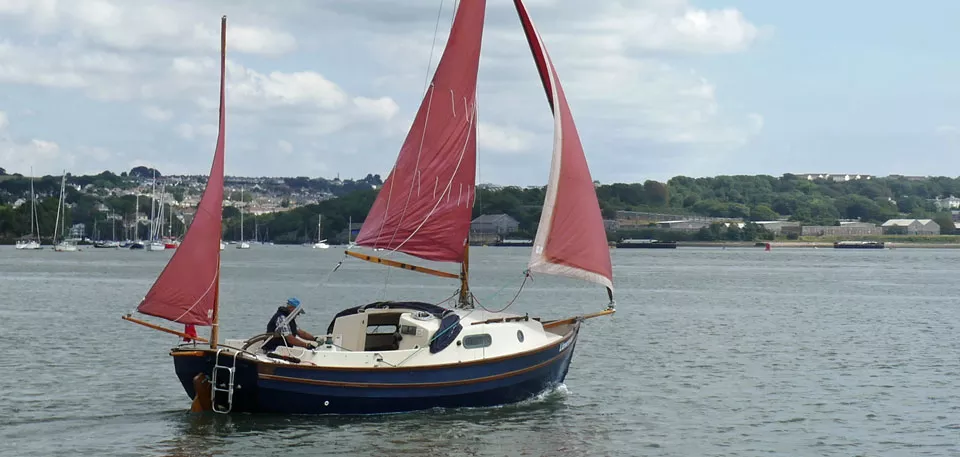
It's not about what they are; it's more about what they can deliver - simple pleasure, high adventure or genuine white-knuckle challenge.
Perhaps just a day sail on the lake or a trip along the coast.
A voyage across an ocean maybe, or even a circumnavigation of the world.
And best of all, by utilizing nature's free and sustainable energy resource - the wind.
But be warned - it's addictive. You could end up going the whole hog - getting rid of the shoreside assets, buying a suitable boat and living aboard .
But before you take that gient step, maybe you should charter a sailboat for a couple of weeks, just to be sure?
Either way, you'll find that they represent pure freedom; they're beguiling machines, sailing boats.
Take the beauty below for instance, reaching between the islands in one of the world's favourite cruising grounds - the Windward & Leeward Islands of the Caribbean .
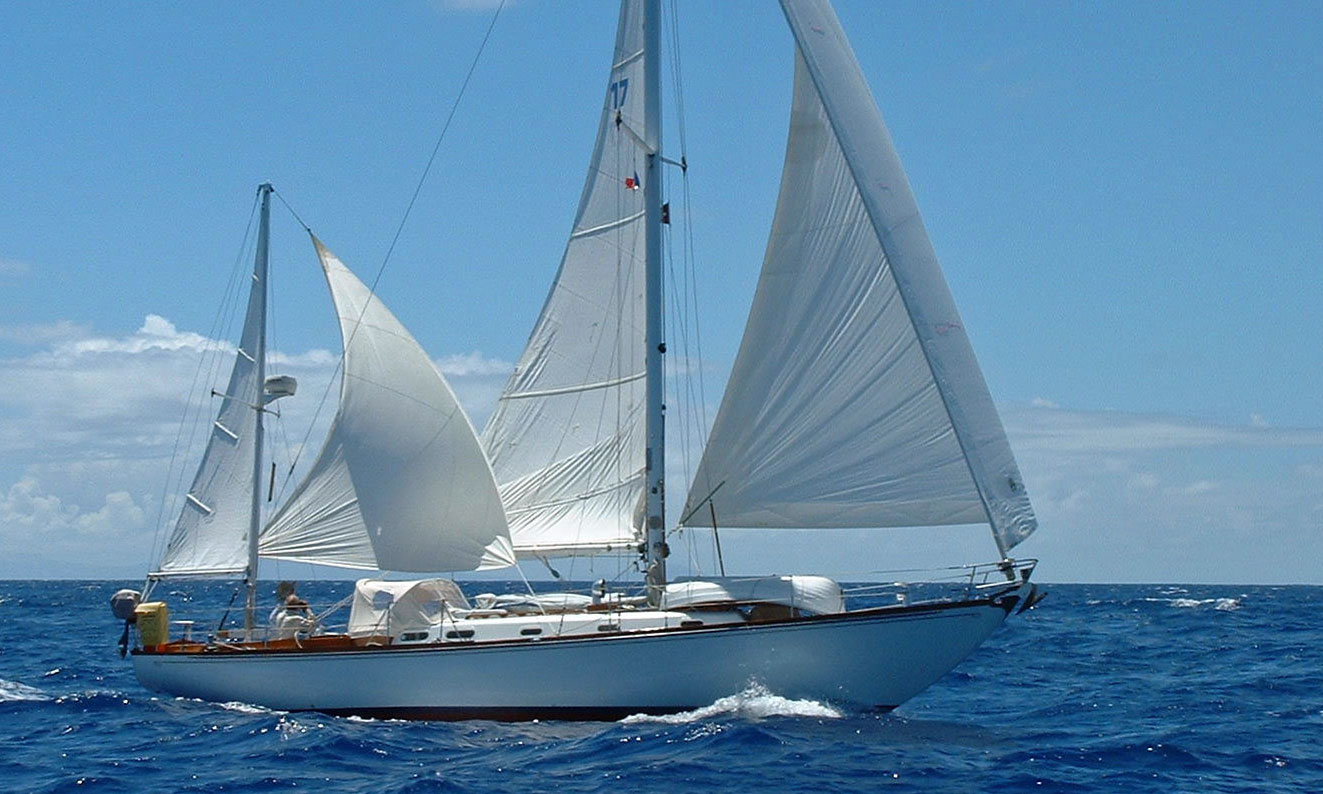
So whether you're a paid-up, certifiable sailboat fanatic familiar with all the nautical jargon and niceties of flag etiquette , or just curious about those of us who are, you're sure to find something of interest by cruising around in this website.
Who knows where you'll fetch up?
Hey, you might even start thinking about buying a sailboat of your own !
The Three Most Popular Types of Cruising Rigs...
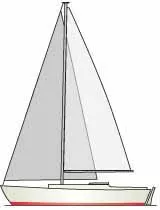
Just a headsail and a mainsail - simple and efficient.
Is the Sloop the Best Rig for Cruising?
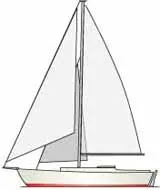
A smaller headsail and a staysail makes sail handling easier.
Why the Cutter Rig Sailboat is My First Choice for Cruising .
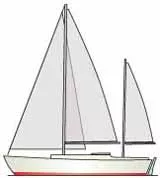
A second mast with a mizzen sail, for greater versatility.
Why the Ketch is Many Sailors' Favoured Rig for Offshore Cruising
Sailboat Rig Type Examples:
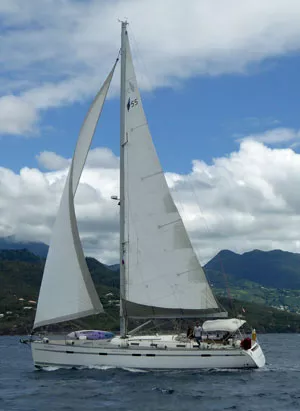
A Sailboat for Offshore Cruising
Owning a sailing boat, particularly one designed for offshore and ocean sailing , can change your life.
With a few gallons of fuel, adequate food and water aboard she'll take you thousands of miles leaving a carbon footprint in her wake that would delight the most ardent environmentalist.
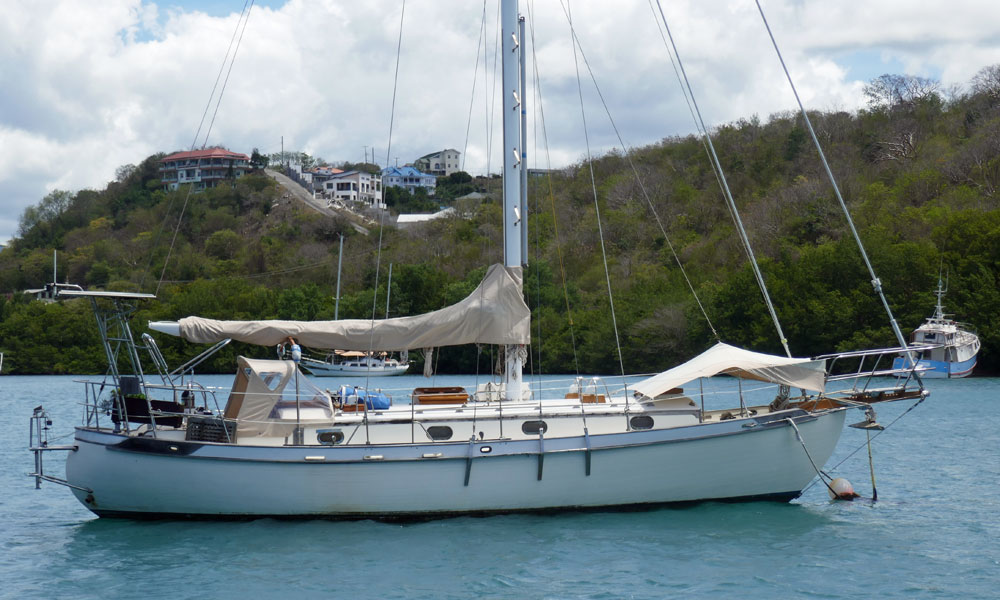
Hey, you can catch your own fish , make your own drinking water from seawate r (or collect nature's free offering with a raincatcher) and charge your batteries with a windcharger or solar panels - all without using a drop of fuel!
And you don't need to be on the helm all day - a windvane self-steering gear will keep you on the straight and narrow without drawing a single precious amp from your 12volt battery bank .
With a bluewater boat equipped in this way you could go the whole nine yards, sell your shoreside assets, cast off the shorelines together with the tedium of life ashore and set off on a cruising life of freedom and adventure.
A surprising number of people do just this, but let's not get ahead of ourselves.
Take the accommodation below decks for example. What might look very attractive at a boat show could prove to be considerably less so when in a seaway.
Take a look at the two alternative interior layouts below for instance...
Below Decks
It's here that the interior designer can recreate the appeal of a country cottage or splendor of a minor palace, often in the process making access to fixtures and fittings impossible without major surgery to the boat's interior. It's much better to follow the wise adage that 'form should follow function' and leave all the glitz and glamour to vehicles with wheels on.
The interior layout of a cruising boat is all important. Take a look at these two similar - but different - interior layout options...
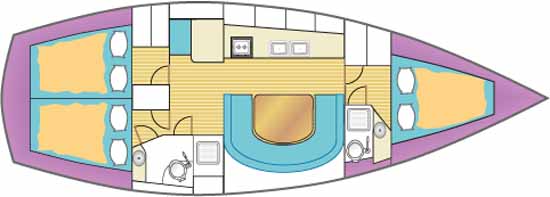
One of them is much more suitable for long-distance offshore sailing than the other.
But which one is it, and why?
This, and all other artwork on this page by Andrew Simpson
Multihulls for Cruising
So far we've only mentioned monohulls, but multihull sailboats - both catamarans and trimarans - can make good cruising boats too.
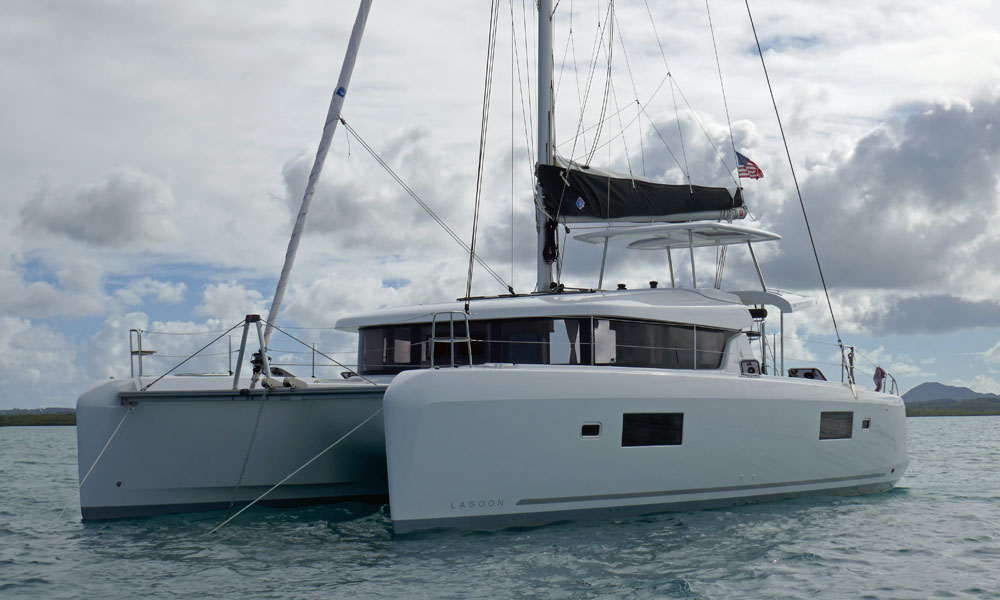
Our eBooks...
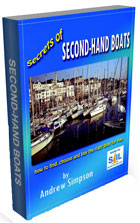
Popular Cruising Sailboats...
Our ever-growing gallery of pics, specs and key performance indicators of many popular cruising boats...
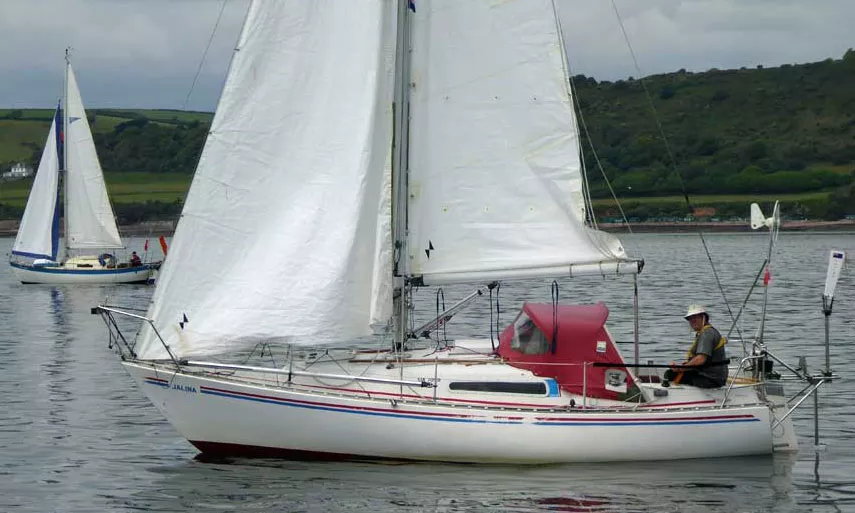
Second-hand Cruising Boats for Sale...
Just click on the images below to see the full details of these cruising boats that are advertised by their owners ( not through a broker or other 3rd party ) right here on sailboat-cruising.com ...
Latest Sailboats Offered for Sale by their Owners...
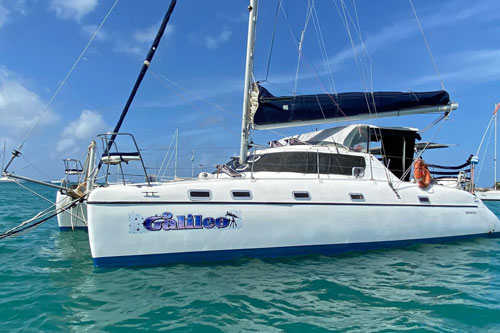
| | ; |
Used Sailing Gear for Sale:
- KVH TracVision TV6 Marine Satellite TV;
- Andersen & Barient Winches;
- Yanmar 2GM Diesel;
- Watt & Sea Cruising Hydrogenerator;
- 45lb CQR Anchor & Chain;
- Gill Foul Weather Gear;
- Yanmar Fuel Filters;
- Luff Hanked Dacron Staysail;
- Mast & Whisker Pole; Winch Handles;
- Monitor Windvane Self-Steering Gear;
- Spinlock Deckvest 150 Lifejackets & Tethers;
- Parachute Anchor;
- New Harken Triple Block;
- Galvanised Turnbuckles;
- 35lb CQR Anchor;
- MPPT Solar Charge Controller;
- AIS Transceiver;
- Airmar DST810 Speed Transducer;
- Raymarine SeaTalk Converter Kit;
- West Marine Boat Buffer;
- Yanmar 3GM30 Exhaust Elbow;
- TackTick Tactical Racing Compass;
- Imray Paper Charts; Dock Fenders;
- Mast & Standing Rigging from Oyster 54;
- EVO Boat Oven;
- Revere Offshore Liferaft;
- Lewmar 43ST Winches;
- Crewsaver 6-Person Liferaft;
- Operator Manuals for Universal Engines;
- Rutland Windcharger;
- Gill Yachting Boots;
- Helly Hanson Thermal Pants;
- AIS Class B & Chartplotter;
- Davis Echomaster Radar Reflector;
- Side-Power Thruster Upgrade Kit;
- Barient Winches;
- Taylor Made Dock Box;
- Synthetic Teak Decking for Beneteau 311;
- Lewmar Electric Anchor Windlass;
- Lofran Windlass;
- MAXX 700Watt DC to AC Inverter;
- Sailboat Stands;
- D400 Wind Generator;
- Bomar 100 Series hatch;
- Fold-Up Bikes;
- Atomic 4 Engine;
- Catalina 30 Standing Rigging Set;
- Spectra Watermaker;
- Lewmar Rope Clutches;
- 12.5 Aqua Cat Catamaran parts;
- PPG Amercoat 235 Black Resin & ABC 3 Marine Antifouling Paint;
- Raymarine Gear;
- GaleRider Drogue;
Stock images by Depositphotos
Recent Articles
A Hunter Passage 42 for Sale
Jul 16, 24 01:41 PM
The Wauquiez Centurion 40 Sailboat
Jul 15, 24 04:50 AM
The Elan 431 Sailboat
Jul 13, 24 03:03 AM
Here's where to:
- Find Used Sailboats for Sale...
- Find Used Sailing Gear for Sale...
- List your Sailboat for Sale...
- List your Used Sailing Gear...

A few of our Most Popular Pages...

Copyright © 2024 Dick McClary Sailboat-Cruising.com
Yachting Monthly
- Digital edition

The best sailing books & cruising guides of 2021
- Julia Jones
- November 3, 2021
Julia Jones reviews the latest maritime reading and picks the best sailing books, cruising guides and pilot books of 2021

What have been your favourite sailing books of 2021?
Yachting Monthly’s literary contributor Julia Jones reviews the sailing books released this year. Julia reviews hundreds of books each year for YM and here she’s selected some of the best she has read this year, from the best non-fiction sailing books, to the best practical sailing books and more.
To see the full list of Yachting Monthly’s sailing book reviews, head over to our Yachting Monthly Book Club pages.
With each book is a link. If you click on this then we may receive a small amount of money from the retailer when you purchase the item. This doesn’t affect the amount you pay.
Best sailing books of 2021, madhouse at the end of the world.
There’s a startling opening to Madhouse at the End of the World a sailing book recounting the Belgica ’s 1897-9 expedition to the Antarctic.
Frederick Cook, a doctor, serving 14 years for fraud in Leavenworth Goal, Kansas, has finished his voluntary night duty among the inmates howling from the agony of opium deprivation, when he is visited by the most famous polar explorer of this generation, Roald Amundsen.
Julian Sancton’s impressive research and incisive writing style ensures that this lockdown story grips like the pack ice.
Buy Madhouse at the End of the World from Amazon
Birth of a Solo Sailor
The most lively and unusual bluewater cruiser book that I’ve read this year.
Maik Ulmschneider’s story – or stories – begin in the autumn of 2019 when he and his partner split up in Suriname (on the north coast of South America) and he was charged with returning her two dogs safely to the USA.
Ulmschneider, from Stralsund in the Baltic, had thus become a solo sailor by default.
His energetic invitation to the reader to become part of the crew on his steel ketch Seefalke extends to chapters where the reader is offered different choices of action, before the author reveals what actually occurred.
Buy Birth of a Solo Sailor from Amazon
Island on the Edge: a life on Soay
Island on the Edge is a good read at a time when very many of us, even living on land, have needed to question our expectations.
The author arrives on Soay by fishing boat upon which island she begins a transition to a new life from her earlier life as a graphic designer in London. The book explores her extraordinary unpreparedness for life on a small island with (then) only a handful of residents.
She had no idea of the practicalities of living outside the social infrastructure of utility supply, communications, consumer goods – and regular income.
Were it not for the kindness of her neighbours she is clear that she would not have survived.
The population of Soay has fallen during Anne Cholawo’s life there. She is now one of only three permanent inhabitants.
Buy Island on the Edge: a life on Soay from Amazon
Life on Board Medway Queen
This slim 28-page booklet is the latest from the worthwhile Medway Queen Preservation Society.
It’s a treat for social history enthusiasts as it offers first-hand accounts from two men who joined Paddle Steamer Medway Queen in the immediate post-war period when she was back to work as an excursion steamer.
Buy HMS Medway Queen: Memories of Dunkirk from eBay
Farewell Mr Puffin
Farewell Mr Puffin describes a voyage north – sometimes solo, other times with crew – which Paul Heiney made in the Brexit referendum summer of 2016.
It took him from Suffolk to Iceland where Wild Song over-wintered at Reykjavik. Then they ventured further to cross the Arctic Circle.
As Heiney sets off up the British East Coast, visiting ports such as Blyth, Peterhead and Wick, he’s inspired by the idea of North, the anticipated tang of that pure cold air and the sense of following in the wake of past fishermen.
Buy Farewell Mr Puffin from Amazon
The Backside of Normal: a sailing life of adventure
If your starting point is Los Angeles then your cruising ground is immediately the Pacific.
Roger Olson’s first expeditions took him to Catalina Island and down the coast of Mexico.
An unexpected divorce in his 30s kickstarted a reappraisal of his life and its priorities. Soon he was setting out for the Marquesas and beyond.
The Backside of Normal: a sailing life of adventure, written aged 80 gives an account of what he experienced and discovered.
Buy The Backside of Normal: a sailing life of adventure from Amazon
Best sailing skills books
The practical guide to celestial navigation.
The word ‘Practical’ in this book’s title is a good one.
There are those with fine-tuned minds who love celestial navigation for its own sake; for the intellectual beauty of its concepts and the sense of being at one with the structure of this universe and beyond.
There are others (like the present writer) who feel a headache approaching at the very sight of astro-navigation tables so hurry to deny its necessity in the new happy world of GPS .
Phil Somerville leads the reader in gently, pointing out the electronic drain of GPS on the systems of an ocean-going yacht and also its vulnerability, both to electronic failure and to malice.
Buy The Practical Guide to Celestial Navigation from Amazon
The Book of Knots
Most yachtsmen value knots for their practical utility.
This book sorts them by construction and typing method rather than function. Its sections therefore are bends, loops, hitches, lashings, coils, stoppers and whippings.
I wasn’t sure I wanted to know how to tie a Hangman’s Noose though the knot histories are interesting.
I suppose if one had failed to master the Highwayman’s Hitch (for a quick getaway) then one might well discover the special qualities of Jack Ketch’s knot ‘designed to withstand a heavy shock-loading in rope’. These days its use is for fishermen.
This book makes the reader aware of a community of knotting web masters who ‘represent every kind of knot application, from the basic to the bizarre.’
Buy The Book of Knots from Google Play
Imray Explorer Guides: Tides, Tidal Streams, The Moon
These three small booklets represent an interesting new ‘explainer’ approach.
A very few concepts are introduced in each booklet with infographics, links to download and construct simple paper models, calculation pages and (most important) clues to lookout for in the real world.
The three booklets are closely linked by both style and content, with a significant amount of repetition being used to ensure that connections are made.
While readers may wonder at this use of paper, teachers will recognise an essential technique. It also means that the books can be read in any order.
Buy Imray Explorer Guides: Tides from Imray
Buy Imray Explorer Guides: Tidal Streams from Imray
Buy Imray Explorer Guides: The Moon from Imray
Best cruising guides and pilot books
Reeds 9 language handbook.
The Reeds 9 Language Handbook may not have been flying off the shelves during the Covid pandemic, but for anyone with aspirations ever to cruise beyond UK waters again, I’d suggest it’s a must-have.
This pocket-sized volume contains specific boat-related vocabulary in French, Danish, Dutch, German Spanish, Italian, Portuguese and Greek.
It’s very well thought out, being divided into sections relating to the boat, ‘Under Way’ (this includes harbour formalities), maintenance and repairs, emergencies.
Buy Reeds 9 Language Handbook from Amazon
North Brittany and Channel Islands Cruising Companion
The North Brittany and Channel Islands Cruising Companion is a sailing book that epitomises the best qualities of a cruising companion.
It’s thorough, well-informed, full of good suggestions and possesses the invaluable quality of intensifying enjoyment without bossily directing it.
It covers the area from Cherbourg and the Contenin peninsula to Ushant and the harbours of the Chenal du Four.
An example of unexpectedness is the reminder that Ushant / Ile d’Ouessant is more than an iconic seamark, it’s also a community which, if you have time and the weather is settled you might visit.
Buy North Brittany and Channel Islands Cruising Companion from Amazon
The Canal Guide: Britain’s 55 best canals
I’d love to see the author of The Canal Guide: Britain’s 55 best canals, Stuart Fisher, on Mastermind:
His apparently effortless outpouring of information on matters far removed from his specialist subject of Britain’s canals would surely make him unbeatable in the general knowledge rounds.
As previously in his excellent guides to Coastal Britain (two volumes – England and Scotland) the reader is treated to a scintillating riff of facts – about plants, pubs, history, literature, film sets, architecture, place names as well as the detail of canal history and engineering.
There’s not a dull page in the book.
Buy The Canal Guide: Britain’s 55 best canals from Amazon
Enjoyed reading this?
A subscription to Yachting Monthly magazine costs around 40% less than the cover price .
Print and digital editions are available through Magazines Direct – where you can also find the latest deals .
YM is packed with information to help you get the most from your time on the water.
- Take your seamanship to the next level with tips, advice and skills from our experts
- Impartial in-depth reviews of the latest yachts and equipment
- Cruising guides to help you reach those dream destinations
Follow us on Facebook , Twitter and Instagram.
Save 40% off! Join our newsletter and get 40% off right away!
Sailboat Life
Sailboat Cruising and Lifestyle Magazine.

World Cruising Routes and Voyage Planner

Planning an ocean voyage on a sailboat requires careful preparation and research. You need to consider factors such as the route, the weather, the equipment, the crew, the budget, and the safety measures. Here are two resources you can’t go without.
World Cruising Routes
World Cruising Routes is the go-to guidebook for long-distance navigators, cruisers, and sailors. It contains over 1,000 routes to destinations all over the globe rich with essential weather information, waypoints, and advice for safe passage making.

“Some routes start as a dream and end as a nightmare.” The first sentence in World Cruising Routes sets the stage for the rest of the book – how to plan your routes for successful passages. The contents include:
- Winds and currents of each major ocean and sea.
- Routes in the Atlantic Ocean are divided into North Atlantic, transequatorial routes, and South Atlantic.
- Routes in the Pacific Ocean are divided into North Pacific, far east, transequatorial, and South Pacific.
- Routes of the Indian Ocean are divided into North Atlantic, transequatorial, and South Indian Ocean.
- Routes in the Red Sea and the Mediterranean Sea.
World Voyage Planner
This book is a comprehensive strategy and informational guide for planning a voyage. It takes the sailor from any port to wherever they’d like to go.

The contents of World Voyage Planner includes:
- World Weather Patterns Month by Month, Ocean by Ocean
- Planning an Ocean Voyage to the Caribbean from different continents
- Routes to the Mediterranean Sea from All Major Ports in the World
- Planning Voyages to North America and Northern Europe
- How to Sail to South America and Antarctica
- Voyage planning to South Africa
- Circumnavigations of various Oceans and Sea
- Pacific Routes to Fiji, Mexico, Asia, Australia, and Other Destinations
- Route planning in the Indian Ocean
- And an Entire Section on Global Circumnavigation
The book is designed to guide the sailor in planning large voyages. It’s meant to be a companion to the World Cruising Routes .
Preview the contents of Word Voyage Planner and purchasing options on Amazon.
Share this post!
Throw in your two cents, start a discussion cancel reply, related articles.

The Voyage of the Sea Star – 35ft Sloop to Bermuda

Living Aboard a 30-36ft Sailboat: A Guide for the Curious and Adventurous

Summer Sailboat Video, Bikinis, Sails, and Fun

Saved Up For This Dream
- Yachting World
- Digital Edition

Atlantic Intracoastal Waterway: everything you need to know
- May 30, 2022
Peter Nielsen brings you this guide to cruising the Atlantic Intracoastal Waterway (ICW), or as it is more widely known, 'The Ditch'

Perhaps you’ve cruised the Caribbean and fancy heading up the east coast of the United States to sample the fine cruising grounds of the Chesapeake Bay or New England. Or perhaps you’re a Canadian sailor itching to escape the brutal northern winter. Either way, you will become acquainted with the Atlantic Intracoastal Waterway (ICW).
The ICW – or ‘The Ditch’, as it is affectionately known by many – stretches 1,088 miles (statute, not nautical) from Mile Marker 1 in Norfolk, Virginia, to its end point in Key West. It is part of a 3,000-mile series of interconnected waterways that can take you all the way from Virginia to Texas.
On the east coast, the Atlantic Intracoastal Waterway is a busy highway in the autumn and spring. The snowbirds flock south in the fall, gathering on the Chesapeake to head south after the Annapolis Boat Show in October and get to Florida as the hurricane season ends in late November. In the spring, there’s a procession of boats heading back to the Chesapeake or downeast to Maine.
American sailors have something of a love-hate relationship with the Atlantic Intracoastal Waterway. On the one hand they deplore the need to motor the best part of 1,000 miles when they could be sailing; on the other, they welcome the many opportunities to duck into shelter from threatening weather. The majority of cruisers taking the offshore option will, for instance, happily nip into the ICW to avoid rounding the notorious Cape Hatteras.
Before I actually went down the ICW for the first time, I did not think of it as a cruising destination in its own right. ‘The Ditch’ sounded far from appealing to this deepwater sailor. Yet over the course of three forays down various parts of the waterway, I began to enjoy it for its own sake. Yes, you will be plugging along under power for many miles, but you will also pass through some beautiful scenery and visit parts of the country that typical tourists would never get to see.
Sailing the Atlantic Intracoastal Waterway
You’ll also get to sail some, notably on the Albemarle and Pamlico sounds, though there are many other places where you can unroll the genoa to get a break from the engine. My favourite parts are the northern section, from Norfolk, Virginia, down to Beaufort, North Carolina, and farther south to Charleston, South Carolina.
On my first excursion I motored slowly down the historic, 22-mile-long Dismal Swamp Canal, dug by slave labour in the late 18th century as a trade route. Its inky black water, infused with tannin from the swamp vegetation, left a brown moustache on our bow. Our spreaders grazed overhanging branches and our 6ft 3in keel bounced over the shallows.
It was a unique experience, followed by a gorgeous cruise along a winding tree-lined river to a welcoming town called Belhaven, where we tied up to the free dock and a friendly local drove us to the supermarket. From there, we set sail at first light in a solid blow, bouncing across a choppy Albemarle Sound, and made 80 miles before dark. Such are the contrasts of the ICW.
There are some pretty towns and cities that warrant a few days’ exploration, for anyone not in delivery mode. Some are famous, some you’ve likely not heard of.

Lighthouse and pier at Manteo, North Carolina. Photo: Matt Claiborne/Alamy
In Norfolk, Virginia, you can marvel at the sight of a good chunk of the US Navy lined up almost gunwale to gunwale along the riverbank; deceptively sleepy Oriental, North Carolina, is home to two good boatyards; while the two Beauforts, ‘Bowfort’ in North Carolina and ‘Bewfort’ in South Carolina, are charming stopovers.
Charleston, also in South Carolina, is an almost mandatory stop, as is Savannah in Georgia. Many cruisers get as far as St Augustine and decide to stop there for a spell. To me, it’s the best town on Florida’s east coast.
As you motor farther south, things get busy. Above the Keys, the Florida coast lacks the charm of the Carolinas or Georgia, and so does the ICW. It’s here that, if there’s a northerly component to the wind, the temptation to hop outside (but stay west of the Gulf Stream) and make some fast miles away from bridges and currents becomes overpowering.
Sure, there are a couple of nice towns to stop at for a while – Vero Beach and Stuart, for example, and it would be a shame to steam past Cape Canaveral without a tour of the space centre – but generally speaking it’s a dull run, and the farther south you go, the more congested the waterway becomes.
Down around Fort Pierce, a good many sailing crews split off and head across to the Bahamas, while others head down as far as Fort Lauderdale. However, I’d recommend going outside well before you get too far south, or at least do not travel on a weekend; as it’s here that the boat traffic gets hellish.

The Intracoastal Waterway is spanned by 160 bridges. Photo: Peter Neilsen
The Atlantic Intracoastal Waterway can become chockablock with all manner of overpowered and under-piloted watercraft, a celebration of horsepower and inebriation, all zooming around willy-nilly. I stayed in the waterway a little too long last year, and being trapped in tight quarters amid so many powerboats was downright frightening at times.
There’s a bridge with only 56ft clearance just before you get to Miami, so most sailing boats have to go into the Atlantic at Fort Lauderdale and back into Miami at Government Cut.
For many, Miami marks the end of the Atlantic Intracoastal Waterway; it’s an easy staging point for the Bahamas. The ICW continues down to the Florida Keys and then up and around the Gulf of Mexico, but most east coast cruisers, and most foreign vessels, either break off and head towards the western Caribbean, or go to the Bahamas and perhaps south to the Eastern Caribbean.
One of the first things the bluewater sailor will notice about the ICW is the sheer number of bridges. There are some 160 between Hampton and Miami. Most of them are fixed bridges, all built to a vertical clearance of 65ft (20m) above the high-water mark. Supposedly built to that height, anyway.
Mind the gap
During my foray down part of the Florida ICW on a catamaran with a 63ft (19.2m) air draught, we lost the masthead wind transducer on one bridge and nervously watched the VHF antenna scraping the underneath of several more. This is nerve-wracking if you have some current with you and are effectively committed, watching the height boards at the centre span and hoping they aren’t lying.

Entrance to the ICW at Fort Pierce, Florida. Photo: Stephen Wood/Alamy
Then there are the opening bridges, which relieve you of height concerns but offer some challenges of their own. Some are bascule bridges, others have a span swinging sideways to open the path for water traffic, others have lifting spans. The latter are usually found in populated areas, or where topography precludes a fixed bridge.
Some will open on demand, the etiquette for which involves a call on Ch13 or Ch9 and a usually pleasant interaction with the bridgekeeper. Others open to a timetable, usually on the half hour. This leads to plenty of strategising, as you either hurry to get to the next bridge in time to avoid milling around with a bunch of other boats waiting for the next opening, or slow down so you don’t get there too soon. What’s more, many of the metropolitan bridges don’t open at all during morning and evening rush hours. Diligent study of bridge locations and timetables will ease your passage along the ICW.
The further south you get, the more bridges you will encounter, peaking in heavily populated southern Florida. The only three locks you’ll encounter are all in Virginia, and they’re easy enough to negotiate.
Overnighting
Depending on your draught, there are plenty of places to anchor for the night along the ICW, and no shortage of town docks and marinas, though these often fill up quickly from mid-October to December and April through May.

ICW at Fort Lauderdale. Photo: Patrick Lynch/Alamy
I’ve stayed for free, or nearly so, at docks in small but welcoming towns along the waterway, and enjoyed hot showers and restaurant meals in marinas, but most of all I have enjoyed the many lovely anchorages I’ve discovered.
Often, an overnight stop is as easy as pulling a few boat lengths off the channel, depth permitting, and dropping the hook. The various guides to the ICW will point out the best spots. One October we pulled over to a tiny dock on the Dismal Swamp Canal and shivered in our blankets as the temperature dropped close to freezing on the stillest of nights; next day we were in shorts and T-shirts again.
Another time, just north of St Augustine in Florida, we sat on deck with gin and tonics and watched an hours-long lightning show play out in the clouds, happy not to be underneath it. And on one occasion, anchored in a cut leading out into the Atlantic, I paced the deck nervously as the wind pushed the boat one way and the current another, the anchor chain stretching bar-taut astern. In some places you may want to double up on your anchors, or drop a kellett from the bow to make sure your anchor chain doesn’t foul your keel or running gear.
I also recall sitting out a late November north-easterly in Beaufort, North Carolina, where the boat heeled in her berth to 50-knot gusts while we sat in a bar eating boiled oysters, feeling relieved to be in a marina.

Beaufort, South Carolina. Among the best parts of the ICW are the 200 miles north of here. Photo: John Wollwerth/Alamy
Luckily, such blows are well forecast and there’s really no excuse for being caught out in one. They also remind you why you’re in the ICW instead of out at sea at that time of year. During that same passage south, we left Morehead City, North Carolina, bound for Charleston, only to catch a forecast that made us duck back into the ICW at Wrightsville Beach. That night, snug at anchor, we listened to the wind howling in the rigging while 20 miles offshore, about where we’d have been, a new Beneteau 50 was dismasted and its crew rescued by helicopter.
Navigating the Atlantic Intracoastal Waterway
Make no mistake, the ICW is shallow. The US Army Corps of Engineers tries to maintain the depth to 9ft (2.7m), but given the nature of the waterway, with its often strong currents, things aren’t always the way they’re supposed to be. I’ve run aground several times, but only once with any damage. On the other hand, some friends went the length of the waterway without a functioning depth sounder and never once touched bottom.
I used Navionics charts on my iPad on each of my ICW trips and never had any issues. Although some commercial traffic does run at night, it would be foolhardy for us sailors to do the same. It would be all too easy to misjudge a turn and end up with your keel stuck in the mud.

Draw bridge over the Intracoastal Waterway at Great Bridge, Chesapeake, Virginia. Photo: Cindy Hopkins/Alamy
The navigation marks are all well kept, and follow American red-right-returning protocol, return being southbound on the east coast.
Channel markers can become confusing where channels from seaward intersect with the ICW, so there’s a simple system of reflective yellow squares and triangles superimposed on the nav aids; leave the triangles to starboard, the squares to port. If the nav aids don’t have the yellow marks, you’ve left the ICW.
Dealing with traffic
At least until you get to the chaos of south Florida, boat traffic on the waterway is easy enough to deal with. Faster boats wanting to pass should hail you via VHF. If you’re feeling generous you can slow down to let them pass faster, which is sensible, for you don’t know what’s coming your way around the next bend.
We sailors are slower than most other traffic, so we get passed often. Most powerboaters will slow down as they pass so as not to ‘wake’ you. There are some exceptions, notably big sport fishing boats with professional crews who delight in steaming past at full speed.
It can get crowded at bridges, so my advice is to hang back and let the nimbler powerboats go first.
Planning an Atlantic Intracoastal Waterway passage
There is lots of literature about the ICW, most of it hard pilotage advice, which is as it should be. If you want some entertaining reading, try The Boy, Me and the Cat , by Henry Plummer, a fun tale of a cruise up the ICW in a small catboat in 1912.
Otherwise, here are some useful books and websites:
The Intracoastal Waterway, Norfolk to Miami – The Complete Cockpit Cruising Guide , by Bill Moeller/John Kettlewell. Waterway Guide Atlantic ICW , by Waterway Guide Media (updated annually). 2021 ICW Cruising Guide , by Bob423.
Many cruisers swear by Bob423’s frequently updated online guides and paperback books. Bob has travelled the ICW for many years and few know it better. His blog is at bobicw.blogspot.com
You’ll spend a lot of time obsessing about bridges and their opening times; the Waterway Guide website and Bob423’s blog are good sources of up-to-date info.
On my ICW excursions, I have exclusively used Navionics charts on iPad and phone, with C-Map charts on the plotter as a backup. I have been happy with the accuracy and functionality of the Navionics charts. Many cruisers also swear by Aquamaps.
Note: We may earn a commission when you buy through links on our site, at no extra cost to you. This doesn’t affect our editorial independence.
If you enjoyed this…..
Yachting World is the world’s leading magazine for bluewater cruisers and offshore sailors. Every month we have inspirational adventures and practical features to help you realise your sailing dreams. Build your knowledge with a subscription delivered to your door. See our latest offers and save at least 30% off the cover price.
- New Sailboats
- Sailboats 21-30ft
- Sailboats 31-35ft
- Sailboats 36-40ft
- Sailboats Over 40ft
- Sailboats Under 21feet
- used_sailboats
- Apps and Computer Programs
- Communications
- Fishfinders
- Handheld Electronics
- Plotters MFDS Rradar
- Wind, Speed & Depth Instruments
- Anchoring Mooring
- Running Rigging
- Sails Canvas
- Standing Rigging
- Diesel Engines
- Off Grid Energy
- Cleaning Waxing
- DIY Projects
- Repair, Tools & Materials
- Spare Parts
- Tools & Gadgets
- Cabin Comfort
- Ventilation
- Footwear Apparel
- Foul Weather Gear
- Mailport & PS Advisor
- Inside Practical Sailor Blog
- Activate My Web Access
- Reset Password
- Customer Service

- Free Newsletter

Marshall Sanderling 18: Used Boat Review
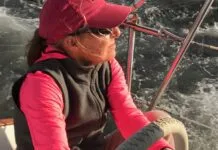
Affordable Cruising Sailboats, Continued

Maine Cat 41 Used Boat Review

CS 30 Used Boat Review

Best Crimpers and Strippers for Fixing Marine Electrical Connectors

Thinking Through a Solar Power Installation

How Does the Gulf Stream Influence our Weather?

Can You Run a Marine Air-Conditioner on Battery Power?
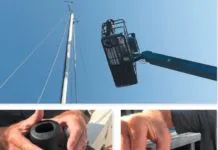
Need a New Headsail Furler? Here’s What’s Involved

Master the Sailing Basics: Never Stop Learning the Little Things
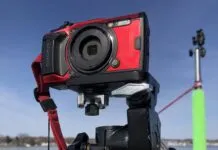
How to Mount Your Camera on Deck: Record Your Adventures with…

Un-Stepping the Mast for America’s Great Loop

Sinking? Check Your Stuffing Box

The Rain Catcher’s Guide

How to Change Your Engine Mounts

Keeping Water Clean and Fresh

Vinyl Boat Lettering DIY Application and Repair

Those Extras you Don’t Need But Love to Have

Three-Model BBQ Test
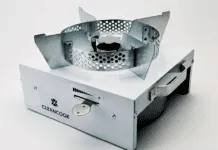
Alcohol Stoves— Swan Song or Rebirth?

UV Clothing: Is It Worth the Hype?

Preparing Yourself for Solo Sailing

How to Select Crew for a Passage or Delivery

Preparing A Boat to Sail Solo

Dear Readers

Chafe Protection for Dock Lines

Waxing and Polishing Your Boat

Reducing Engine Room Noise

Tricks and Tips to Forming Do-it-yourself Rigging Terminals
Coastal cruising guides, a capable cruising guide can make the difference between anxiety and confidence while sailing. it can make shoreside chores efficient, and even provide good bunk reading by lamplight while the winds whistle. not all of these capabilities exist in the same book, however..
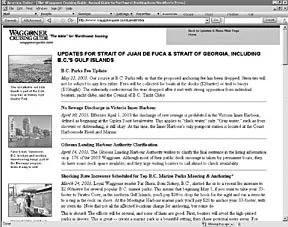
Most sailors find entering a new harbor adventurous, and it is. However, most of us also find it, at best, a jaw clamper. Especially at night. And if the weather is terrible, it can equate to a kidney stone. However, good charts, careful piloting, and a GPS receiver will bring you safely into the harbor.

It beats how it was done in 1609 by the intrepid Englishman, Henry Hudson, who for three weeks had to feel his way in the shallow-draft Half Moon to explore the river he claimed for the Dutch (he was sailing for the Dutch East India Company).
But after you get into the harbor, where’s the designated anchorage or marina? Where do you buy fuel? Where’s the dinghy dock? And how about the hula dancers? The answers aren’t in your GPS or chart plotter.
What you need is a cruising guide, and if you had one, you’d have enjoyed reading it the night before and fortifying yourself with facts, figures, and just the right array of local knowledge wherewith to astound and gratify your crew—thus possibly saving yourself the fate of Henry Hudson, who was abandoned at sea by a mutinous crew in 1611.
A good cruising guide is worth its weight in gold. A lousy one is a waste of money, and sometimes even dangerous. To help you get the most of your cruising kitty dollar, we collected as many guides as possible covering coastal US waters (not the Virgin Islands and other more faraway places, though to be sure, there are cruising guides to just about every sailable area of the world, including the oceans proper). We’ve used many of these books ourselves.
Like chart kits (reviewed in the May 15 issue), cruising guides have popped up in ever-increasing numbers in the last two or three decades, and there’s enough cross-over in material between the two types to make the distinction fuzzy in many cases.
Once that distinction is made, however, you could say that there are two approaches to the coastal guide. The first is the annually updated, advertising-supported guide written by a flotilla of hired guns and compiled and edited by the publishers’ expert minions. What such books give up in terms of personality and continuity of narrative, they make up for in up-to-the-year information, including harbor changes and those wrought by Mother Nature as well as who’s selling what at which marina.
The second major class is the niche guide, written, usually, by an individual or cruising couple and published either by a conventional commercial publisher, or self-published (by what is known generically as a “vanity press,” which means that you pay a printer to do up your book, and you sell it). What this type of guide lacks in up-to-date harbor information, it often makes up for with anecdotal information on history, flora and fauna, and where, in Little Current, Ontario, in the North Channel, you can buy a home-made blueberry pie. These are almost always labors of love, with little chance of making much of a buck, and usually project personal styles that make them eminently readable.
It’s up to you: Do you want a lot of information, including commercial stuff that is frequently valuable (like restaurants, local diesel repair facilities, laundromats, etc.) or do you enjoy local history, whimsy, and the sights ashore? Both types are valuable, but your investment—in money and bookshelf space—is bound to increase accordingly.
Let’s take a look at coastal cruising guides, beginning in New England but not ignoring the southern, western, and thalassic waters.
In the Beginning… In 1937, Robert F. Duncan and Fessenden Blanchard wrote the first edition of A Cruising Guide to the New England Coast. Long considered the one indispensable guide, it now displays as authors Duncan’s grandson, Robert C.; his great grandson, Roger S. plus W. Wallace Fenn and his son, Paul W. Fenn, currently head of Jeanneau America.
With over 800 pages, it once was $30, but now sells for $50. The publisher, once Dodd, Mead & Co., then G.P. Putnam, is now W.W. Norton & Co. The book is thorough, textually covering everything from the coast of New Brunswick, down around and up Henry Hudson’s river.
Now…Roger F. Duncan, son of Robert F., father of Robert C., grandfather of Roger S., and co-author, with John Ware (Blanchard’s son-in-law), of many editions of the guide, is also the founding editor of Practical Sailor. We hope it will not sound ungratious if we say that for practical purposes, there are better databases and formats (layouts) to choose from among today’s guides. There is very good information in the book—including some fine, detailed history—but over the years we’ve found ourselves using the book only a little for piloting and decision-making. It has a goodly number of high-altitude black and white aerials, fewer charts, and much text that bears linguistic semblance to a dry martini, best read while sipping one at anchor.
This 66-year-old book is in its 12th edition, including a big overhaul in 2002, and the story of Captain Phillips and the schooner Little Mary, quoted in successive editions of the book (starting on page 361 of the current edition), is worth the entire price of admission.
A newer book of the same genre—meaning heavy on copy, light on the pictures—is John E. McKelvy, Jr.’s Cruising Guide to the Nova Scotia Coast. Carrying the imprimaturs of both the staid Cruising Club of America and the Royal Nova Scotia Yacht Squadron, the ring-binder book is the primary guide for the Canadian Maritimes. Rather like the Great Lakes Cruising Club guides (which are superb), the McKelvy book is updated biennially, with contributions from other sailors. Now in a third edition (not counting updates) the book sells for $45. It’s carried by The Armchair Sailor bookstore and by Landfall Navigation. See contact information at the end of this article.
Another New England guide is the Atlantic Cruising Club’s Guide to New England Marinas, compiled, written and edited by Elizabeth and Richard Smith, and published by Jerawyn Publishing. Now in its seventh edition, the perfect-bound, 8.5″ x 11″ book divides New England from Bar Harbor, ME to Block Island, RI into 12 sub-regions and includes 230 “Marina Reports” in a straightforward, standard format (one marina per page) with no advertising. It comes with a CD-ROM that includes a searchable database of all the marina reports, plus “up to nine full-color photographs of each facility.” The whole package costs $25, and the Smiths, via their Atlantic Cruising Club, have plans to increase their coverage southward by leaps. This is a very good effort for a very good price. We’ll look forward to the expanded coastal coverage.
The Big Boys Ten years after Duncan the First, there came the first edition of the Waterway Guide (Northern Edition, 422 8.5″ x 11″ pages, once $30, now $37 (which is a modest price increase over the years). The company has changed hands at least nine times since 1947 and did so again last September, moving for the sixth time (from Atlanta, GA, to Annapolis, MD, where it was in the first place). Walter Cronkite’s “most trusted man in America” face appeared in 1992 on one whole year’s set of these regional guides.
Waterway Guide was the first, to our knowledge, to give marina listings for each major harbor. A handy grid format is used, indicating such things as number of slips, dockside depth, fuel, electrical service, availability of repairs and pump-out stations, etc., all keyed to charts to make them easy to find.
Cruising directions are far briefer than in the above-mentioned Duncan book, but the basics are there, enough to get you from A to B, even if you don’t get the anecdotes and historical tidbits that make the Duncan work a good readin’ book. Instead, the Waterway Guide serves up heap of advertising.
The Waterway Guides come in three flavors—the Northern edition (Canadian border to Delaware Bay); Mid-Atlantic (the Chesapeake Bay to the Florida border), and the Southern edition (Florida to the Mexican border). The last is a sort of wrap-around southeastern U.S., including the Bahamas, that goes all the way to Brownsville, Texas. The Mid-Atlantic and Southern books cover the ICW down to and through Florida. They are good buys.
Quite a few years after the first Waterway Guide came out, the choice became complicated by the entry of Embassy Marine Publishing’s Complete Boating Guides. The first editions were Rhode Island & Massachusetts (434 8.5″ x 11″ pages, and Long Island Sound (425 8.5″ x 11″ pages, now $45, each.
The Embassy books, loaded with nautical information (and advertising) are excellent, with many harbor charts reproduced in full color. Marina listings and cruising directions were slightly cleaner and more attractive than those in the Waterway Guide.
In addition, the Embassy books had a spiral binding, while the Waterway guides were for years what is called “perfect bound.” Although far more expensive, a spiral binding allows the open book to lie flat.
One shortcoming of the Embassy books was that the popular New England version did not include Maine, whose waters are very popular. Embassy attempted to remedy the situation by doing a separate Maine edition, which we note is for sale this year at a greatly discounted price. (It also has now an Atlantic Coast, Maine to Florida, edition.)
After its initial offering was well accepted, Embassy expanded with additional editions and became so successful that Maptech (the electronic cartography company often mentioned in these pages) bought the whole line, which includes, besides the above two, Atlantic Coast, Maine to Florida ($45); Maine Coast ($20); Chesapeake Bay ($20); Florida ($45); The Bahamas ($45), and the New York State Canal System ($25).
Facing fierce competition from Embassy, Jack Dozier, Waterway Guides’ new owner, set in motion a complete overhaul of the Waterway Guide books, including converting to the spiral binding. (Dozier owns a couple of Rappahannock River marinas, down there where Washington put it to Cornwallis.)
The Maptech people may not like it, but the 2003 editions of Dozier’s Waterway Guides strongly resemble the Embassy books, even to the back-cover fold-in page marker. It was a format worth imitating, helpful to sailors using the books, although it makes the choice between the two impossible on any other than detailed personal preference.
Southward If anyone has a well-deserved lock on Florida, it’s Frank Papy, with his Cruising Guide to the Florida Keys (including a Florida West Coast supplement), now in a revised 11th edition. Charterers in the area will be familiar with Papy’s book, because it’s provided on board charter boats by companies like Florida Yacht Charters and Sales and The Moorings. Text blocks are short and to the point, and accompanied by excellent aerial photos and harbor and approach charts. Trim size is 8.5″ x 5.5″, with a plastic comb binding.
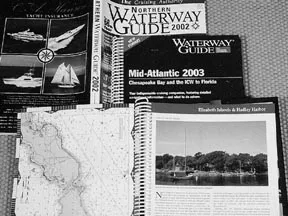
Papy doesn’t try to cover every harbor and inlet—he concentrates on the ones that are reasonably simple and safe to get into with a moderate draft. (This may be one reason he’s in favor with the charter companies.) The book is a true bargain at $20.
We should note that although his Florida Keys book is businesslike, Capt. Papy has a considerable flair for story and anecdote, some of which he recently published in a book called Impressions, Ideas, Deeds.
The publishers of Papy’s Florida Keys book, Cruising Guide Publications, produce a slew of other books covering Florida and the Caribbean.
Another recent book, published by the Dodge family, is called Inlet ChartBook: Southeastern United States (White Sound Press). Anyone who’s had difficulty “running the bar” will want this $20 book, which covers 32 important “non-commercial” inlets from the Chesapeake Bay to Miami. A non-commercial inlet is one that the NOAA deems not for big ships, and thus is “grayed out” and cryptically dismissed by “Local knowledge is needed,” or, even nastier, “Shoaling reported.” The book includes beautiful modified NOAA charts and aerial photos, made understandable by water color or taken when the wind was creating whitecaps that clearly show where not to go. If you think you’re really good at crossing the bar, you might try St. Helena Sound in South Carolina. Most cruising guides blow right by it.
The Dodges also publish The Cruising Guide to Abaco Bahamas, through White Sound Press, also for $20.
The West Coast There’s no sweeping equivalent Embassy/Waterway Guide competition on the West Coast, which runs for considerable stretches without a single decent harbor to put into. Consequently, the guide books—and there are many, many of them—cover much more specific locales.
One of several exceptions to the above generalization are the four Pacific Boating Almanacs. All $30, the editions are The Pacific Northwest & Alaska; The Pacific Northwest; Northern California and the Delta, and Southern California & Mexico.
The Pacific Almanac books are printed and sold by Prostar Publishing of Annapolis, MD and Culver City, CA.
These almanacs are 6″ x 9″, soft-covered books that contain a lot of government information about tide and tidal currents; coastal piloting and navigation; weather; first aid, etc. There are brief harbor descriptions in prose and there are almost no maps or photos. They are not for gunkholers. There’s only a little advertising, in the front and back.
Prostar also publishes four Atlantic almanacs, a Gulf of Mexico almanac, and cruising guides to California’s Channel Islands, the Sea of Cortez, and the Colorado River.
Another exception is The Cruising Guide to Central and Southern California ($30), by Brian Fagan, an author/sailor known widely on the West Coast. His book, which came out in 2001, is a combination of three earlier guides (two published, one planned) for waters south of San Francisco, which were not in those earlier times much frequented by yachts. The area is now a well-sailed thoroughfare. Fagan’s publisher this time is International Marine (which is owned by McGraw- Hill), the nation’s most prominent nautical book publisher.
The 372-page Fagan book, instead of being the mass of merely practical information often packed in a cruising guide, resembles the Duncan book. On page three Fagan says, “The mix of sailing directions, pilotage, and general reading in these pages…” It is good reading indeed, but the format takes getting used to if you’re interested in grabbing quick information when entering a strange harbor during one of those California fogs you could serve for lunch with oyster crackers dipped in guacamole.
A nice, practical feature of the book is Fagan’s use of arrows superimposed on many of the black and white photos, showing anchorages and features to be aware of, with captions that say what you’re looking at: “Smuggler’s Cove from SE, distant 2 miles. The best anchorage lies off the olive grove on the hillside behind the bay.”
Seabreeze Ltd., a nautical book and chart store in San Diego (619/223-8989) will be a good source of information on other titles available for the West Coast . Ask for Capt. Ann Kinner.
Pacific Northwest In this area, the outstanding book is the Waggoner Cruising Guide, which purports to be “the bible” for Northwest boating, and probably is. The 318-page 10th anniversary edition costs $17, certainly a Best Buy in a cruising guide. It covers the waters from Olympia, Washington (at the south end of Puget Sound), to Prince Rupert, 30 miles short of the Alaskan border.
This guide (read Bowditch for a fascinating bit about why it’s named Waggoner; look in the index for “Lucas Janszoon Waghenaer”) is the personal project of Robert and Marilynn Hale, who spend 10 weeks each summer hustling around in a diesel powerboat to collect revisions. The big book contains a density of useful information about weather, customs, anchoring, aids to navigation, VHF radio, VTS (vessel traffic service, which is important in these waters), and keeps the anecdotal material to a minimum. The Hales’ restraint in those areas leaves a lot of room for excellent harbor coverage.
One of the best things about the Waggoner Guide isn’t even the book itself, but its website, which showcases Mr. Hale’s wholehearted devotion to his project and the pursuit of cruising in his home region. It has a trove of valuable information for anyone sailing that area, and an interactive flavor that makes visitors almost feel as if they belong to a cruising club. Particularly useful are the online updates on everything from new regulations to changed mooring fees.
Another book covering almost the same ground as Waggoner but somewhat in the Duncan/Fagan vein is Migael Scherer’s A Cruising Guide to Puget Sound ($40). It’s a 288-page hardcover written with charm and published in 1995, which means that it probably needs updating.
Also out-of-date but still being sold is Frieda Van der Ree’s Exploring the Coast by Boat ($20), a little (6″ x 9″) 238-page book that covers Puget Sound, Desolation Sound, and the Discovery Islands. It was published in 1979.
In nautical book stores and chandleries you’ll find more up-to-date guide books for the northwest, like the four-book package by Don Douglas and Reanne Hemingway-Douglas, called Exploring Cruising Guides on Alaska, British Columbia, and the San Juan and Gulf Islands. Covering much the same ground are the several guides done by Don Wolferstan, and Northwest Boat Travel by Phil and Owen Cole. These are all good books, packed with useful information. For the Douglas, Wolferstan and Cole books (and others), call Bluewater Books & Charts (800/942-2583), or check the website ( www.bluewaterweb.com ). (We’re not pushing this store in particular; there are other nautical bookstores with similar offerings. Many of them are listed at the end of the report on chart kits in the May 15 issue of PS.)
Illustrative of the specialized books for smaller areas is the Cruising Guide to San Francisco, a 253-page book that contains black and white copies of two government charts (#18649 and #18654) printed back-to-back on a single piece of 24″ x 32″ paper. Its authors are Carolyn and Bob Mehaffy, live-aboard magazine writers who know how to do it. After a year of poking into every anchorage and harbor, this team did a Cruising Guide to the Hawaiian Islands, too.
The Mehaffys’ publishers, Matt and Jim Morehouse of Paradise Cay Publications, also make the Cruising Guide to San Diego Bay, by Barbara and Ed Bowler. The Morehouses print a lot of West Coast publications from their office in Arcata, CA.
River Guide Moving back east and inland now, let’s touch on a new book that attempts to cover all or parts of heartland rivers named Chicago, Calumet, Des Plaines, Illinois, Mississippi, Ohio, Cumberland, and Tennessee. The book, Cruising Guide from Lake Michigan to Kentucky Lake ($29), is one of many published by Pelican Publishing in Gretna, Louisiana. Its author is Rick Rhodes, who also wrote A Cruising Guide to Florida’s Big Bend for the same company. These books, along with the new Cruising the Florida Keys by Claiborne S. Young and Morgan Stinemetz, suffer a bit from poor production quality of many of their photos and chart reproductions, although their hand-drawn charts are good. (We at PS are acutely aware of living in a glass house when it comes to making judgments on these matters.)
Claiborne S. Young’s other books for Pelican include Power Cruising, Cruising Guide to Eastern Florida, Cruising Guide to Western Florida, and Cruising Guide to the North Gulf Coast. His books are quite good, and set the standard for Pelican.
The Great Lakes For the Great Lakes, there’s nothing to compare with the huge four-volume Great Lakes Cruising Club Port Pilot and Log Book. There’s no advertising, of course, but facilities are listed and sometimes described or recommended. The huge three-ring binders cover like nothing else the 800+ harbors of the “Inland Sea.” It costs $260 to join the Chicago-based GLCC and $160 a year for annual dues and harbor updates. (The entire book is renewed by member contributions about every five years.) Great Lakes cruisers consider it a bargain. Call Mary Faulhaber, the club’s single, full-time employee at 312/431-0904.
Next best, but a lot easier on the wallet, are the full-color Ports ‘o Call cruising guides published by Lakeland Boating (owned by O’Meara Brown Publications) of Evanston, IL, and the Ports Cruising Guides, published by Overleaf Design, Ltd. of Toronto, Ontario. No, these are not the same books. They are the same size, they both have spiral bindings, they cover many of the same areas, but they are undoubtedly competitors.

The five Lakeland Ports ‘o Call guides (Lakes Michigan, Huron, Superior, Erie and Ontario) range in price up to $63 (a complete set for $220), are said to cover the same 800+ harbors as the GLCC books, and get updated about every three years.
The Ports Cruising Guides include Lake Ontario & The Thousand Islands ($38); Georgian Bay, The North Channel & Lake Huron ($35), and The Trent-Severn & Lake Simcoe ($35).
We’ve compared the Lake Ontario efforts of these competitors side by side. The books are priced about the same, and are both packed with information. If there’s a problem, it’s that the information is so densely packed—there’s almost too much. The Lakeland offering has a fold-in cover flap to mark the spot; the Ports books have index tabs protruding. The lists of features included in each guide overlap significantly, and also offer some different things, like local street maps versus golf courses. Without more intimate knowledge of the nitty-gritty accuracy, it’s tricky to make a choice between them.
Conclusions Mentioned herein is a good-sized fraction of the cruising guides used in the continental United States and Canada, but the topic is too big to address properly in one article. Some of the small-area publications are excellent and provide invaluable local detail; others are adorned with material that is whimsical, overly anecdotal, completely extraneous (bad cartoons, chart sketches simply outlined crudely from government charts, etc.)
However, we won’t criticize even the poorer publications because they are, after all, labors of love. Most are barely commercial ventures at all, and they woudn’t get done unless someone was entranced by and dedicated to a particular patch of water. One of the best-selling cruising guides sold in 2002 way less than 10,000 copies. Even at the full cover price (rarely realized in these days of discounting), it generated only about $125,000. The gross does not count advertising revenue, without which the publisher couldn’t begin to pay the bills…to authors, printers, handlers, dealers, office space, staff, etc.
We’d prefer, instead, to hear something from readers who are attached to particular guides. Let us know which, and why. We’ll follow up with a Riprap later in the year.
In order to prime the pump, here’s a note we received from a reader, Warren Miller, after we published the chart kit article:
“I read in your May 15 issue that you will soon review cruising guides. Please review Skipper Bob’s Anchoring Guide to the Intracoastal Waterway. I have used it for several years now and it is wonderful. It is a concise listing of anchorages from up the Hudson River to the Florida Keys that is (I have heard) a compilation of US Power Squadron recommendations. I have lived in Melbourne, FL for almost 60 years, and before I bought the copy that I found in Beaufort, SC, I checked to see what was said about Mel- bourne. They listed all ten of the anchorages that I know of in the area. I have anchored in dozens of their anchorages in several states, and they have been easy to find and exactly as described. For those of us who dislike marinas, the book is a godsend. A good review might make it better known, and hence better stocked.”
Thanks, Mr. Miller. We can consider that review done. See contact information for Skipper Bob below.
Keep the picks coming. Meanwhile, fair cruising.
Contacts • The Armchair Sailor, 800/942-2583, www.seabooks.com • Atlantic Cruising Club, 888/967-0994, www.atlanticcruisingclub.com • Bluewater Books and Charts, 800/942-2583, www.bluewaterweb.com • Cruising Guide Publications, 800/330-9542, www.cruisingguides.com • Embassy Guides, 888/839-5551, www.maptech.com • International Marine, 207/236-4837, www.internationalmarine.com • Landfall Navigation, 800/941-2219 www.landfallnavigation.com • Paradise Cay Publications, 800/736-4509, www.paracay.com • Pelican Publishing, 504/358-1175, www.pelicanpub.com • Ports o’ Call, Lakeland Boating, 800/589-9491, www.lakelandboating.com • Ports Cruising Guides, Overleaf Design, www.portsbooks.com • Prostar Publications, 800/481-6277, www.prostarpublications.com • Seabreeze Ltd., San Diego, CA, 619/223-8989 • Skipper Bob, 724/775-5892, http://home.att.net/~skipperbob/index.htm • Waggoner Cruising Guide, 800/733-5330, www.waggonerguide.com • Waterway Guides, 800/233-3359, www.waterwayguide.com • White Sound Press, 386/423-7880, www.wspress.com • W.W. Norton, 212/354-5500, www.wwnorton.com
RELATED ARTICLES MORE FROM AUTHOR

Sharing the Cost of Boat Ownership
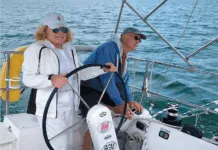
Mailport: Mainsail; Furl Fan; Keel Boats

What’s Involved in Setting Up a Lithium Battery System?
Leave a reply cancel reply.
Log in to leave a comment
Latest Videos
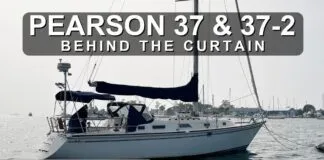
Pearson 37 & 37-2 – Behind the Curtain

How To Test a Boat Engine

Hunter Legend 35.5 – Behind the Curtain

Whipping Line On Your Sailboat
Latest sailboat review.
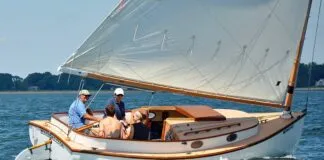
- Privacy Policy
- Do Not Sell My Personal Information
- Online Account Activation
- Privacy Manager
Great choice! Your favorites are temporarily saved for this session. Sign in to save them permanently, access them on any device, and receive relevant alerts.
- Sailboat Guide

- Collections
Cruising World: 40 Best Sailboats
Cruising World polled their readers to determine the best sailboats of all time.
Check out the article to read more and learn how these were chosen.

Hinckley Bermuda 40-1

Catalina 30

Hallberg-Rassy 42 (Enderlein)

Pacific Seacraft 37

Kelly-Peterson 44

Passport 40

Island Packet 38

CSY 44 (Mid-Cockpit)

Westsail 32

Beneteau 423

Morris 36 Justine

Columbia 50

Contessa 26

Morgan Out Island 41

Tartan 34 C

Islander 36

Pearson Triton

Gulfstar 50

C&C Landfall 38

Swan 44 (S&S)

Beneteau Sense 50

Freedom 40 CC
Nor'sea 27.

Jeanneau Sun Odyssey 43 DS

Alerion Express 28

Dufour Arpege 30

Pearson Vanguard 33

Embed this page on your own website by copying and pasting this code.

- About Sailboat Guide
©2024 Sea Time Tech, LLC
This site is protected by reCAPTCHA and the Google Privacy Policy and Terms of Service apply.


Explore Your Waterways
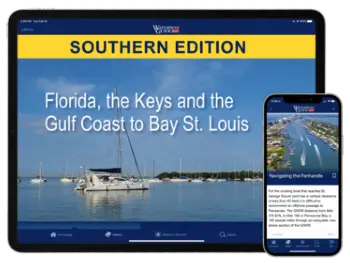
The Waterway Guide Team has gained extensive boating knowledge over the years, and now we are sharing all of the tips, skills and tools we’ve picked up along the way!
The Waterway Guide App makes it easy to leave reviews, use our Explorer, and view Waterway Guide materials, all on the go!

*In-App Purchases Available

- Download The App
- Destinations
- Knowledge Center
Apple Sign-In

Sign up to get Navigation Alerts and News delivered to your inbox!
Invalid Email
Invalid Captcha
Check out our latest newsletter
Newsletter Sign-Up
A is a facility where you can keep your boat tied in a slip.
The captcha question was answered incorrectly.
The email is invalid. Please close the modal window and try again.
Signing-up...
Buy a Guide

[email protected]

Hurricane Beryl Relief Efforts

Doyle Guides led the Caribbean sailing guide industry first with color sketch charts, then computerized color sketch charts, GPS waypoints, a website, and now, a free mobile app. Download it from the app stores today!

Monthly Newsletter
Subscribe to our newsletter and stay in the know.
Doyle Guides has been producing the region’s most trusted and comprehensive sailing guides since 1980. Now, you can stay in the know with curated Caribbean sailing content straight to your inbox, including guide book content updates, local news, announcements, and exclusive offers. Unsubscribe at any time.
Purchase the southern Caribbean’s most detailed and trusted sailing guides.
Doyle Guides on Facebook
Join our growing online community of Caribbean sailors discussing news, events, and everything from bow to stern.
Suggest a Correction
Things change quickly, so let us know here if you think something needs updating and we’ll do our best to address it.
Guide Updates
Customs & immigration, island foods, sailor's hikes, cruiser's groups, caribbean sailing guides notice board, 2024-2025 sailor’s guide to the windward islands.
Both hard copies and the digital app version of the 2024-2025 Sailor’s Guide to the Windward Islands are now available! If you’re in the US you can order hard copies online from [email protected] . A list of Canadian and European suppliers can be found here . Locally within the Caribbean, look for hard copies at chandleries, including Budget Marine and Island Water World.

Trinidad & Tobago
News & updates.
- New channel markers at Clarkes Court Bay in Grenada, Details here .
- Martinique now has an online customs clearance system that allows you to complete the entire process digitally and without having to go ashore. Read more here .
- SailClear announced a new $25 US annual fee as of May 1st, though as of May 15th has not begun charging it. Read more here .
- New anchoring restrictions in Marin, Martinique. Details here .
- We’ve updated our chart of Black Bay, Grenada. See it here .
- Customs check-in procedures in Marigot, St. Marten have seemingly changed. Read about it here .
- New moorings around the underwater sculpture park in Grenada. Read details here .
- New moorings in Man-o-War Bay, Tobago, read about it here
- New fees for the Tobago Cays Marine Park, check it out here
- We’ve updated the links to our GPS Waypoints, found under the Extras menu at the top of this page.
- We’re on Instagram! Follow us @doyleguides
- For even more updates, check out our Facebook page
- You too can take part in science – send your photos of whales to Natalie Ward here
Pure Grenada Guide
Click the cover on the right to view or download the free Pure Grenada Guide to Yachting & Watersports.
Explore Grenada above AND below the water with our detailed (and free!) guide to watersports in this stunning tri-island state. The Pure Grenada Guide to Sailing & Watersports includes all the detailed yaching info you’re used. tofrom our guides, plus dive site descriptions, dive site maps, info on snorkeling, as well as kayaking, stand-up paddling, kiteboarding, fishing, regattas, and match racing.
Did We Miss Something?
Suggest a correction here and we'll do our best to include it in the new edition of our caribbean sailing guides..
Email Address
Other Articles By Us

A Colorful Cast of Characters Rally in Grenada
Cruising World Magazine, Jan 17 th 2023, Lexi Fisher

ARC Plus Celebrates Cruising Camaraderie in Grenada
Cruising World Magazine, Feb 23 rd 2022, Lexi Fisher

Martinique: French Flair, Sandy Beaches — and Boatyards
The Caribbean Compass, June 5 th 2023, Lexi Fisher

Into The Blue
Page 22, Cacique Magazine, Sept 2022, Lexi Fisher

Caribbean sailing 2022: the rules and where to go
Yachting World Magazine, Jan 17 th 2022, Lexi Fisher

ARC Fleet 2021 Ready to Set Sail from the Canary Islands
Cruising World Magazine, Nov 3 rd 2021, Lexi Fisher

Grenada, Carriacou, and Petite Martinique: Everything From Bustling to Balmy
The Caribbean Compass, 2021, Lexi Fisher

On a Single Breath of Air
Page 19, The Caribbean Compass, Dec 2020, Lexi Fisher

Beyond Tyrrel Bay…Exploring Northern Carriacou
The Caribbean Compass, May 2020, Lexi Fisher

Shaping Our Coastlines
Page 26, The Caribbean Compass, Oct 2018, Lexi Fisher
Caribbean News Publications

Service Locator
- Angler Endorsement
- Boat Towing Coverage
- Mechanical Breakdown
- Insurance Requirements in Mexico
- Agreed Hull Value
- Actual Cash Value
- Liability Only
- Insurance Payment Options
- Claims Information
- Towing Service Agreement
- Membership Plans
- Boat Show Tickets
- BoatUS Boats For Sale
- Membership Payment Options
- Consumer Affairs
- Boat Documentation Requirements
- Installation Instructions
- Shipping & Handling Information
- Contact Boat Lettering
- End User Agreement
- Frequently Asked Questions
- Vessel Documentation
- BoatUS Foundation
- Government Affairs
- Powercruisers
- Buying & Selling Advice
- Maintenance
- Tow Vehicles
- Make & Create
- Makeovers & Refitting
- Accessories
- Electronics
- Skills, Tips, Tools
- Spring Preparation
- Winterization
- Boaters’ Rights
- Environment & Clean Water
- Boat Safety
- Navigational Hazards
- Personal Safety
- Batteries & Onboard Power
- Motors, Engines, Propulsion
- Books & Movies
- Communication & Etiquette
- Contests & Sweepstakes
- Colleges & Tech Schools
- Food, Drink, Entertainment
- New To Boating
- Travel & Destinations
- Watersports
- Anchors & Anchoring
- Boat Handling
- ← Lifestyle
A Boater's Guide To Cruising The Bahamas
Advertisement
Reaching paradise never comes easy. This veteran of the Bahamas liveaboard life shows how it's done.
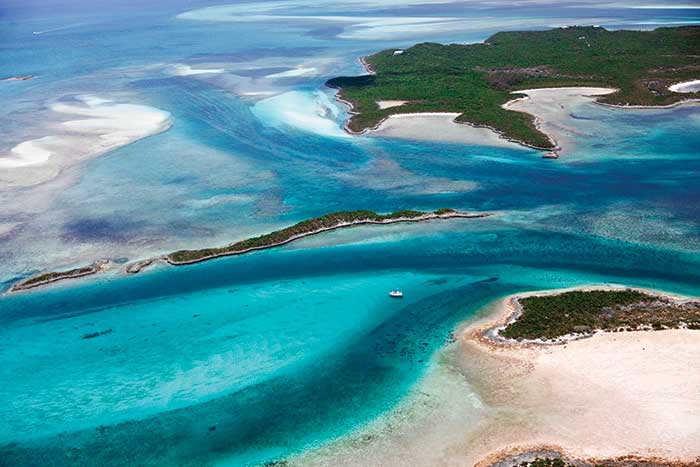
An aerial view of the Exumas. (Photo: Onne van der Wal)
They say that no one knows the exact number of islands in the Bahamas. Some say that there are around 2,400 of them, scattered about a stunning 590-mile-long archipelago, with its closest area being, for many boats, just one day's trip from Florida. Fewer than 50 of these islands have a village or town. Most are tiny islets with rocky shorelines and white beaches hinting of pink. Each is a gem of mangrove, casuarinas, palmetto, sea grape, and coconut palms hiding curly tail lizards, hermit crabs, and birds. But it's the wonderland of the ocean that is the Bahamas' most spectacular feature, with its warm turquoise waters over much of the shallow Bahama Banks.
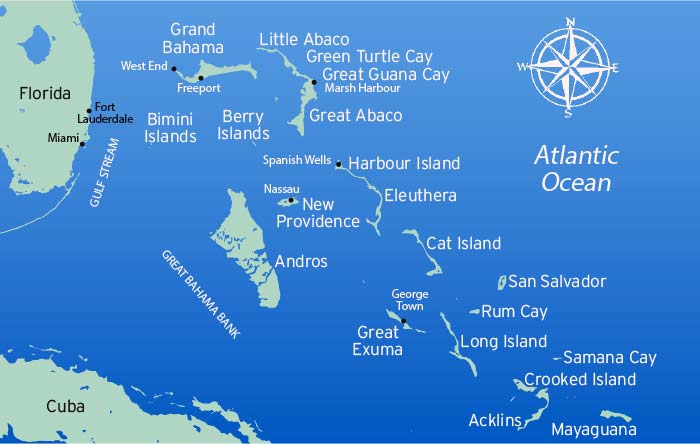
On a good day, cruising on the banks, you can look into those clear waters and see fish, sharks, and rays darting away from your hull's shadow as it sweeps across the bottom. Below you, grass and fan coral sway with the current. Brain coral hides exotic fish, lobster, and moray eel. Dramatic troughs leading from the shallows out to sea — such as the Tongue of the Ocean and the Northwest Providence Channel — divide the banks, the changing water colors from light turquoise to deep blue leaving even seasoned world travelers in awe.
The islands of the Bahamas lie mostly along the edges of the banks. On some of the outer islands, mail and groceries arrive by boat, and telephone and electricity in homes are relatively recent developments. While some equate the Bahamas with the cities of Nassau or Freeport, the boater's dreams tend to be of islands a bit farther off, such as Long Island, Highborne Cay, Eleuthera, Royal Island, Green Turtle, Mayaguana, Ragged Island, Crooked Island, and the Jumentos — or islands with no names at all, except as they're known to locals, such as Chicken Cay or "His and Hers."
Getting Around And About
The culture, dialect, and pace are distinctly Caribbean, yet the western waters of the Bahamas are only a little over 40 miles from Florida at the closest point. That 40-plus miles is composed of the mighty Gulf Stream, a warm and powerful river in the ocean with current rushing from south to north. Crossing it in the right conditions can be a beautiful trip. But crossing it in the wrong conditions, such as during strong northerly winds, can be dangerous and extremely uncomfortable. Pick your weather carefully, look for flat calm or gentle southerlies, and never go on the verge of a cold front or storm.
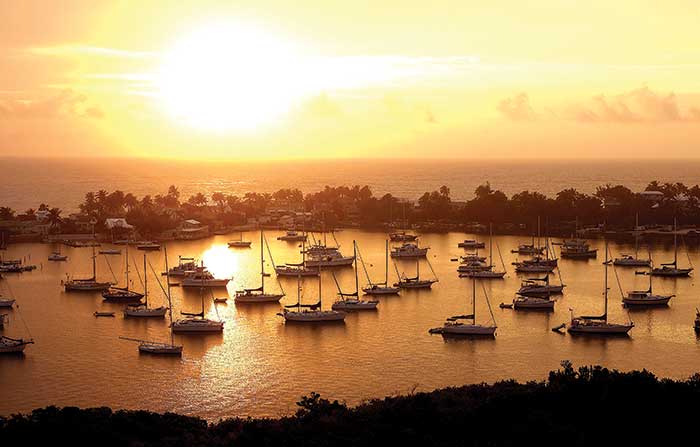
Snug all-weather anchorages are rare in the Bahamas, but when you find them, they offer camaraderie, supplies, and parties. (Photo: Onne van der Wal)
When my family and I first started going to the Bahamas many years ago, we followed a compass course and adjusted our routes to currents, wind, and waves. When we reckoned enough time had passed to raise an island, we searched the horizon. If we saw an island, we had to figure out which it was using landmarks, like clumps of trees or hills or colored cliffs. As we sailed in from deep ocean water onto to the shallow Bahama Banks, it was always a stunning moment as the depth sounder went from off soundings to 15 feet! We relied on the art of reading the colors of the water and the vagaries of the tidal currents by watching fan coral and sea grasses swaying to the flow under our boat — a fun endeavor, unless the light was poor or in our eyes.
Today, it's easier with GPS chartplotters. But you get in trouble if you rely too heavily on electronics. Sand shoals shift from year to year, and rocky bars and reefs may not be perfectly charted in the first place. A GPS fix is only as good as the chart you're relying on, and strong currents in inlets can set you onto rocks even as you watch your icon on the screen. And if your GPS equipment or the system isn't functioning well, you can get into trouble. The popularity of "crowdsourcing" doesn't necessarily work well in these waters, either; you never know the experience level of "the crowd" or the accuracy of their observations. Being a little off can put you on a reef.
Reliable guidebooks and paper charts are essential for Bahamas cruising. Otherwise, GPS waypoints extrapolated from mixed data may not be right on the spot. "Right on the spot" is critical when you're navigating an inlet that's only a few hundred feet wide with rocks and reefs around it and swells rolling in. Remember, Bahamas aids to navigation are rare and often not maintained.
Unlike the more forgiving waters of, say, Chesapeake Bay, the Bahamas are riddled with reefs, rocks, and brown bars (rocky ledges) that can quickly hole a boat, and there's no U.S. Coast Guard daily presence. There are some very good salvage firms, but the waters to which they must respond are vast. Lack of infrastructure means inconveniences and often long periods of time required for repairs. In many areas, there are few or no secure marinas or good anchorages available for storm protection. The Bahamas is mostly beautiful wilderness, so take care and navigate conservatively. To do so, you'll need the most reliable charts.
Sara and Monty Lewis began cruising the Bahamas more than 35 years ago. They produce and update The Explorer Chartbooks . Experienced cruisers swear by these Lewis charts. The waypoints provided are, they say, based on the Lewis team actually having gone to the rock, the deep part of the inlet, or the reef and recording the exact GPS reading while on site or verified with satellite photos or trusted advisers' data. Not only do they provide accurate full-color navigational charts, they also include cruising guide "need-to-know info" with informative articles and updated details on facilities and services throughout the Bahamas. (It's information from The Explorer Chartbooks that we heavily relied upon to bring you this article.)
Introducing The Bahamas By Region
Coming by boat , you'll probably get your first impression of the Bahamas from its western boundary. Here, the water and reefs are beautiful, and there are some anchorages for settled weather, as well as some marinas. Most of the small islands have rocky shores and lack good all-weather anchorages.
The Bimini Chain, a series of small cays (pronounced "keys") lies across the Gulf Stream from Miami and Fort Lauderdale. North and South Bimini and Cat Cay are settled. The mysterious stone slabs of the Bimini Road lie under nearby waters, fueling stories of Atlantis. Popular with the sportfishing fleet, Bimini has a village, several marinas, restaurants, and now a resort/casino and a Hilton Hotel.
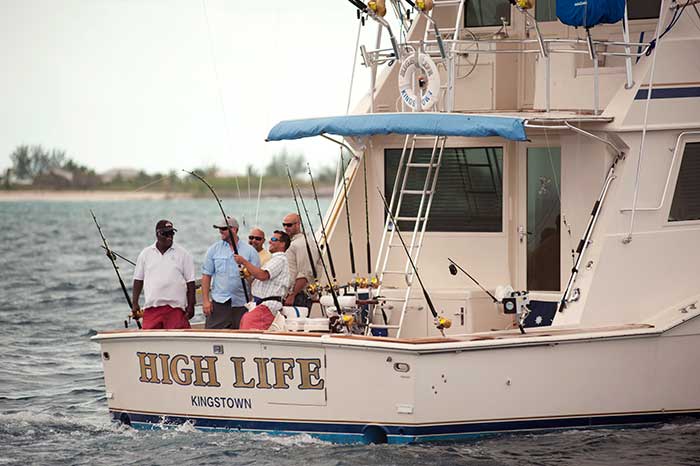
Whether you prefer fishing Bimini's flats or heading out into the deep for bigger game, charters abound. (Photo: Bahamas Ministry of Tourism)
To accommodate those who want to experience the beauty, often the beauty is sacrificed. Bimini has suffered, in my view, as have many of the islands, from the negatives of tourism. In recent years, many of the mangroves on the northern end of Bimini have been replaced by resort development. On the west side, an ocean-docking facility for fast ferries from Miami was built from material dredged up from the ocean bottom. But the Biminis are still accommodating as far as clearing customs and stopping to rest in a marina before crossing the banks. With the tourism have come positives — better availability of parts and goods and better communications in Bimini and other settled areas.
To the north of the Bimini Chain, separated from it by the deep Northwest Providence Channel, is the large island of Grand Bahama , with resorts and marinas. At the far northwestern end of Grand Bahama, the critically located Old Bahama Bay Marina offers shelter for boats caught by weather, as well as many amenities.
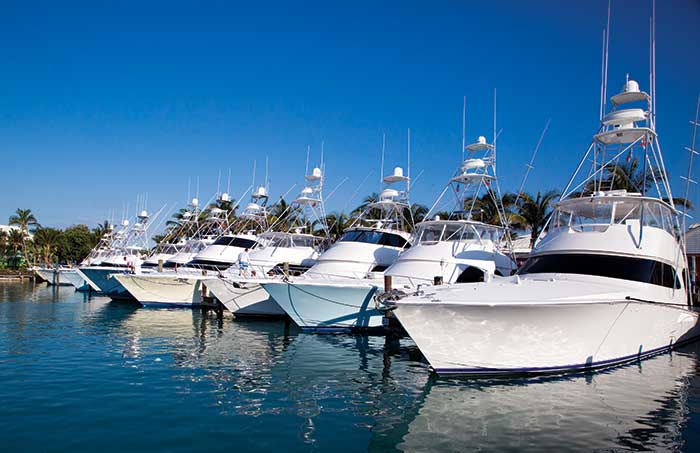
Old Bahama Bay Marina at the northwestern end of Grand Bahama offers shelter to boats caught by weather, as well as many amenities for boaters. (Photo: Bahamas Ministry of Tourism)
Southeast of the Bimini Chain, across the Great Bahama Banks, lies the giant and mysterious island of Andros . Known as the bonefishing capital of The Bahamas, Andros's vast swamps, creeks, mangrove shallows, and miles of woods stretch more than 100 miles south to north, divided into three major sections of land connected by mangrove and tidal swamp. Scattered about are many of the famous "blue holes" of the Bahamas, some far inland from the shore, extending deep down, many connected with the ocean through a labyrinth of subterranean passages. Nearby, the recently discovered Andros Platform, a multitiered structure of huge, flat, squared blocks, remains silently under the waves, begging explanation.
With limited good anchorages, sparsely populated Andros hasn't experienced the large influx of cruising boats. The Great Bahama Banks blends with the shallows and swamp of its western shore, but its eastern shore faces the deep "Tongue of the Ocean" and has several towns with limited facilities, such as Morgan's Bluff, Fresh Creek, and Congo Town. One of the longest barrier reefs in the world guards this shore, allowing limited access. Andros, like so many other islands, is yet to be awakened, and many would say that's good.
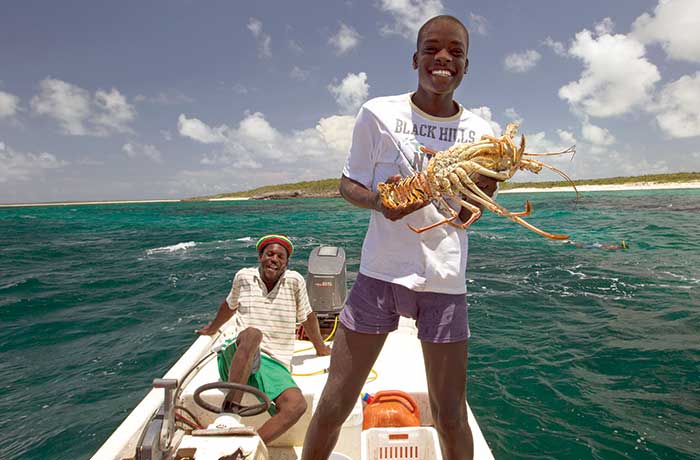
Spiny lobster season is August through March. (Photo: Bahamas Ministry of Tourism)
The Abacos is a great place for Bahamas exploration. While it is often considered more civilized than other areas, it's been affected less from tourism. Marinas, protected anchorages with good holding, shopping, good drinking water, restaurants, and small hotels make the area especially inviting. Many cruisers gravitate to the "Hub of the Abacos" with the towns and harbors of Man O'War, Hope Town, and Marsh Harbour. You can take short hops to different towns or anchorages across the shallow Sea of Abaco without going outside the reefs into the ocean. To the northwest of the Hub, and through sometimes-dangerous Whale Cay Passage, lies Green Turtle Cay with its several protected basins, marinas, and the town of New Plymouth with its quaint pastel homes similar to those of Man O'War and Hope Town.
The Berry Islands, known as "Der Berrys" by many Bahamians, are another expanse of small islands surrounded by shallow banks that rise from deep ocean. To the south and west of the busier Abacos, they aren't as heavily cruised because of their shallows and rolly anchorages, but this isolation makes them very attractive to some. Islands such as Great Stirrup, Great Harbor, Whale Cay, and Chub Cay rim the banks. Dinghy passages snake among white shoals and low-tide sand islands. It's easy to get lost. Only three marinas make bases for exploration. Chub Cay Marina is completely protected within an enclosed basin, recently reopened after hurricane damage, though not in full operation as of the date of this writing. Great Harbour Cay Marina also offers excellent shelter and is affordable, with more slips available for transients. In addition, the popular Berry Islands Club is also reopening its restaurant, rebuilding its docks, and fortifying its moorings after a hiatus. Always check ahead for any marina, to be sure it's currently open.
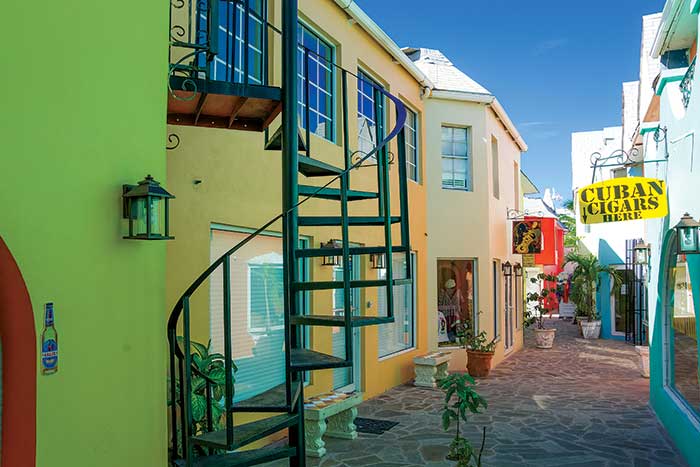
Downtown Nassau is known for its colorful architecture. (Photo: Bahamas Ministry of Tourism)
Many tourists consider Nassau to be synonymous with the Bahamas. Not hardly. This is the capital of the Bahamas and more than half the Bahamian population lives on its island of New Providence . It has the good and bad traits of most cities, with a distinctly Caribbean flavor, though reports of violent crime are increasing. Police in white uniforms direct traffic. Horse-drawn carriages commingle with cars, jitneys, and scooters. Buildings and customs reminiscent of the British Colonial Empire blend with things modern, overlaid with a significant share of poverty.
Nassau Harbour separates the "mainland" from Paradise Island, which has luxury hotels and casinos. The northwestern entrance to the harbor is deep and jettied, with several buoys. Huge cruise liners enter, but the inlet can be dangerous in strong onshore winds.
Anchoring isn't recommended in much of the harbor because of poor holding, strong currents, fast boats, wakes, and crime issues. There are several marinas; if Nassau has to be on your cruising itinerary, many boaters select a marina on Paradise Island. The southeastern entrance channel is only around 8 feet deep in one spot where coral heads and rocky bars dictate precise navigation.
To the southeast, the Exuma Cays curve in a northwest-southeast direction. The Exumas have only a few small all-weather marinas. Most anchorages are unprotected from westerlies, so they're only good for settled weather. The few that are sheltered from westerlies are between rocky islands and plagued by swift current and scoured bottom. The islands are generally rocky with low vegetation, sparse population, and a few villages. Nevertheless, each year more and more boats visit .
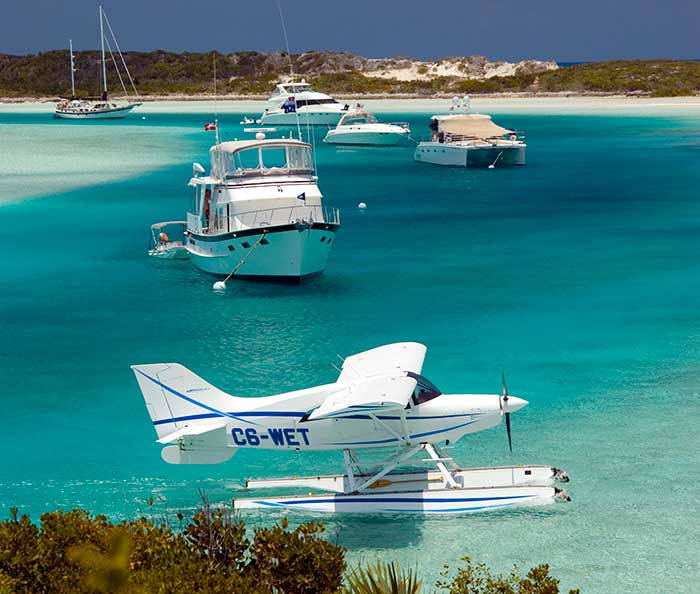
Cruisers lying to moorings in the beautiful and protected Exuma Cays Land and Sea Park. In many places, moorings are preferred or even required to avoid damage to the bottom and because of limited swinging room. (Photo: Bahamas Ministry of Tourism)
They've become so popular that celebrities and other wealthy people have purchased entire islands or large portions of them. It's reported that the Exuma Land and Sea Park, once a stronghold of environmental protection, now features such private islands, and personal watercraft from mega yachts often roar up and down the pristine channels. Staged "paradise" picnics on the beaches, replete with instant tents, bars, and lounges, entertain charter parties with all their water toys. Anchorages once enjoyed by a few are now becoming more crowded.
Heading down the chain, cruisers like to stop and enjoy the out-island friendliness of the small villages of Staniel Cay, Black Point, and Little Farmer's Cay . Village restaurants sometimes announce special menus on the VHF. Small grocery stores have limited supplies, and Staniel Cay's Isles General Store has marine and general hardware as well as groceries. And the Blue Store and the Pink Store have also expanded their stock to accommodate the greater number of cruisers and vacationers.
The Staniel Cay Yacht Club offers good meals, fuel, water purified by reverse osmosis, and a nice bar as well as cottage rentals. Indeed, the entire village is open to many home rentals. Fowl Cay Resort is one of several resort islands with rental houses and cottages, and it also has a restaurant available to the public by reservation. Snorkel into Thunderball Cave off Staniel and enjoy viewing thousands of protected fish. Part of the James Bond movie of that name was filmed here.
At the southern end of the Exumas, the "mainland" island of Great Exuma is a popular boating destination with a good but busy harbor. Its George Town boasts supplies and high island civilization. Exuma Market provides dinghy docking, town water, and other services while across Lake Victoria, the well-stocked Shop-Rite is another good choice for stocking. FedEx, UPS, boat supplies, and many other helpful goods and services are available. Almost 400 cruising boats are often in its Elizabeth Harbour for the annual spring Cruising Regatta, a weeklong festival run by the cruising community in conjunction with the Bahamian community.
Heading easterly from the Exumas you'll find more islands and variety. To the north, Eleuthera is known for its oranges and pineapples. Cruisers often visit the busy village of Spanish Wells with its fishing fleet, marinas, marine railways, and supplies. Harbour Island, guarded by the treacherous reef known as Devil's Backbone, is also popular for its pink sand beaches, quaint pastel-color buildings, the historic village of Dunmore Town, marinas, fishing, and relatively upscale living. Royal Island with its enclosed harbor broods with thick foliage and the silent ruins of a large estate. Years ago, wooden sailing ships of the British Navy sought shelter here; today cruisers wait for passage to the Abacos.
Cat Island, south of Eleuthera, stretches 48 miles, offering few anchorages but high hills, farms, villages, and miles of cliff and beach. To the south of Cat lies Long Island, with dangerous reefs extending more than 3 miles off Cape Santa Maria at its northern end. Never more than 4 miles wide, it's 75 miles long and features rolling hills and cliffs, fertile soil, and farming. A popular destination is Salt Pond and Thompson Bay on the west side, from where cruisers can tour the island by car and stock up at a modern grocery. Avoid anchorages exposed to weather and seas.
Far to the south and east, the "far out islands" rise from the deep ocean floor, beyond the banks. You'll find isolated jewels such as Rum Cay and Conception Island. Sumner Point Marina at Rum Cay has been closed due to hurricane damage as of this writing. As you venture farther southeast, more spectacular little islands with limited protection beckon with even more remoteness. These include Samana Cay, where Christopher Columbus is said to have anchored; Crooked Island; Acklins Island; Great Inagua with its famous flamingo population; and Mayaguana — all beautiful islands off the beaten track.
The Jumentos chain arches 90 miles around the southeast boundary of the Great Bahama Banks and has become more popular in recent years for experienced cruisers looking to find pristine islands as they once were. Many of these islands have little all-weather protection, tricky shallows, and few replenishing and stocking opportunities, but make up for it in sweet solitude
You Can't Always Get What You Want
The Bahamas, with their overwhelming beauty and thousands of square miles of ocean wilderness, offer a wonderful boating escape from the massive infrastructure and dense civilization of the States. But what makes them compelling also makes them challenging for unprepared boaters. Go soon if you can, take good care, and tread lightly.
Bahamas Fun Facts
- The Bahamas has the clearest water in the world. Visibility while diving is often more than 200 feet!
- Fewer than 50 of the islands have a village or town.
- The Bahamas has the world's third-longest barrier reef.
- Dean's Blue Hole, west of Clarence Town, Long Island, at 663 feet, is one of the deepest blue holes in the world.
- The first place Christopher Columbus landed when he came to the new world in 1492, he named San Salvador in the Bahamas.
- The word "mainland" is used by those on small outlying islands (called the Out Islands) to describe the larger islands, such as New Providence, Grand Bahama, Great Abaco, and Great Exuma. The "Far-Out Islands" are those even farther away.
- The world's longest underwater cave system can be found in Lucayan National Park, Grand Bahama Island.
- Kalik (pronounced "click"), the beer of The Bahamas, is named after the kalikking sound of cowbells at Junkanoo, the island street parades held every December 26.
- There are only about 396,000 people in all the Bahamas, the majority on the island of New Providence where Nassau is located.
- The national sport of the Bahamas is sloop sailing.
- Bahamas comes from the Spanish baja mar, which translates to "shallow sea."
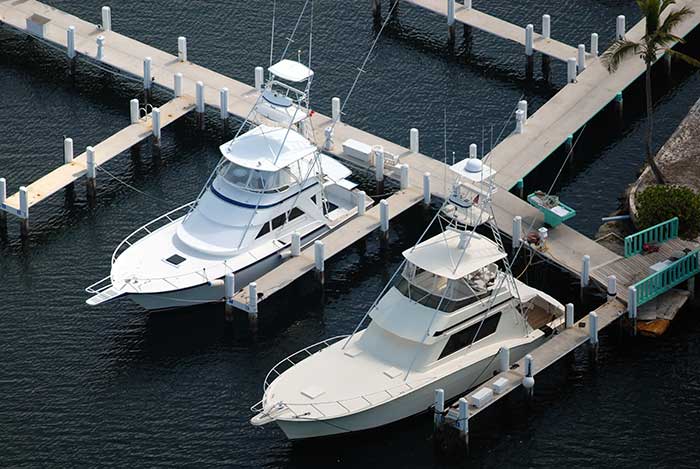
Photo: Bahamas Ministry of Tourism
Chartering & Fishing
Power, sail & crewed charters.
- The Moorings (Abacos)
- Navtours (Nassau, George Town, Staniel Cay)
- Sunsail (Abacos, Nassau)
Sportfishing
- Boaters arriving on their own boats congregate around the marinas in Bimini, Nassau, Chub Cay, Boat Harbor, Highbourne Cay, and others.
- Note that fishing here is split between distinctively different offshore fishing and flats fishing (for bonefish).
- To join a sportfishing charter, search the Internet for numerous listings.
- Consider checking out one of the many fishing tournaments, listed at Bahamas.com/fishing-tournaments-2017.
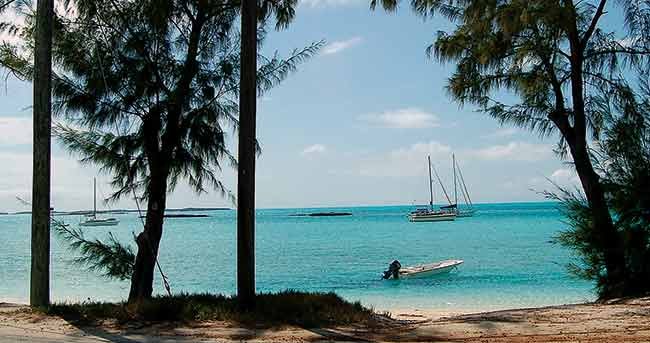
Photo: Mel Neale
Anchoring Notes
- Never anchor in reef or anywhere your anchor rode may get tangled in coral.
- Leave 360-degree swing room for other boats, the shore, and reefs. Boats swing differently depending on their windage, bottom configuration, eddies, and current.
- The best bottoms consist of deep, soft white sand. You'll see these from the bow of your boat. Don't be misled by bottoms of white rock, marl, or shallow white sand over rock.
- Anchoring in grass usually results in dragging when the wind increases and damaging fish habitat.
- Nylon line can be cut by small rocks or reef. Use as much chain as your boat can safely carry.
- Don't anchor on a lee shore (the shore toward which the wind is blowing). Learn and watch the weather; plan your anchorage for 24 hours. It's not unusual for Bahamian winds to shift over that time.
- What starts as a protected anchorage could become a risky lee shore.
- Study an accurate weather forecast every day, and plan overnight anchorages accordingly.
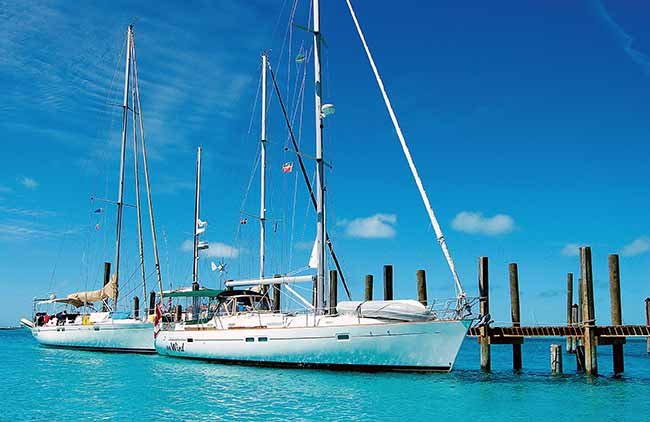
Weather Notes
- Obtain a detailed weather forecast every day. Heed it.
- Winter cold fronts are often preceded by strong southwesterly winds and come through as a strong, precipitous westerly, then nor'wester. Then winds often clock to a nor'easter and blow hard for days.
- "Squeeze plays" between large areas of high and large areas of low pressure may set up strong winds, usually from the east, for several days.
- The Bahamas offers little good protection in hurricanes and tropical lows. Even enclosed harbors are vulnerable with so little land to weaken the effects of wind and sea. Expect little help compared to U.S. waters.
Respect The 'Rage'
If there is a strong onshore swell, many cuts between islands and reefs become treacherous. The onshore swell may be caused by local onshore winds or from a far-off storm. At sea the swell may seem insignificant, but as it mounts up in the shallow waters near the cuts, it can become deadly. These swells can be far away when you leave the safety of your harbor in the morning but dangerously upon you when you want to enter the next inlet down-island. Watch the weather locally and far out. Ask ahead for current local conditions and knowledge. If any question exists about the safety of an inlet, don't risk it.
Search And Rescue
The Bahamas government has no search-and-rescue service equivalent to the U.S. Coast Guard. The Bahamas Air Sea Rescue Association (BASRA) is a dedicated nonprofit voluntary organization committed to saving the lives of distressed seamen and airmen in the Bahamas. It is funded by donations.
For boaters traveling off the beaten track, consider renting an EPIRB or PLB from the BoatUS Foundation before you go. Visit BoatUS.org for more information.
What Are Your Special Interests?
Looking to hang out with other cruisers? Consider the Hub of the Abacos. Several islands encircle the protected "Sea of Abaco" in which you can go from town to town in protected waters without going out through the reefs into the ocean. Towns include Marsh Harbour, Hope Town, Man O'War. A short hop in calm weather in the ocean fetches up Green Turtle Cay, and a trip south inside will bring you to Little Harbour, home of Pete's Pub and Foundry. There are more marinas in this area than in most other areas of the Bahamas.
Elizabeth Harbour lies near the southeastern end of the Exuma chain and has become a Mecca for cruisers with its relative protection (albeit with some open fetches) and good holding. Its bustling village of George Town is a vacation spot and an oasis of out island "high civilization," which hasn't lost its out-island charm. "In season," from December through March, there can be as many as 400 boats there, with all the potlucks and beach volleyball games you could want. The reefs guarding the entrances can be tricky; good weather and careful navigation are a must. Don't enter with a strong onshore wind or swell.
Looking for sport fishing? Alice Town on North Bimini offers several marinas, bars, restaurants, and good fishing offshore, with several tournaments throughout the year. Chub Cay, scheduled to be fully operational (after the ravages of Hurricane Mathew) has a marina in a completely enclosed harbor with restaurant, bars for bragging, and Customs. Fish offshore in the Tongue of the Ocean between the Berrys, New Providence, and the Great Bahama Banks.
Looking for remote experiences? What used to be remote may be more visited today, although features such as poor holding, little protection from wind and surge, and few provisioning opportunities still keeps the crowds away. You'll find unspoiled beauty and solitude in the Jumentos, Rum Cay (marina may not be rebuilt yet), the shallow banks of the Berrys (where people often explore by dinghy), and Conception Island. These areas have scarce protection, and require serious weather vigilance.
Looking for good diving and snorkeling? The Bahamas has the world's third-longest barrier reef. Five percent of the world's coral can be found there. Bring a light wetsuit, snorkel, mask, and fins for great snorkeling by dinghy throughout The Bahamas.
Looking for a show? Held at the end of April every year, the Family Island Regatta in Elizabeth Harbour is huge. Bahamians come from all the islands to compete, usually in traditional Bahamian boats. Also, the New Year's Day Regatta at Staniel Cay in the Exumas is fun, informal, and rollicking.
Related Articles
The truth about ceramic coatings for boats.
Our editor investigates the marketing claims of consumer-grade ceramic coatings.
Fine-Tune Your Side Scan Fishfinder
Take your side-scanning fishfinder off auto mode, and you’ll be spotting your prey from afar in no time
DIY Boat Foam Decking
Closed-cell foam flooring helps make boating more comfortable. Here’s how to install it on your vessel
Click to explore related articles
Technical Editor, BoatUS Magazine
One of the top technical experts in the marine industry, Tom Neale, BoatUS Magazine Technical Editor, has won nine first-place awards from Boating Writers International, and is author of the magazine’s popular "Ask The Experts" column. His depth of technical knowledge comes from living aboard various boats with his family for more than 30 years, cruising far and wide, and essentially learning how to install, fix, and rebuild every system onboard himself. A lawyer by training, for most of his career Tom has been an editor and columnist at national magazines such as Cruising World, PassageMaker, and Soundings. He wrote the acclaimed memoir All In The Same Boat (McGraw Hill), as well as Chesapeake Bay Cruising Guide, Vol. 1. These days, Tom and his wife Mel enjoy cruising their 2006 Camano 41 Chez Nous with their grandchildren.
BoatUS Magazine Is A Benefit Of BoatUS Membership
Membership Benefits Include:
Subscription to the print version of BoatUS Magazine
4% back on purchases from West Marine stores or online at WestMarine.com
Discounts on fuel, transient slips, repairs and more at over 1,200 businesses
Deals on cruises, charters, car rentals, hotel stays and more…
All for only $25/year!
We use cookies to enhance your visit to our website and to improve your experience. By continuing to use our website, you’re agreeing to our cookie policy.
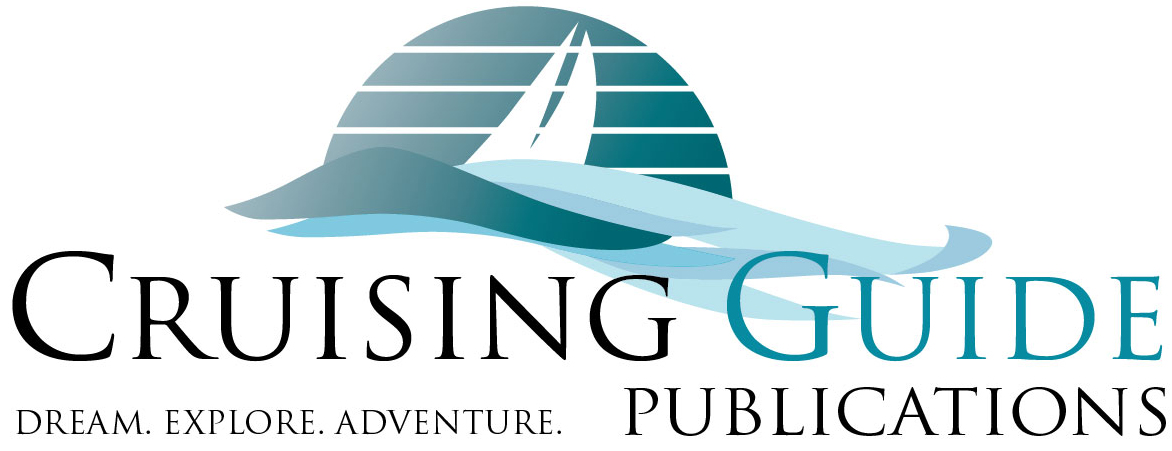
Exploring the Caribbean one anchorage at a time
Receive our latest articles in your inbox, featured articles, the u.s. virgin islands install 200 mooring balls throughout territory that can be paid for on-line, destination us virgin islands, a visit to the great conch mounds of anegada, latest releases.

The Cruising Guide to the Virgin Islands 2024 edition
Updated for 2024 The Cruising Guide to the Virgin Islands is now in our warehouse and available for distribution. Updated detail and locations for the new USVI mooring initiative along with extended detail of anchorages, underwater exploration and shoreside activities are included. Includes a fold out planning chart.
Books , Cruising Guides , Featured , Guides , Our Guides

The Sailors Guide to the Windward Islands 2024 edition
Just released! The 21st edition of the Sailors Guide to the Windward Islands. After 40 years in print, this book continues to be the best selling cruising guide to the Windward Islands. Features include: aerial color photos, full color sketch charts, GPS waypoints and some of the best local information available. Martinique to Grenada.

The Cruising Guide to Abaco Bahamas 2024 edition
The 35th edition of the annually updated Cruising Guide to Abaco Bahamas is now available! The guide covers from Walker Cay to Hole-in-the-Wall plus passage information from Florida to Abaco.
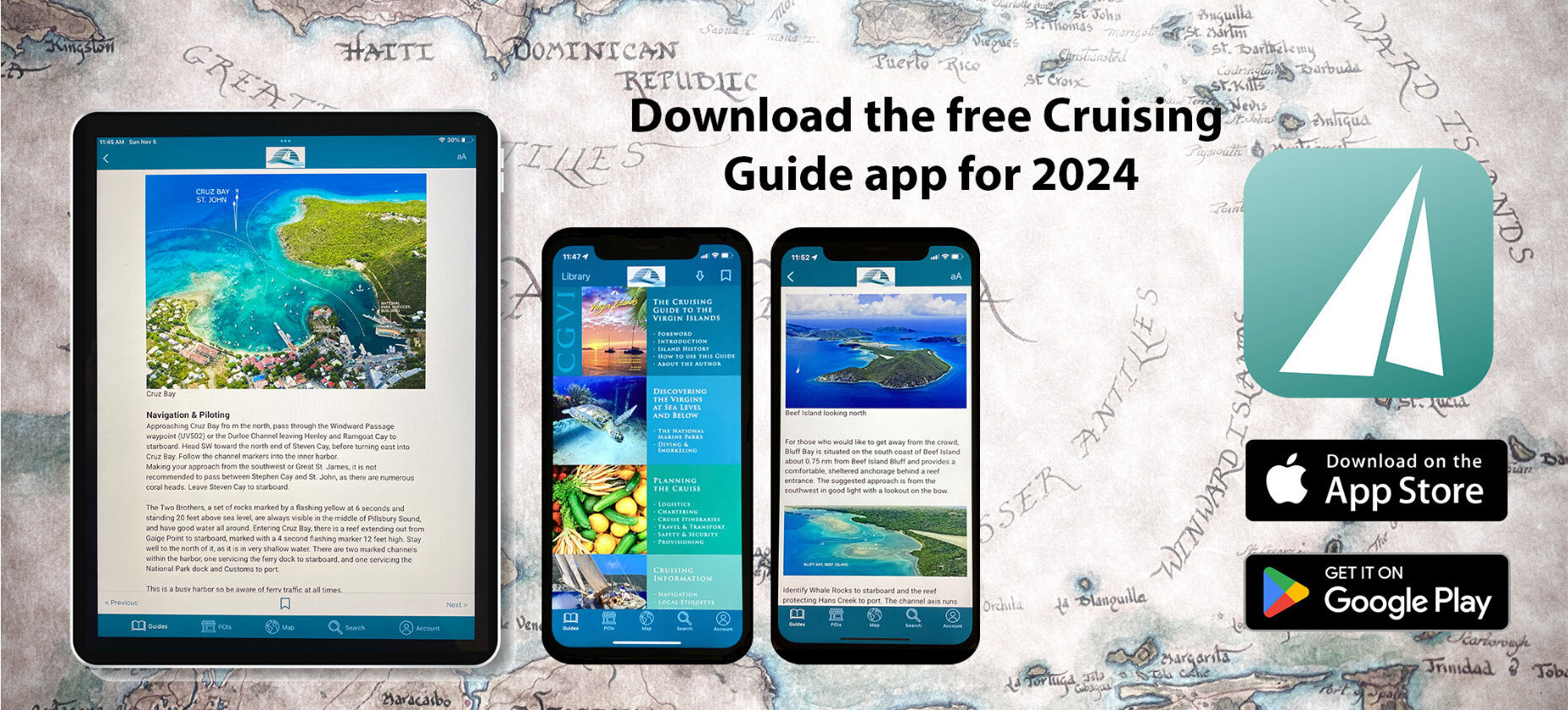
Download The New Caribbean Cruising Guide Mobile App
Cruising Guide Publications is delighted to announce the long-awaited mobile app designed for Caribbean sailors and now available at both the Apple and Google App Stores.
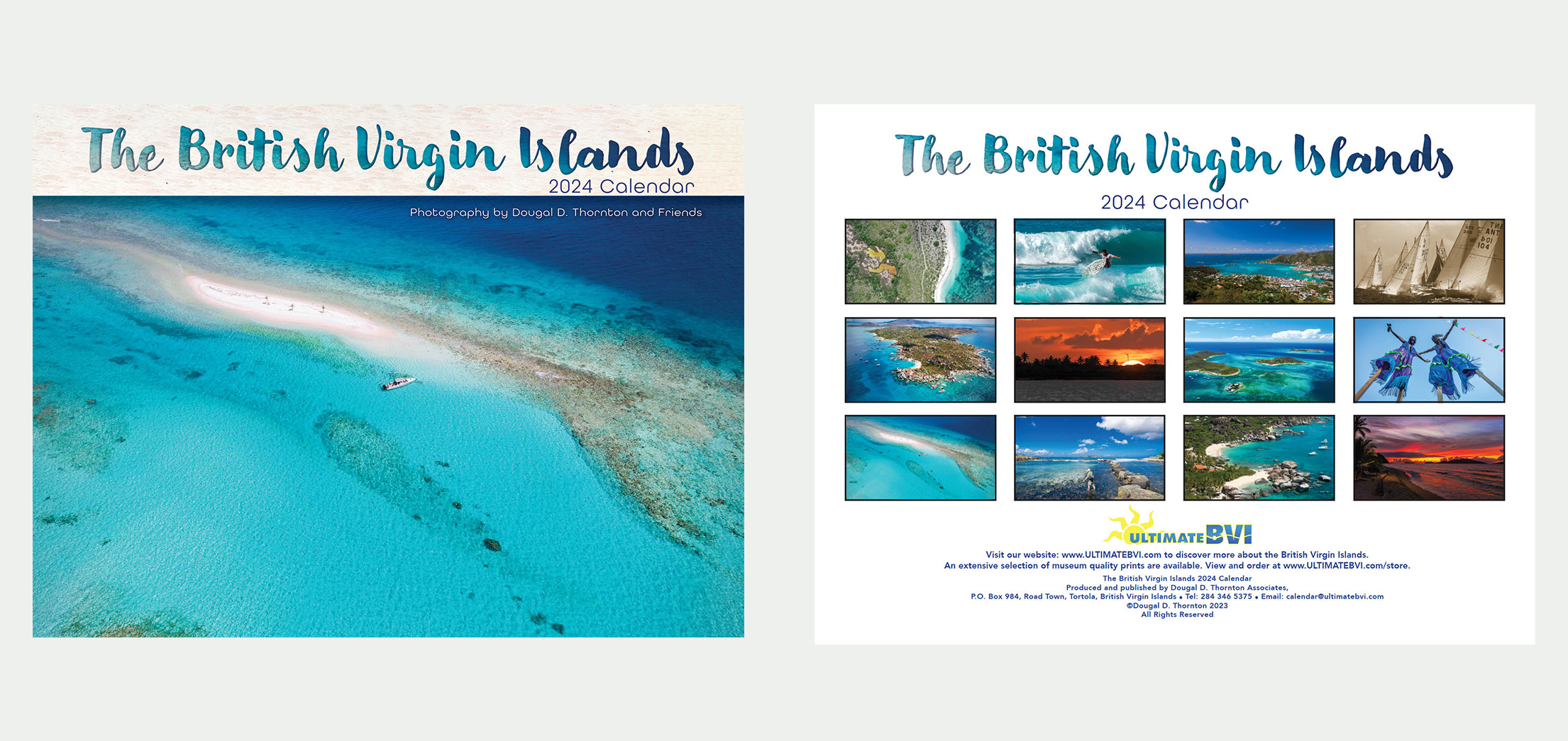
The 2024 BVI Calendar
As you have grown to know and love, the 2024 calendar features food and drink recipes throughout the months so you can enjoy some exciting island cuisine as you view each of the beautifully reproduced photographs of the 60 islands and cays of the British Virgin Islands. It’s the British Virgin Islands at its best.
Latest Products

A Waterproof Planning Chart of the Virgin Islands

The Panama Cruising Guide 5th edition
Books , Cruising Guides , Guides , Our Guides
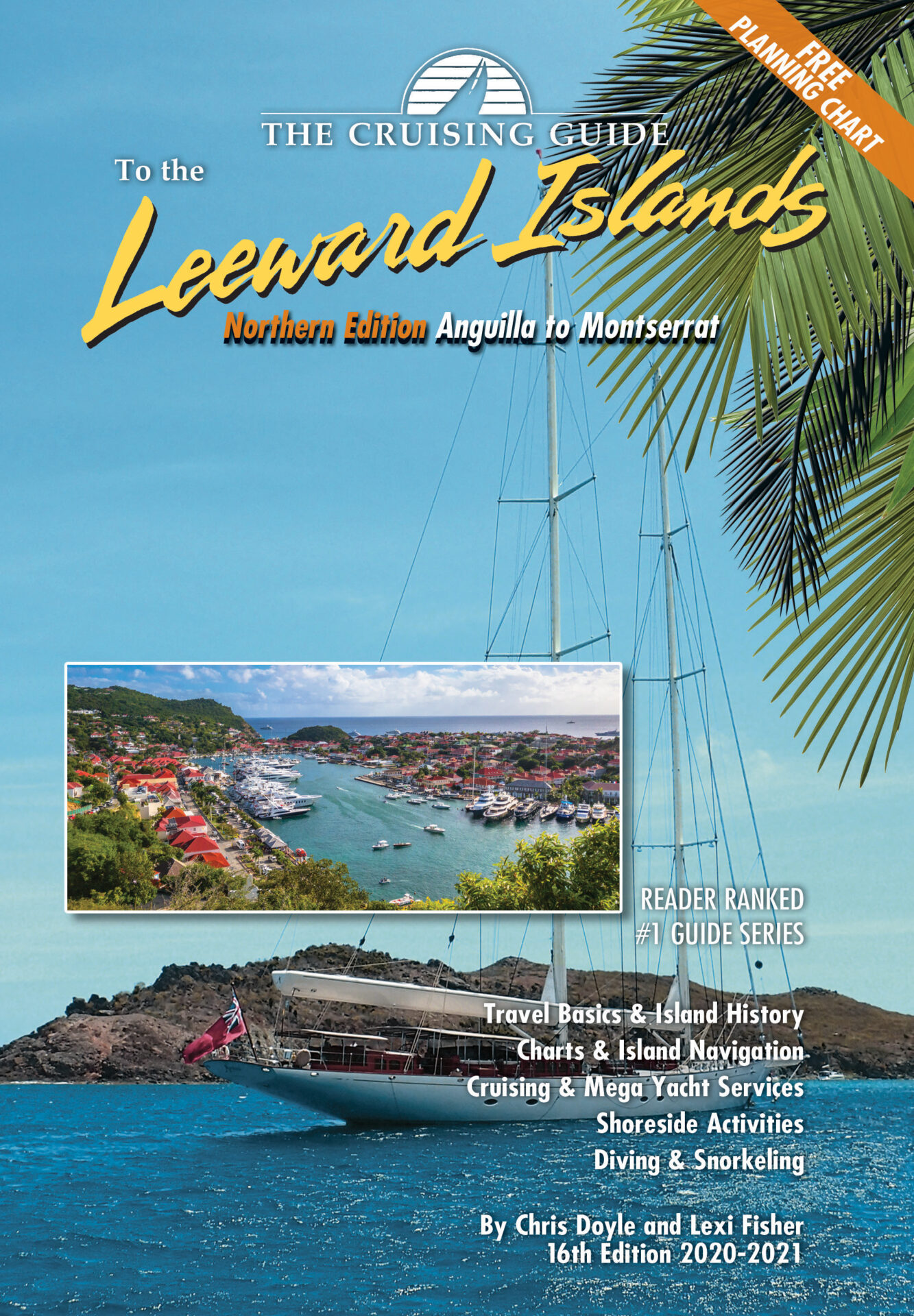
The Cruising Guide to the Northern Leeward Islands 2020-2021 edition
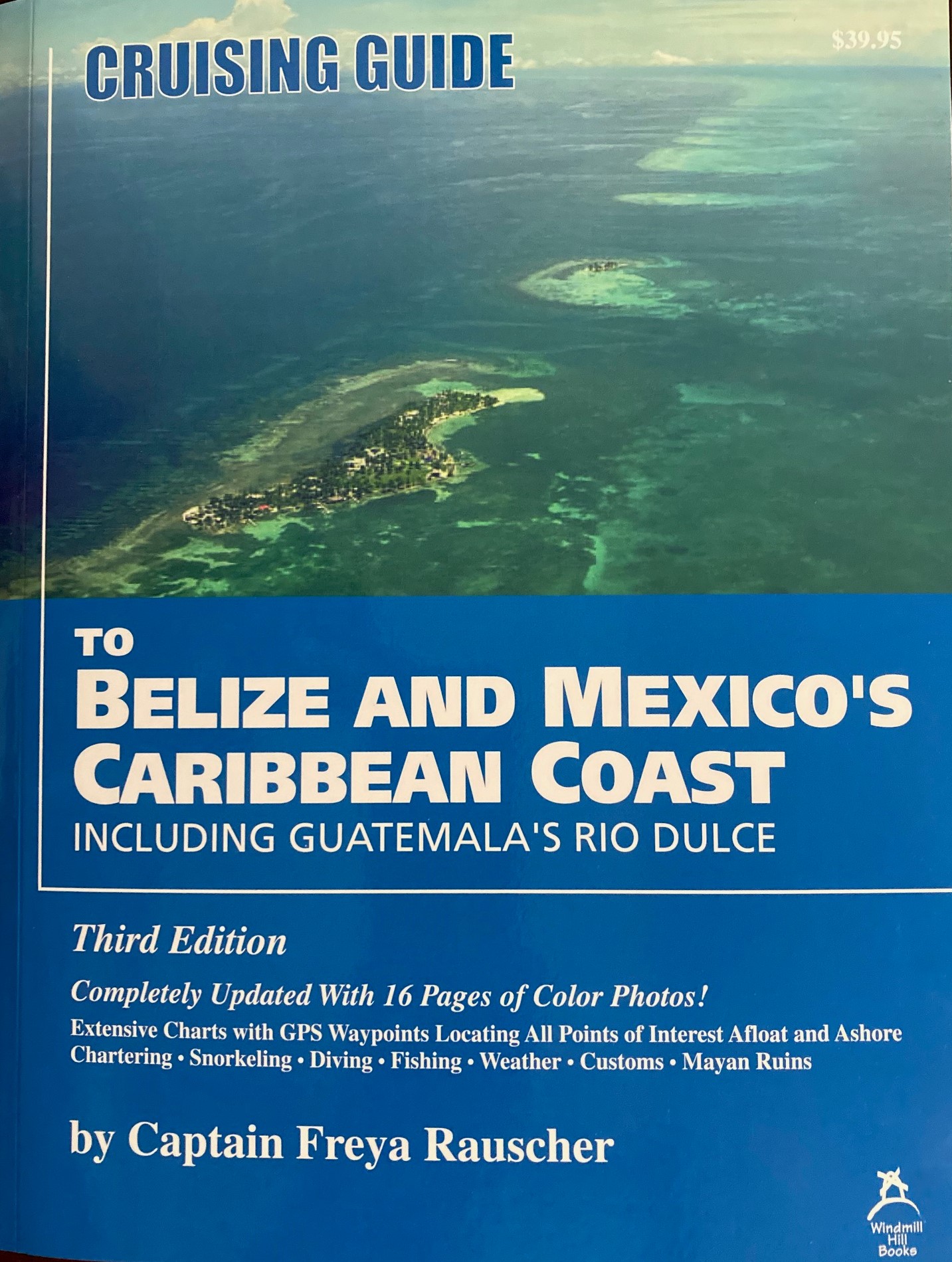
Cruising Guide to Belize & Mexico’s Caribbean Coast Including Guatemala’s Rio Dulce
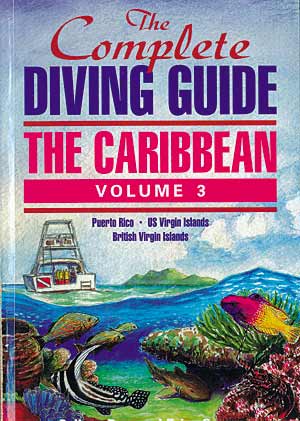
The Complete Diving Guide -The Virgin Islands
Books , Cruising Guides , Diving & Snorkeling Guides , Guides , Our Guides
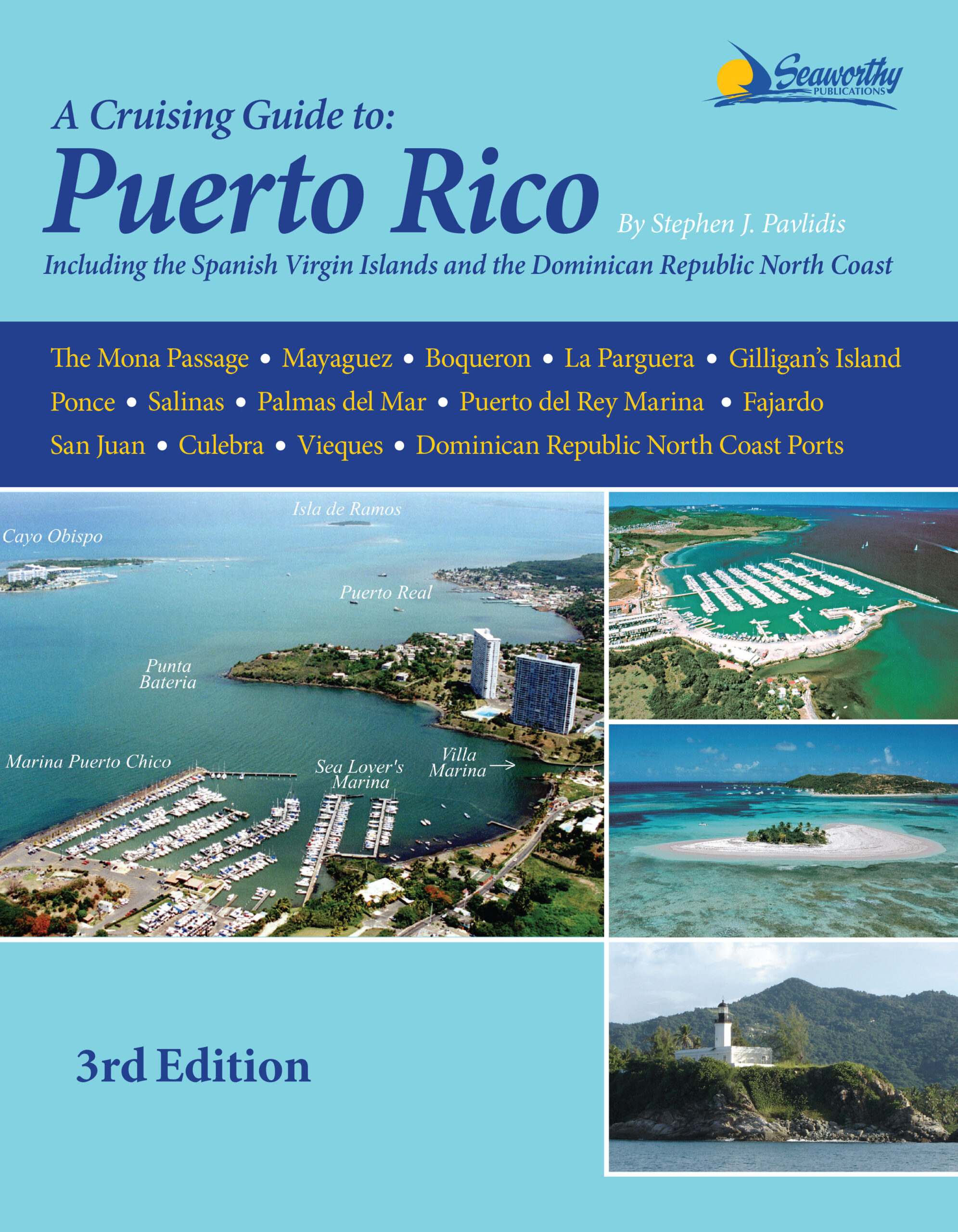
A Cruising Guide to Puerto Rico Including the Spanish Virgin Islands
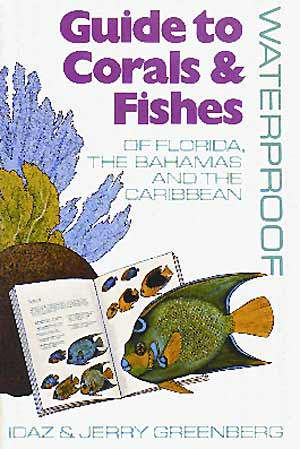
Waterproof Pocket Guide Corals & Fishes, Florida Bahamas & Caribbean
Diving & Snorkeling Guides
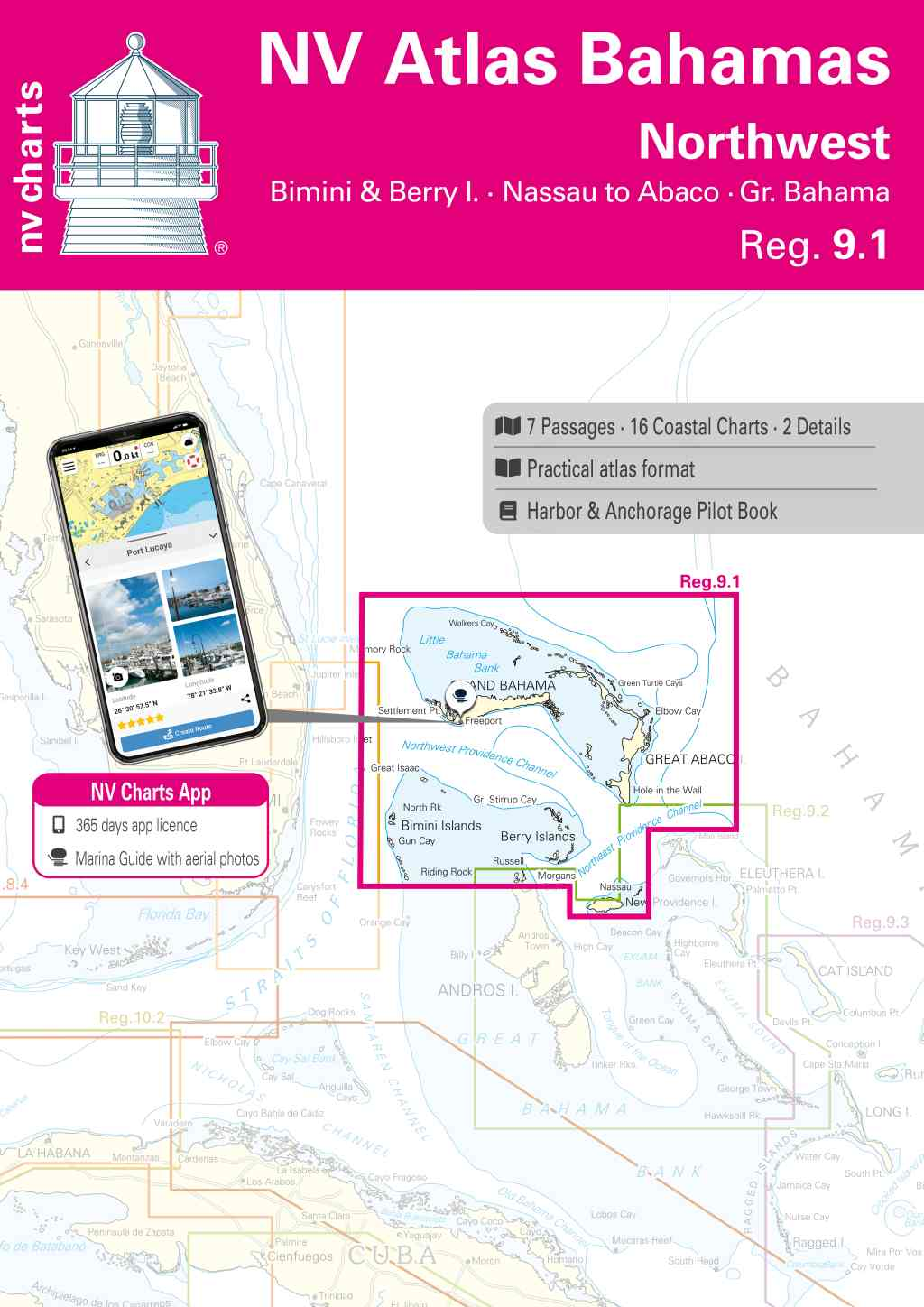
NV Atlas Bahamas 9.1: Northwest
Cruising articles & tips.
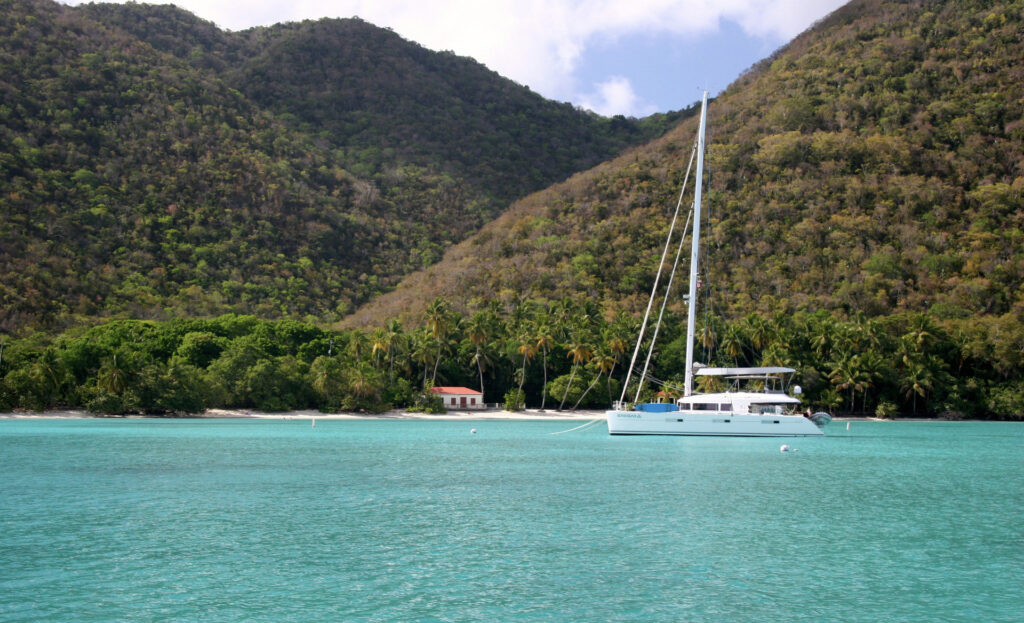
The Virgin Islands Professional Charter Association (VIPCA) have installed 200 moorings territory-wide in the popular cruising grounds of St. Thomas, St. John, and St. Croix. The moorings help protect the underwater habitats and interrelated ecological systems of coral reefs, seagrass beds, and algal plains from anchors and anchor chains.
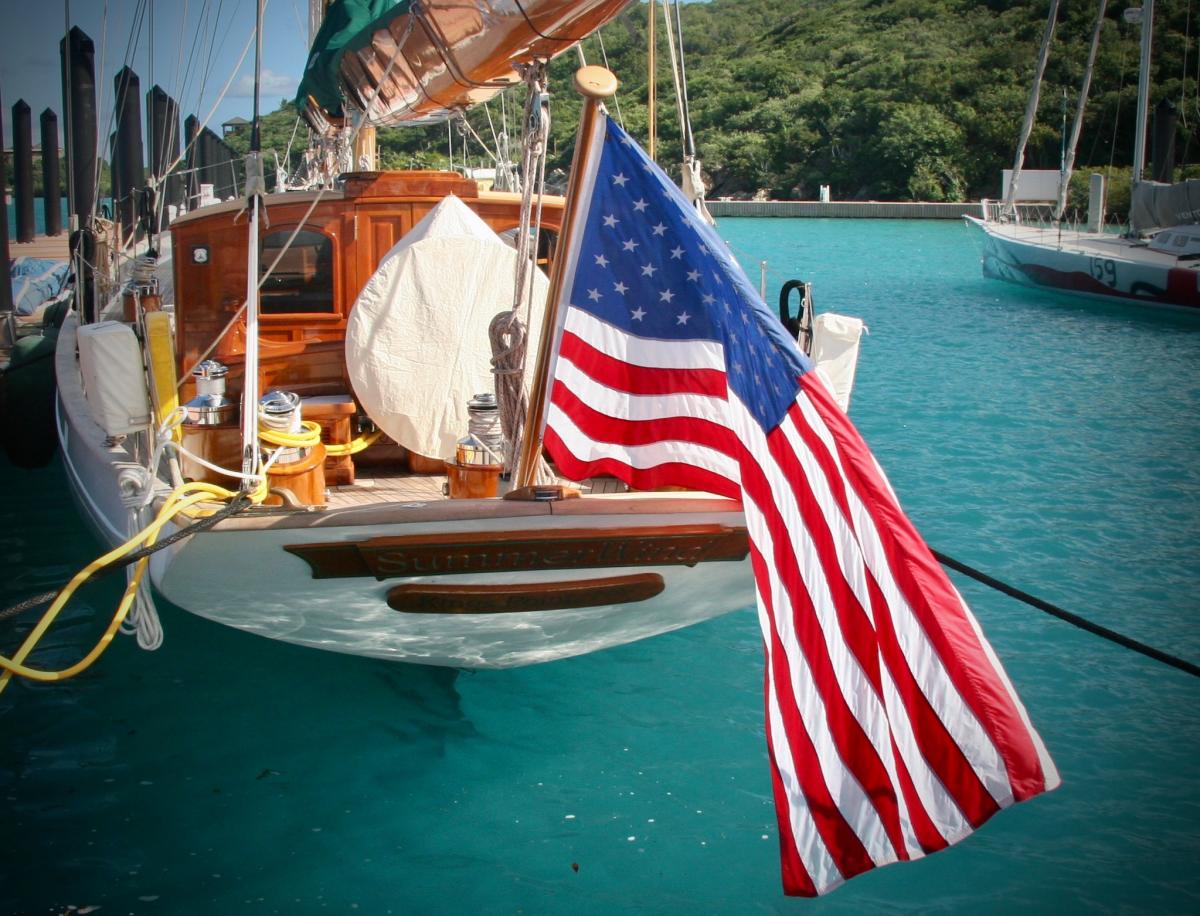
WHAT’S PAST IS PROLOGUE A seven-day sailing itinerary and a nod to history as the USVI gets its charter vibe back. The first time we …
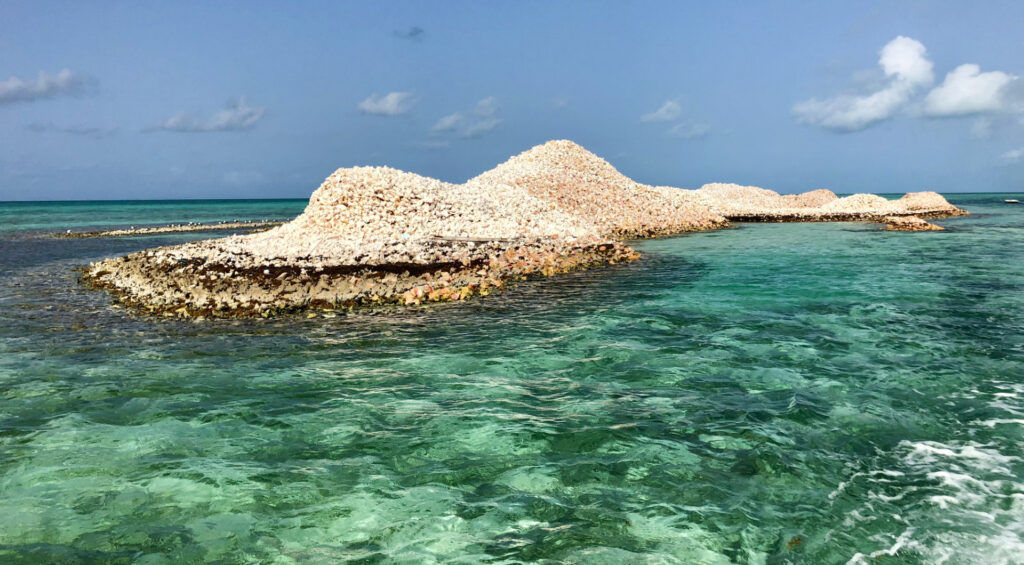
Located on the East end of Anegada, thousand of conch shells form a burial ground or conch mound. These conch burial grounds support the fact that the Arawak people lived on Anegada thousands of years ago. Since then, fisherman have discarded the shells here for more than 200 years…
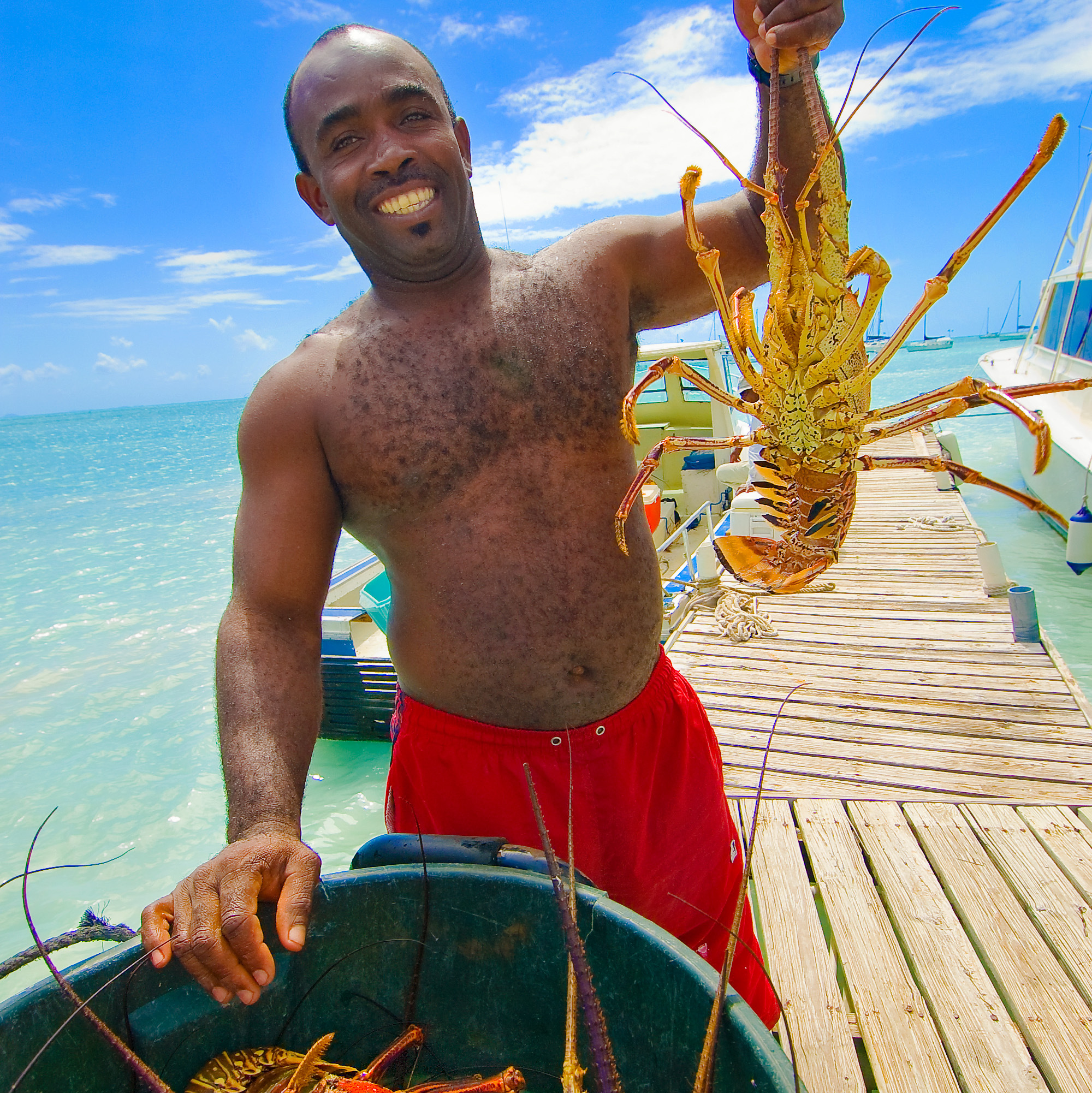
Exploring the Virgin Islands Part I: Sailing to Anegada
Cow Bones, Shipwrecks & Lobster at Sunset In contrast to the mountainous volcanic formation of the remainder of the Virgin Islands, Anegada is comprised …
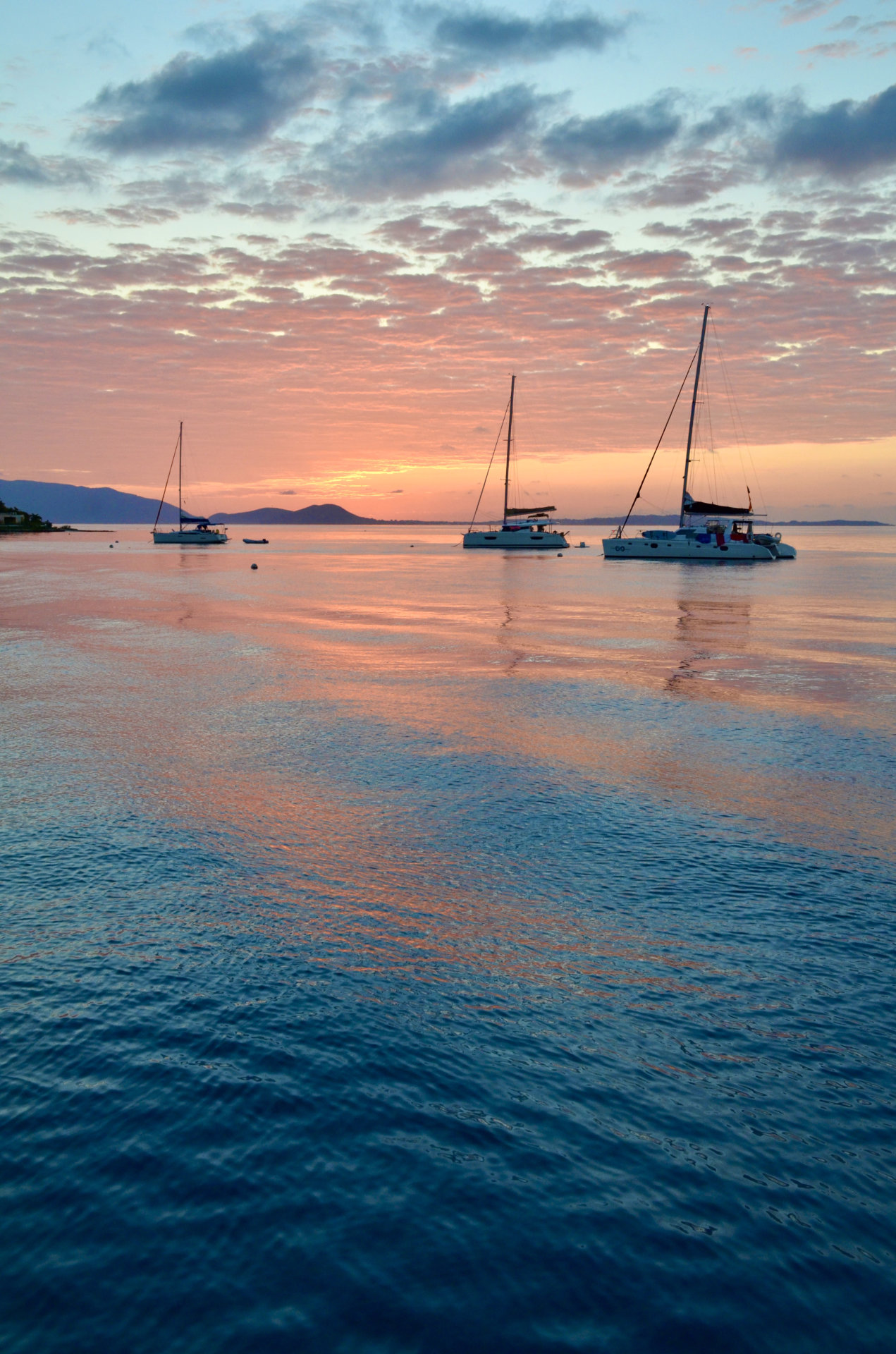
Dream. Explore. Adventure.
Our vision, here at Cruising Guide Publications, is to help sailors plan for and enjoy a safe and successful Caribbean cruise by providing the best tools and up-to-date information available on and about the various islands and anchorages of the Caribbean chain.
We have been writing guides for 42 years and strive to provide the best in class content delivered in an easy to read and understandable format, enabling the availability of the appropriate critical information when required for a safe and successful Caribbean cruise.
We remain mindful of the fragile ecology of the islands and endeavour to support local businesses in a sustainable environment for economic growth, while helping deliver a deeper appreciation for the culture and people of the Caribbean who are our island hosts as we embark on our sailing adventures of discovery.
Please note: global shipments are experiencing a postal delay of at least a couple weeks. Please see our list of European and Canadian distributors here . Dismiss

- Puget Sound
- The San Juan Islands
- The Gulf Islands
- The Sunshine Coast
- Desolation Sound
- The Broughtons
- The West Coast of Vancouver Island
- Voyage of the Dreamspeaker
- Coastal Magic DVD
- Cruising Guides
- Trip/Passage Planning Charts
- Original & Custom Charts
- Itineraries
- Dreamspeaker Flotillas
- The Dreamspeaker Team
- For Presentations etc.
| Sail & Power. Cruising Guides . Plus a F with Each Guide.
|
| Join Anne & Laurence and explore the Pacific Northwest. are a series of bestselling guides for both power boating and sailing in the Pacific Northwest. complement the guides and have proved to be a popular aid to cruise planning. take the hassle out of planning your trip with an itinerary tailored to your timeline and personal preferences. to enquire!
|
Click any region on the chart to start exploring!
Pacific northwest image gallery.
| Pacific Northwest Boating |
| Puget Sound |
| The San Juan Islands |
| The Gulf Islands - BC Sailing |
| The Sunshine Coast - BC Sailing |
| Desolation Sound - BC Sailing |
| The Broughtons - BC Sailing |
| The West Coast of Vancouver Island |
Become a friend of DREAMSPEAKER GUIDES
Sign up for downloads and to view Author Articles, Guide Updates, Trip Itineraries, and other Topics.

Boston sailing Center
Welcome to the bsc cruising guide..
An ongoing, collaborative project by Boston Sailing Center staff and members. Over time, we expect that it will grow into the most comprehensive and up-to-date guide for sailors on the coast of Massachusetts. The quality of the Guide depends on your contributions. If you have photos, good advice, local knowledge, or corrections, please use the comment form found at the bottom of each harbor page.
The Cruising Guide covers six popular cruising regions: Ipswich Bay, Cape Ann, Boston Harbor, Cape Cod Bay, Cape + Islands, and Buzzards Bay.

New England

Discover your new favorite harbor
This guide is brought to you by boston sailing center..
The Boston Sailing Center is a sailing school and club based out of Lewis Wharf in Boston’s historic North End.
- Ipswich Bay
- Boston Harbor
- Cape Cod Bay
- Cape + Islands
- Buzzards Bay
- Harbor Index
- Boston Sailing Center
- 617-227-4198
- [email protected]
- Bostonsailingcenter.com

- Find A School
- Certifications
- North U Sail Trim
- Inside Sailing with Peter Isler
- Docking Made Easy
- Study Quizzes
- Bite-sized Lessons
- Fun Quizzes
- Sailing Challenge

Secrets of Successful Cruising
By: Julie Cappelli Boat Shows , Cruising Tips
“What’s your secret sauce?” is a question I get asked frequently, and not just about the scrumptious creations I whip up in our galley, even in the lumpiest, bumpiest of seas. Usually, curious cruisers are wondering how our transition from being landlubbers to full-time sailors appears to be as smooth as the surface of the sea on your first morning in the doldrums. How did we buy the right boat? How did we take off across the Pacific a mere five months after buying said boat, with very few ripples in our plans, relationship, and lives? And my personal favorite, how the heck did my husband talk me into doing all this crazy cruising nonsense?
That last question is surprisingly the most straightforward to answer, so I’ll start there: my husband didn’t have to talk me into any of this crazy cruising nonsense. We reached the decision together and work hard to remain a team of co-captains rather than competitors trapped on a small sailing vessel with no escape from each other. To cruise successfully and harmoniously as a couple, you too must find balance between work and play, his and her passions, and safely navigate the different learning styles we all have. Which brings me to one of the most important secrets to successful cruising: men and women learn differently. And if you want to set sail for distant horizons, there is a lot of learning to do.
A good place to start is learning to sail, which shouldn’t be a secret but often seems like it is. To this day we credit our exceptional ASA 101 instructor for his relentless patience as we slowly learned the language of sailing, trying not to let the oppressive heat of the Arizona desert melt our brains or enthusiasm. Who knew there was a whole separate language, let alone code of conduct on the water to learn before we were competent enough to skipper a boat of our own?
Once you’ve learned the lingo and the basics of sailing, a great next step is purchasing a sailboat of your own. And I don’t mean the dream boat that you intend to sail away on, or even a racing dinghy. A little trailer sailor you can take out on the weekends or burn all your vacation time using will serve you much better in terms of preparing to voyage to far-flung places around the globe.

Your goal should be to learn this boat inside and out. We spent nearly two years sailing our 1976 Windrose 18, Moxie , nearly every weekend after we decided to go cruising but before we left our jobs. The quick responsiveness of a small, light boat helped us both hone our understanding of boat handling and sail trim without risking safety or sanity on a bigger boat where far greater forces are at play. Being able to take Moxie out whenever we pleased kept us engaged, motivated, and excited, even when our departure date felt forever away. Plus, you’ll earn boat ownership brownie points which could help you qualify for insurance on your next boat. Ladies, as soon as you are comfortable (or perhaps even a little before that), invite your best gal pals out for a spouse-less sail. There is no better way to build your confidence as a skipper which is essential to your success if you’ll be sailing shorthanded.
Can you fix everything on your boat with what’s in your brain and on your boat? If not, that’s your next step, and one of our greatest secrets to successful cruising: true self-sufficiency. When you are cruising in truly remote places or on an offshore passage, you are your own little island of existence in the deep blue sea. And there are responsibilities that come with that awesome reality; to yourself, to your crew, and to your boat. That’s why when you are out in the middle of the ocean your best and only resources are what’s in your brain and what’s on your boat. If you can’t fix or figure out anything that goes awry with the skills you’ve acquired or the resources you’ve stowed in the depths of your lockers, it’s highly likely that your cruise will be cut short and made more challenging by pressing maintenance needs.

It may seem counterintuitive, but investing in high-quality preparatory training is yet another secret that we find continues to pay dividends year after year. At a minimum, you should both take a sail repair workshop, sign up for a hands-on engine service workshop, and attend an electrical troubleshooting class. There simply is no substitute for hands-on learning on how to turn wrenches, properly crimp wire terminations, perfectly tension a halyard, or quickly grind in a reef. Pay close attention to the books and resources used so you can start building your onboard reference library. We find that couples who attend workshops and trainings together tend to enjoy doing boat maintenance more and are better equipped for success when it comes to repair projects. Attending events like these will also help you build your network of other like-minded soon-to-be cruisers, which becomes vitally important as your departure date draws near and the relative comfort of land life tightens its grip on your seafaring spirit.
Be sure to leave room on your calendar and in your budget to complete a liveaboard ocean sail training course that’s at least one week long. Choose an expedition-style course that teaches both traditional and electronic navigation and includes watch standing, sailing at night, and shorthanded man overboard retrieval. Many of our students wish they had prioritized this earlier in the process of preparing to go cruising, so schedule this well before you cast off the docklines for your grand adventure, and ideally before you purchase your cruising boat. It will give you a taste of what ocean voyaging is really like, help you build good boatkeeping habits, and you’ll start to learn what attributes you truly need versus want in your cruising boat.

Are you sensing a theme here? There is no better way to set yourself up for success than by spending time on boats fiddling with sail trim, enacting repairs, and learning how to cook your favorite meals in a galley that rarely stays still. You’ve got to get out there and just do it, but in an environment that allows room for growth and development. Make it your mission to return home with a solid foundation in ocean sailing and seamanship plus more salty souls to add to your cruising network.
You can’t go wrong by focusing on practical preparation, which is probably one of the best-kept secrets of cruising prep. The sooner and more often you work on becoming a self-reliant sailor, the better you will be equipped to tackle the challenges of extended cruising and boat ownership.

The timeless mantra of keeping it simple rings true for all successful long-term cruisers. Keep your boat and its systems as simple as you can. Endeavor to keep the remnants of your land life simple too, but always leave yourself a means to return when you need to. Whether it be budgeting for breaks ashore, maintaining a part-time residence you can return to, or just a nest egg reserved for when the time to plant roots again comes. It takes a lot of effort to achieve your cruising goals, and you deserve to enjoy the fruits of your hard work. Keeping it all simple and giving yourself an “out” will help you relax and appreciate the cruising life even more. Hopefully with a smile and frosty beverage in hand!
There are of course many more ingredients to create your personal recipe for successful cruising, such as identifying your individual cruising goals, selecting the right boat to match your agreed upon goals, and keeping the promise you made to yourself to actually GO.

We’ll be sharing loads more of our best secrets for successful cruising during our three-hour American Sailing Seminar at the Annapolis Boat Show on October 11 from 9am-12pm. Hope to see you there!
Learn From The Experts During This American Sailing Seminar
SECRETS OF SUCCESSFUL CRUISING
HOSTED BY GIO & JULIE CAPPELLI
Pelagic Blue Cruising Services, Owners
✓ Expert Sailors and Instructors
✓ Diverse Expertise

ANNAPOLIS, MD
FRI, OCT 11, 2024
For cruisers and aspiring cruisers intrigued by the secrets to setting sail with confidence and joy, this live seminar will address and navigate the challenges at sea, covering coastal and offshore passages, self-sufficiency in boat maintenance, and relationship dynamics with your crewmate(s).
Related Posts:

- Learn To Sail
- Mobile Apps
- Online Courses
- Upcoming Courses
- Sailor Resources
- ASA Log Book
- Bite Sized Lessons
- Knots Made Easy
- Catamaran Challenge
- Sailing Vacations
- Sailing Cruises
- Charter Resources
- International Proficiency Certificate
- Find A Charter
- All Articles
- Sailing Tips
- Sailing Terms
- Destinations
- Environmental
- Initiatives
- Instructor Resources
- Become An Instructor
- Become An ASA School
- Member / Instructor Login
- Affiliate Login
Roads Less Traveled
Are you dreaming of rv living or the sailing life we've been doing it since 2007 and we have lots of nomadic lifestyle tips and stories for you.

Tips for Cruising Mexico – Part 1 – Navigation, Weather, Gear & more

Primary Mexico cruising landmarks.
More info on Mexico Maps .

Groovy's solar panels on their arch support.

A few of the watermaker parts, not including the
high pressure pump, 75' of 3 different kinds of
hoses & two 4' membranes.
Tips for Cruising Mexico - Part 1
(This guide was adapted by the Baja-Haha Cruiser's Rally for their First-Timer's Guide to Mexico )
This page is a guide for cruisers that contains a huge collection of tips for Mexico cruising in your own boat. These are things we
wish we had known before we cast off the docklines. See our Tips for Cruising Mexico - Part 2 and Mexico Maps too.
If you are planning a cruise to Mexico, I hope this page will inspire you with new ideas for your preparations. They include:
• Mexican Culture
Adapting to living in a very foreign country
• Learning Spanish
The best course you can take before you go
• Navigation:
Related equipment and cruising guides
• Weather Prediction:
Methods and websites
• Tides and Lunar Calendar:
• Sailing in Mexico
Where the wind is -- and isn't -- and the best places to sail
• Boat Preparation:
Major upgrades for marina-based versus anchor-based living
Oddball items we have found very useful
MEXICAN CULTURE
All it takes is one provisioning run to realize that you're not in Kansas any more, and it can be quite a culture shock. Mexicans
are a wonderful, outgoing, friendly and exuberant people, and their warmth is infectious. But their traditions, ways of doing
things, history and ethnicity are very different than in the US and Canada.
We spent six months living on Groovy at Hotel Coral and Marina in Ensenada , and it was an awesome way to adapt to living
in Mexico while we still had wheels to drive back to San Diego. If you are planning to cruise to Mexico, I highly recommend
spending a few months in Ensenada as you outfit the boat, perhaps split your time between Hotel Coral and Cruiesport
Marina . Boatyard Baja Naval does outstanding work, and you be over your culture shock before heading south.
Ensenada is a terrific university town filled with activities and festivals of all kinds. From classical music concerts to art
exhibits to the Baja 500 and 1000 car and motorcycle races to the Newport-Ensenada sailboat race to tours of the
surrounding wine country to the Rosarito-Ensenada bike ride, to the very active running community , there are all kinds of
things to do. The bay is fantastic for daysailing -- the wind comes up most afternoons -- and you will be the only boat out there.
Some people have the misconception that Ensenada is not a "real" Mexican town. In our experience it is as Mexican as any
other, but is more varied, less touristy and has fewer gringos than most of the other coastal cities.
If you can't spend a few months living in Ensenada, a long weekend can help give you a feel for what to expect. There is a bus
line, ABC Bus (Spanish language website, prices in pesos) which runs between the Tijuana border and downtown Ensenada.
Take the trolley from San Diego to the border, walk over the border and catch the ABC bus to Ensenada and a cab from the bus
depot to your hotel. For a high-end treat weekend getaway, stay at Hotel Coral and Marina.
LEARNING SPANISH
One of the best things I did to prepare for cruising in Mexico was to take some conversational Spanish classes at my local
community college. I took three semesters and have found it has not only made it easier to get around and find things, but it
has enriched my time in Mexico. I have gradually reached a point where I can listen to the thoughts of these fine people in their
own language. Although three semesters taught me almost all the verb tenses and lots of vocabulary, learning to actually hold
a meaningful conversation is still an ongoing process for me. However, the conversation in which the pizza store guy in Loreto
explained the Mexican presidential election process to me, the day the canvas lady in San Carlos told me all the ups and downs
she has faced as a professional boat service person in a man's industry, and the time the fuel dock guy in Manzanillo told me
about the keys to enjoying a long marriage all stand out as true highlights of this crazy cruising experience. If you won't be
starting your cruise for a few years, sign up for a Spanish course today, and keep taking it until the day you leave.
Ensenada and La Paz both have immersion Spanish schools where four weeks of four-hour-a-day classes gives you a
semester's worth of conversational Spanish. ( Se Habla...La Paz ) is one of the schools). I'm sure there are others in the
mainland coastal cities as well. Click here for our Spanish Learning Tools page
I have met many cruisers trying to learn Spanish from courses on CD like Rosetta Stone. I haven't met anyone who learned
Spanish this way. Get serious, make the time, invest the money, and take some classes!
To see the funny things that happen to gringos living on sailboats in Mexico, see: What's it like to cruise Mexico?
Navigation in Mexico with a modern electronic chartplotter and radar overlay is a cinch. All the cruising guides give GPS
waypoints for major obstacles and anchorages. Sean Breeding and Heather Bansmer, authors of the popular Sea of Cortez: A
Cruising Guide and Pacific Mexico: A Cruising Guide, include a table at the end of each book that lists the suggested waypoints
with logically named labels and descriptions. Entering these waypoints into your chart plotter turns Mexico cruising into an easy
paint-by-numbers affair.
The survey data used to create the chartplotter charts (Navionics and others) is something like a century or more old, and
although the contours are usually correct, the data is often offset from the real GPS coordinates by as much as a mile or so.
Whenever we approach an unknown anchorage we turn on the radar to see how accurate the chartplotter is. 50% of the time it
is right on. The rest of the time it is usually just offset to one side or the other and it is easy to see where you should go and
what to avoid.
Note: we receive a 4-6% commission -- at no cost to you --
for purchases made through our Amazon links.
This helps us pay our out-of-pocket costs for this site.
If you buy something, let us know so we can say thanks!
Before setting out, we purchased Pat Rains' Mexico Boating Guide and Charlie's Charts of Mexico by Charles and Margo Wood
as well as the two books by Bansmer/Breeding. All four were useful, and we were glad to have each one on board, as they offer
different perspectives. Charlie's Charts reflects an earlier age of cruising but is completely up to date. Pat Rains gives down-
and-dirty practical advice. Bansmer/Breeding paints a vivid picture of what you will find in each anchorage. We relied on Rains
and Wood for the San Diego to Cabo passage. We used Rains, Wood and Bansmer/Breeding on the Pacific coast and used
Rains and Bansmer/Breeding in the Sea of Cortez.
WEATHER PREDICTION
We have found the weather in Mexico to be generally benign and the bad weather predictable well in advance. The worst
weather we have experienced has been while we were at anchor.
Our preferred method for weather prediction is the internet. We have had internet access from the boat at most locations,
relying primarily on our USB modem from TelCel (more on acquiring one of at Mexico Tips (2) ). On the trip south the only
place without internet via TelCel is Cedros Island. Once south, the only place where there is no internet access (and you really
could use it for weather forecasting) is from Islas Espiritu Santos north to just south of Ensenada Blanca (Bahía Candeleros) in
the Sea of Cortez and from north of Isla Coronado further north to Bahía Concepción also in the Sea of Cortez. These are both
long stretches of excellent cruising grounds, so after a few days at anchor when your downloaded weather data is out of date, it
becomes necessary to rely on SSB radio broadcast forecasts from amateur meteorologists (more about that below) or some
other method of obtaining weather information. If you can understand rapid-fire Spanish full of wave heights and wind speeds,
the port captains periodically broadcast weather forecasts on the VHF radio on channel 12 or 14 (they are announced first on
Channel 16 and come mid-morning and mid-afternoon).
The key to all the internet weather websites is to add 5 knots to the wind speeds and a few feet to the wave heights, especially
in the Sea of Cortez where predicted, pleasant sounding 15 knot winds may be 20 with gusts to 25, accompanied with short
steep waves -- not fun.
San Diego to Cabo San Lucas Passage Websites:
http://www.sailflow.com - Gives high resolution graphic images of the Pacific side of Baja that are are accurate if you
add 5 knots to the wind speed for good measure.
http://www.passageweather.com - There is a page for Baja California that shows the conditions on the Pacific side
of the Baja peninsula. The time is given in UTC (Greenwich Mean Time). Rather than worrying about time zones and
being exact, I simply subtract 6 hours to try to keep it simple and easy reading these charts, as the forecasts are given
for 3, 6, 9 and 12 am and pm. You really need to study each time-stamped chart carefully to figure out what conditions
http://www.wunderground.com/blog/Geary/show.html - From amateur SSB weather broadcaster Geary (see below),
this site gives 3-day forecasts for each major anchorage on the Pacific side of the Baja peninsula. The posts are
not always up to date.
Mainland Mexico weather websites:
http://www.passageweather.com - There is a page for California to Mexico that offer wind and wave forecasts.
Subtract 6 hours from UTC to get approximate local time.
http://www.passageweather.com/download.htm - The California to Mexico forecasts are available for download
if you have a slow internet connection. These are also useful to download if you are going to lose internet
access in the next few days.
http://www.magicseaweed.com - Offers wind and swell forecasts similar to passageweather.com.
http://www.weather.solmatesantiago.com/wxdata/Solmate Santiago Weather.html - Posted by amateur meteorologist
Stan from Manzanillo Bay, there are separate links for each region of Mexico including the Tehuantepec. The posts are not
always up to date.
http://www.sailflow.com - Gives high resolution graphic images for the Sea of Cortez that are accurate if you
Sea of Cortez weather websites:
http://www.bajainsider.com/weather/baja-weather108.htm - This gives a nice synopsis, including sea
temperature (SST tab), and there is a ton of other information about Baja elsewhere on the website.
Sea of Cortez to Mainland Crossing Websites
http://www.weather.solmatesantiago.com/wxdata/Mazatlan to Banderas Bay Forecast.html
- From Stan in Manzanillo Bay, forecast for crossing the Sea at different points.
http://www.wunderground.com/blog/Geary/show.html - From amateaur SSB weather broadcaster Geary (see below),
this site gives 3-day forecasts for the northern and southern crossings including the wind conditions on each side and in
the middle. The posts are not always up to date.
SSB Broadcasts
There are several amateur weather forecasters who give their predictions on various SSB radio nets. The two most popular
forecasters are Geary who is located in Bahía Concepción in the Sea of Cortez and broadcasts on the Sea of Cortez focused
Sonrisa Net, and Don Anderson who (used to) broadcast from Ventura California on the Mexico and Central America focused
Southbound Net and Amigo Net. Their volunteer work is extremely generous and they take their self-assigned jobs very
Geary's 3-day forecasts for the passages down the outside of the Baja peninsuala (San Diego to Cabo) and the two Sea of
Cortez crossings (north and south crossing) are all excellent. However, he does not offer a prediction beyond today for any of
the areas inside the Sea of Cortez.
He posts the broadcast on the internet as well (see above website listings). and he takes questions from listeners
about specific areas.
Due to time constraints on the air, there's necessarily a lot of generalizing, lumping many miles over many hours into a single
"15 knots NNW" kind of statement. When I have internet available, I find it much easier to look at pictures of the Sea of Cortez
or of Mainland Mexico showing wind speeds and directions in a graphical form to get an idea of what will be happening in my
particular little spot. Especially in the Sea of Cortez where the wind wraps around the towering mountains, changing its direction
and intensity with every mile it traverses, a single wind speed and direction forecast can't tell the whole story.
We also like to get a general weather prediction for the air temperature, humidity, sunshine and rain. We use:
http://www.weather.com
Other websites that can be useful:
http://www.grib.us - a free downloadable application that allows you to manipulate GRIB files. Windows only.
http://www.bouyweather.com - a subscription-based marine weather predictor.
http://www.predictwind.com - a subscription-based marine weather predictor
http://www.wunderground.com - a general weather forecasting website
http://www.ssec.wisc.edu/data/us_comp/us_comp.html - Gives a radar overview of the most recent conditions
http://www.atmo.arizona.edu/products/wximagery/usir.html - Gives a radar overview of the most recent conditions
TIDES & LUNAR CALENDAR
Tides generally run less than 6 feet in most of Pacific Mexico except in the far northern Sea of Cortez where they can be a lot
more (few cruisers venture to that area).
http://www.tide-forecast.com - Has a good graphic layout that shows where in the tide sequence you are right now.
http://www.tides4fishing.com/mx - An alternative tide forecasting site that includes solar/lunar and other info too.
It is nice to know how much moon you will have on an overnight crossing. This website detects where you are from your IP
address and generates a lunar calendar for the month. It also lets you put a red pinpoint on any location in the world and then
create a lunar calendar for the month:
http://www.kwathabeng.co.za/travel/moon/full-moon-calendar.html
SAILING IN MEXICO
The best sailing in Mexico is north of Cabo Corrientes: in the Sea of Cortez, in Banderas Bay (Puerto Vallarta area), and in the
"crossing zone" between Cabo San Lucas, La Paz, Mazatlan and Puerto Vallarta. South of Cabo Corrientes -- the Gold Coast
(Costa Alegre) and south to Zihuatanejo -- has very light wind and it tends to run parallel to the coast, making it either right on
the nose or dead astern as you sail between those anchorages. See our MAPS OF MEXICO page to get your bearings
We have sailed about half of the time that we have been in transit north of Cabo Corrientes and 10% of the time south of there.
This translates to somewhere around 5-10% of all the miles we have covered as the crow flies. In order to sail in Mexico you
have to be willing to tack, to sail dead downwind and to sail at 2 or 3 knots. Romping sailboat rides in 15 knot winds on flat seas
are not common, but they can be found. One of the best ways to do that kind of sailing is to daysail. Our favorite places for
daysailing have been Manzanillo Bay (south end of the Costa Alegre (Gold Coast)), Loreto Bay between Isla Carmen and the
Baja peninsula north of La Paz in the Sea of Cortez, Acapulco Bay, and the Bahías de Huatulco. Banderas Bay (Puerto
Vallarta) is reportedly another good spot. In any of these places you will likely be the only boat out daysailing.
Fishermen's "long lines," or nets, crop up in certain places. We have seen one in the Sea of Cortez, five or six in the Isla
Isabel / Mazatlan area, one south of the penal colony islands Islas Marias outside Banderas Bay, and one on the Gold Coast
south of Cabo Corrientes. They are marked by some kind of bouy at each end, and these end bouys are a few hundred yards
or a few miles apart. The two end bouys may have a flag on them and may have a second smaller bouy floating nearby.
Reports from people who have sailed into them are that you can cut them fairly easily with a knife.
The VHF radio is an experience unto itself in Mexican waters. The fishermen go crazy on channel 16, especially out at sea late
at night. They whoop and holler and whistle at each other. They hold the mic way too close and yell into it in very fast and
excited sounding Spanish. I asked a Bolivian cruiser what the heck they were saying, and he said he couldn't understand them
either and that they have their own jargon. Sometimes they hold the mic to their radio speakers and play songs on Channel 16.
Sometimes they make animal sounds and other weird noises. In between, the cruisers hail each other and the freighters and
cruise ships hail the port captains, all sounding very formal. The other day I heard a Mexican voice say in Spanish, "This
channel is for serious mariners, not animals." To which the reply was a loud chicken squawk and then silence. Channel 22 is
the channel cruisers use to hail each other when not underway, and many busy anchorages host morning nets on Channel 22.
BOAT PREPARATION
If you are outfitting a boat for cruising, I hope this section offers some food for thought and sparks some ideas. We have found
that it is easy to get caught up in a mindset of never-ending boat projects to the point where the projects overshadow the
cruising. Starting north of the border with a slew of upgrades., it is really tempting to continue taking on huge boat upgrade
projects in Mexico. In addition, things break, and suddenly The Boat turns into a 50-hour-a-week job with no time left for
sightseeing and enjoying Mexico itself. Soon frustration sets in. "When do the boat projects end and the cruising begin?" one
friend asked in me in jest, but not really joking. Here are some thoughts I've had about some of the most popular upgrades:
Solar Power and Watermaker -- Marina-based Living
If you are going to be in Mexico for just a season or two, and you have the budget to spend 50% or more of your time in
marinas, you may be best off skipping the watermaker and solar panels. These are two huge, complicated, expensive projects
that will only help you when you are anchored out, and in reality, how many nights will that be? For a lot of people the time
spent anchoring out is just a few weeks in the Sea of Cortez, a few days here and there between La Paz, Mazatlan and Puerto
Vallarta, and a few weeks on the Gold Coast. The $10-15K outlay for a watermaker and solar power/arch setup might be much
better spent at the swank resort marinas and on trips inland to Mexico's famous landmarks. Doesn't sitting in a hot tub or
visiting the extensive but distant Mayan ruins and dramatic landscapes sound better than overseeing a worker installing your
upgrades, or worse, doing it yourself?
If you stay at a marina for a few weeks and are then in transit for a week or two before settling into the next marina, a Yamaha
or Honda 2000 generator will keep the batteries happy on days you don't use your engine, and a large alternator will top them
off when you motor between anchorages. If you have good sized water tanks you can manage with onboard water from the last
marina stop.
Some of the happiest cruisers we've met are people who didn't install these expensive items. The water at the marinas is good.
If in doubt, you can always filter the water at the dock with a 1 micron filter and a carbon filter in series, or you can add a carbon
filter at a sink onboard. If you are fussy about drinking water it is easy to stock up with bottled water in gallon containers, as it is
carried in even the tiniest one-room stores.
US camping stores sell collapsible water jugs in 2.5 and 5 gallon sizes. Grab a few of these before you set out and you can
increase your on-board water supply without having to store the bottles on deck when they're empty.
Solar Power and Watermaker - Living on the Hook! For more on solar visit our SOLAR POWER pages.
On the other hand, if you are going to anchor out most of the time or are planning a longer cruise to places beyond Mexico that
don't have so many marinas, solar power and a watermaker are two awesome upgrades. For us it made sense to get the
biggest ones we could.
Our DC fridge and freezer eat up about 100-120 amp hours every 24 hours. Our 555 watts of solar panels tied to a 60 amp
MPPT charge controller is just barely sufficient in the winter if we keep the freezer running. If we run just the fridge but
keep the freezer turned off, we can live on solar power indefinitely.
On good sunny days we get anywhere from 150 amps in December/January to 230 amps in June/July. We need to run the
engine (with its 100 amp alternator) for a few hours every third or fourth day in the wintertime. This works out fine because that
is generally about the time we are ready to move on anyways.
We have met a lot of boats in Mexico that found they did not installed enough solar power before starting out and decided to
add more in Mexico. This isn't easy to do. So if you are considering putting solar power on your boat before starting your
cruise, get at least 500 watts, and more if possible.
The panels need to be installed so they are not shadowed and they need to be
wired in parallel. Ours are aft of the boom, but they often get a little shade when
the sun is on the beam or foreword of the beam. Lashing the boom off to one
side often helps. Unfortunately, if as little as 5% of a solar panel is shaded, it
quits working all together. If the panels are wired in series this knocks out the
whole solar panel array. I have seen this on our fifth wheel where our 490 watts
of solar (wired in series) went from producing 10 amps on an early winter
morning to producing 0.1 amp when I used my body to shade a corner of just
one of the four panels. Placing panels near or under radomes, wind generators
or the boom will make it very easy for shadows to creep onto one of the panels
and severely impair the system. Of course while sailing they often end up tilted
away from the sun as well as shaded by the sails.
Our engine-driven water maker is rated to produce 38 gallons per hour, but it
actually makes as much as 60 gallons per hour. In our research we discovered
that most DC watermakers require running the engine to keep the batteries at a
high enough voltage for the watermaker to operate well, so getting an engine driven unit that produces five times more water
made sense to us. It was the same price as the more popular DC
watermakers that produce 6-12 gallons per hour.
In our fifth wheel we use only 8 gallons of water per day, because obtaining
water when boondocking can be tricky. On the boat we use much more.
The salty, grubby marine environment requires lots of fresh water to keep
things clean. Mark attaches a hose to the watermaker's sample tube so we
can wash the decks while making water (although the water pressure
is light). Snorkeling gear and kayaking gear needs rinsing after use, and it
is nice to rinse off salty feet and salty bodies after swimming. We also have
fresh water flush toilets. We use about 20 to 30 gallons of water a day.
Because we are used to keeping our drinking water in gallon bottles in the
trailer rather than drinking from our holding tanks, we always make the last
bit of water into gallon jugs. This allows us to add minerals to the water,
since desalinated water doesn't have any minerals in it.
Anchor & Rode
In Mexico we have been able to anchor in 15 to 25 feet of water almost everywhere, and we put out 120' of chain regardless of
the depth because there is usually plenty of swinging room. When a Sea of Cortez Norther or Corumuel or Westerly blows in
we let out more chain, often as much as 250'. We thought it was a little crazy when we followed the advice of seasoned cruisers
and installed 300' of chain, but we're sure glad we have it now, as we have never dragged. Snorkeling over our 60 lb. Ultra
anchor (and Ultra flip swivel) we have seen a case where the boat pulled the chain in a 360 degree circle around the anchor,
and the anchor neatly cork-screwed into the sand. The chain's pattern on the sand was very pretty. I wish I'd had an
underwater camera to capture it!
These are some goodies we found extremely useful that are not usually on the list for outfitting cruising boats.
Shower Bags
Our hot water heater holds 11 gallons and relies on the engine to heat the water. After two days at anchor it's not hot any more.
If we run the engine to make water in the anchorage then the water gets heated up again and the batteries get topped off.
However, if we don't want to run the engine another option is to fill a camping solar shower bag with water, set it in the sun for a
few hours and then use it to take a shower. We tie the shower bag outside the bathroom window and run the nozzle through
the window to the shower. It's not quite as nice as the real shower nozzle, but it does the trick. The 2.5 gallon shower bags are
an easy size to deal with, and we can both get a shower from one bag. The 4 gallon bags are ungainly.
SSB Radio (portable)
The SSB radio is great for socializing on the SSB nets and, if your radio can transmit, the addition of a
Pactor modem also gives you email access while out of reach of Wifi or TelCel cell towers. However,
installing one is an expensive and complicated project, so we decided to forego it. Instead, we use a
portable, battery operated SSB receiver. Clipping a lead between the radio and a steel rod that comes
into the cabin from one of the inner shrouds is all we need to do to listen to the SSB cruiser nets. It took
us quite while to figure out which buttons to push to get the various frequencies, and the nets often change
frequencies slightly up or down if the official frequency is in use when the net is supposed to begin. SSB
broadcasts are full of beeps and blips and weird outerspace noises that make our fellow cruisers sound
like Martians. Ours is a Sangean ATS 909, but others are made by Grundig, Eton and Sony.
WiFi Booster
There are a lot of places in Mexico where you can get a free wifi signal on the boat, but you need a booster. We have a
Bitstorm BadBoy wifi antenna which has an RJ45 ethernet jack at the end that goes to the computer. This makes the wifi
signal onshore available to one computer on the boat. The manufacturer, Bitstorm, also sells their Unleashed product, a small
antenna which connects to this ethernet jack and then broadcasts wifi within the boat. This effectively makes the external wifi
signal onshore available to multiple computers on board via local wifi. When you turn on the BadBoy antenna it turns on the
Unleashed antenna at the same time, and all of it runs off DC power so there is no need to turn on an inverter.
GMRS Radios
One of the best things on our boat is two little GMRS walkie-talkie radios. These are rated for 36 miles, but they require line of
sight to achieve that distance. We have found they work over several miles with buildings in between. For instance, from West
Marine's parking lot on Shelter Island Drive all the way down to the Police Dock. We use them when anchoring, which makes
the whole process much less stressful and a lot more polite as we can discuss what's going on while Mark scopes out the
anchorage at the bow and I stand at the wheel. Hand signals are great but you can't really converse about whether this or that
spot might be better and why.
They are also very handy when one person goes to shore and the other stays on the boat. Most cruisers use a handheld VHF
for that purpose, but all VHF radio conversations are public, and I prefer our conversations not to be broadcast all over the
Shade Screen & Fans
If you will be cruising in the Sea of Cortez between May and October you will need a lot of shade in the
cockpit. There are many fancy ways to create shade screens, and lots of people use a mesh that keeps
out 75% to 90% of the UV rays. We chose screens that keep out 90% of the rays, and that was not
enough from June to early October. You need true shade at those times. A fancy solution is a sunbrella
flap that can connects to the bimini and comes down past the lifelines. A cheaper option is just to buy
some bedsheets and use clamps to clamp them onto the bimini and lifelines. These are easy to fold out of
the way and to wash. The biggest problem with shade screens is that the boat rotates, so you need
coverage around the entire cockpit or you will go nuts constantly moving the shade screens from one
place to another.
Some portable DC fans that can be taken into the cockpit or pointed at yourself wherever you are sitting really help too.
Caframo makes high quality DC fans, and they have a small 2-blade model that rotates. Perfect.
Super Siphon Hose
These plastic hoses have a check valve at one end, and they are ideal for transferring diesel or water from
jerry jugs into the boat's tanks. You put the open end of the hose into the tank and put the check valve
end into the jerry jug. Shake the check valve end of the hose up and down to coax the water into the
hose. Once the siphon starts, keep the open end of the hose at the bottom of the jug until it is empty. We
have one Super Siphon hose for water and another for diesel.
Electronic Spanish-English Dictionary
A small book dictionary will work too. The idea is to have something small that you can whip out at the
grocery store when you are staring at a label and have no idea what is inside the container -- is it whole
wheat or oats? Is it whole milk or skim? Is that price for the carrots or the zucchini? Etc., etc. Also, it is
handy for deciphering signs, billboards and newspaper headlines.
Swimmer's Towels (and boat cleaning towels)
These are highly absorbent towels that you rinse out after use and store damp in a plastic container. We
found swimmer's towels online, but they seem no different than the similar towels sold in auto parts stores and
the Walmart auto parts department for wiping down cars and boats. We have a few of each. We use the
swimmer's towels after swimming or after showering in the cockpit. This significantly reduces the number of
salty, wet terry cloth towels we have lying around. The boat cleaning towels are perfect for giving the boat a
sponge bath wipedown on dewey mornings.
Battery Operated LED Candles
We got four 3" candles at Bed Bath and Beyond, and they make the cabin very homey, especially since our
cabin lighting is fluorescent and LED. On overnight passages they make the cabin feel warm and secure.
We replaced all of our incandescent lamp bulbs with LED bulbs, and we replaced two overhead halogen
bulbs with LED bulbs. A good inexpensive source for LED bulbs is http://www.superbrightleds.com .
We got extra bulbs and we got a few in red so that on overnight passages we can switch a few of our lights
to red (although we don't generally bother to do that). Our overhead cockpit light has a red LED bulb, and
this is very handy for identifying our boat in a crowded anchorage when we come back to it in the dark.
We replaced our anchor and running lights with LED bulbs too, but those are specialty items we got
through the traditional marine stores.
We also installed two LED reading lights that have turned out to be really great. They cast a nice light that
is excellent for reading, and they don't have the harsh glare of most LED interior lights. We also put
several $4 battery operated stick-on LED lights in hanging lockers, under the sinks and in other poorly lit
Dive Tank Handles
Getting dive tanks refilled usually involves at least a long walk if not a dinghy ride, and the easiest way to haul around the
ungainly tanks is with a webbing and velcro strap handle. We found these simple handles make all the difference in the world.
Just make sure the dive shop knows the handles belong to you, or remove them before you leave the tanks if you have to leave
the tanks for a few hours or overnight, just so they don't disappear while at the shop.
This Tips for Mexico Cruisers guide is continued here: Tips for Cruising Mexico - Part 2
Volume 1 reviews the geography, weather and seasons in Mexico and shows you what the best anchorages between Ensenada and Manzanillo are like.
Volume 2 gives detailed info that can't be found in any of the guidebooks about the glorious cruising ground between Manzanillo and the Guatemala border.
Volume 3 (right) provides all the info you need to get off the boat for an adventure-filled trip to Oaxaca.
Curious about the price or specs for something similar to an item mentioned on this page? You might find it here:
New to this site? Visit our Home Page to learn more about us, and see our Intro for Cruisers to find out where we keep all the good stuff, including tips for planning your cruise to Mexico , our Solar Power pages, and our ideas for outfitting your boat.
- Search for: Search Button
- Latest Posts
- Solar Power Articles
- Battery Articles
- RV Vent-Free Heater
- Trailer Disc Brake Conversion
- Buying a Truck for Towing
- Buying a 5th Wheel for Full-time RVing
- 5th Wheel Hitch Installation
- Truck Engine Tuner
- 5th Wheel Suspension Overhaul
- RV Dump Station Tips
- Add RV Storage Space
- RV Tips & Tricks
- Travel Photography Tips
- Product Reviews
- Living & Working in an RV
- Going Full-time – Which RV?
- Full-time RV Lifestyle Tips
- What Is An RV Warranty?
- Finding Boondocking Sites
- Our Rigs…
- Cruising Mexico Video Series
- Planning Your Cruise…
- What to Expect on a Mexico Cruise…
- Our Cruising Blog Posts…
- Our Groovy Sailboat
- Massachusetts
- Mississippi
- New Hampshire
- North Carolina
- South Dakota
- National Parks
- Baja California Coast
- Northern Mainland Coast
- Southern Mainland Coast
- Sea of Cortez
- Mexico INLAND Destinations
- Canada Destinations
- Caribbean and Guatemala
- Thailand and Cambodia Travels
- Travel Itinerary & Route
- 10 Year Overview – Part 1
- 10 Year Overview – Part 2
- About Us & Contact
- Order from Amazon
- OUR GEAR STORE!!
Sailing Kist
- San Juan Islands
- Adventure Cruising Guides
- Gulf Islands
Welcome aboard Sailing KIST , we invite you to join us as we sail the cold, blue waters of the Pacific Northwest stretching from Washington State through British Columbia ending in the most wild Alaska! Here lies a secret paradise if you are willing to brave the rain and chilly days for breathtaking mountain ranges, sandy beaches, abundant wildlife, dense rain forests, thousand foot waterfalls, and so much more! With such a vast area untouched and unexplored by so many cruisers, we are eager to get out there and show you the wild beauty of the Pacific Northwest.
WHERE ARE WE?
Over the last few years, we have sailed KIST throughout the SAN JUAN ISLANDS, GULF ISLANDS, SUNSHINE COAST and DESOLATION SOUND!
This summer we are planning to sail around
VANCOUVER ISLAND!
Aboard our Frasier 41′ KIST , we (Lindsey and George) plan to dedicate the next few years to sailing and documenting our travels here in the PNW before shifting our sails south to sail the South Pacific. Our dream is to explore the places beyond our hook, beyond the beaten path, in search for adventure, local wildlife, and the culture that brings life to these islands. We hope to not only inspire others to sail the PNW but also to educate those who would love to learn how to sail, how to properly navigate the challenging environment of the pacific northwest, to become aware of the fragile ecosystems that thrive here and the animals that live within them, the geology of these islands (my favorite), and the culture that has built these communities! Our goal is to be able to someday publish an Adventure Cruising Guide to the Pacific Northwest that will be linked to a majority of our videos containing everything from the best anchorages to DIY projects to our own personal voyage ! So stay tuned!!!!!
Be sure to SUBSCRIBE to our YouTube channel: SAILING KIST
And FOLLOW us on Instagram @sailingkist
Norwegian Cruising Guide
The Recreational Mariner's Guide
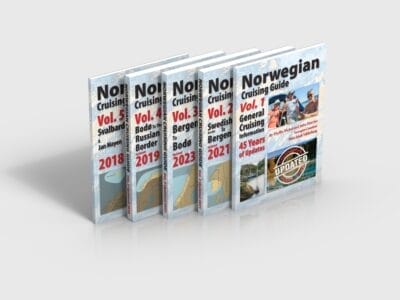
- The Original
- The Most Complete
- The Most Up-To-Date

Legendary cruiser, Steve Dashew
“The best cruising guide I have ever used”
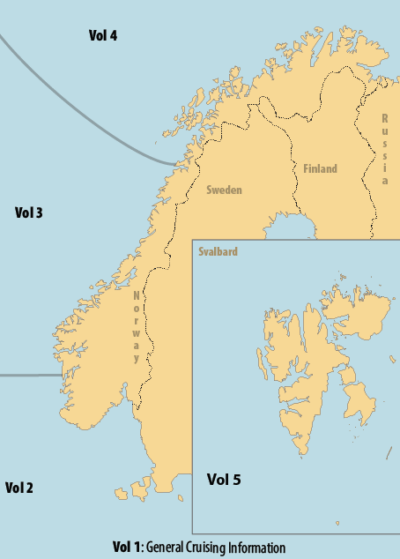
- Continuously updated since 1978
- Over 1000 pages (five volumes)
- Over 1000 ports and anchorages
- FREE online volume of general cruising information
- Three times more information than any competing guide to Norway
Paper or eBooks
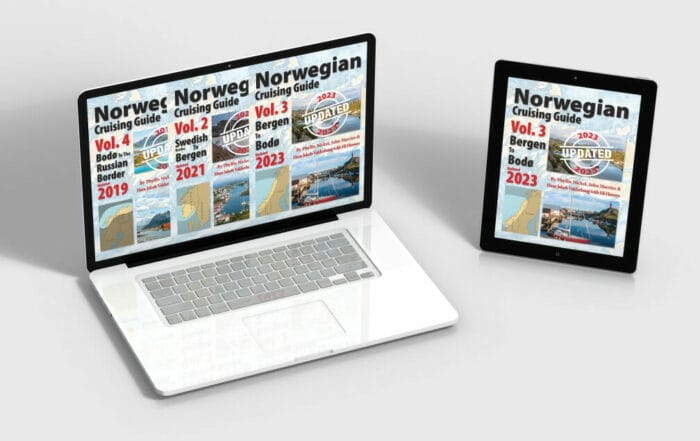
Free Waypoint File
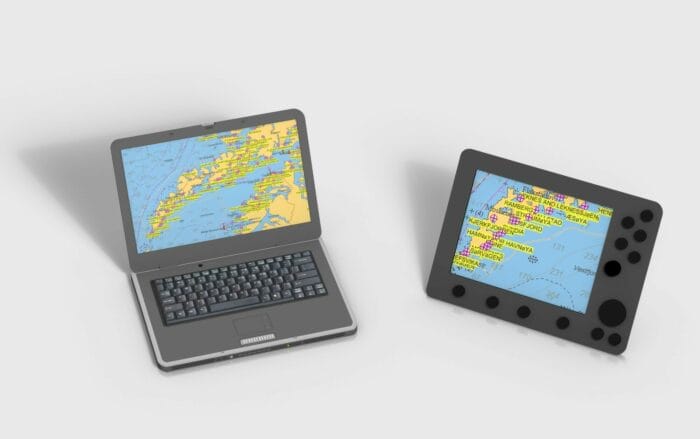
Authors & Publishers

Phyllis Nickel and John Harries. Over 40 years of offshore and high-latitude voyaging experience.
Norwegian Authors

Hans Jakob Valderhaug with Eli Husum. Over 40 years of cruising the Norwegian and Svalbard coasts.
Privacy Overview
| Cookie | Duration | Description |
|---|---|---|
| cookielawinfo-checkbox-advertisement | 1 year | Set by the GDPR Cookie Consent plugin, this cookie records the user consent for the cookies in the "Advertisement" category. |
| cookielawinfo-checkbox-analytics | 11 months | This cookie is set by GDPR Cookie Consent plugin. The cookie is used to store the user consent for the cookies in the category "Analytics". |
| cookielawinfo-checkbox-functional | 11 months | The cookie is set by GDPR cookie consent to record the user consent for the cookies in the category "Functional". |
| cookielawinfo-checkbox-necessary | 11 months | This cookie is set by GDPR Cookie Consent plugin. The cookies is used to store the user consent for the cookies in the category "Necessary". |
| cookielawinfo-checkbox-others | 11 months | This cookie is set by GDPR Cookie Consent plugin. The cookie is used to store the user consent for the cookies in the category "Other. |
| cookielawinfo-checkbox-performance | 11 months | This cookie is set by GDPR Cookie Consent plugin. The cookie is used to store the user consent for the cookies in the category "Performance". |
| CookieLawInfoConsent | 1 year | CookieYes sets this cookie to record the default button state of the corresponding category and the status of CCPA. It works only in coordination with the primary cookie. |
| viewed_cookie_policy | 11 months | The cookie is set by the GDPR Cookie Consent plugin and is used to store whether or not user has consented to the use of cookies. It does not store any personal data. |
| wpEmojiSettingsSupports | session | WordPress sets this cookie when a user interacts with emojis on a WordPress site. It helps determine if the user's browser can display emojis properly. |
| Cookie | Duration | Description |
|---|---|---|
| yt-player-headers-readable | never | The yt-player-headers-readable cookie is used by YouTube to store user preferences related to video playback and interface, enhancing the user's viewing experience. |
| yt-remote-cast-available | session | The yt-remote-cast-available cookie is used to store the user's preferences regarding whether casting is available on their YouTube video player. |
| yt-remote-cast-installed | session | The yt-remote-cast-installed cookie is used to store the user's video player preferences using embedded YouTube video. |
| yt-remote-connected-devices | never | YouTube sets this cookie to store the user's video preferences using embedded YouTube videos. |
| yt-remote-device-id | never | YouTube sets this cookie to store the user's video preferences using embedded YouTube videos. |
| yt-remote-fast-check-period | session | The yt-remote-fast-check-period cookie is used by YouTube to store the user's video player preferences for embedded YouTube videos. |
| yt-remote-session-app | session | The yt-remote-session-app cookie is used by YouTube to store user preferences and information about the interface of the embedded YouTube video player. |
| yt-remote-session-name | session | The yt-remote-session-name cookie is used by YouTube to store the user's video player preferences using embedded YouTube video. |
| ytidb::LAST_RESULT_ENTRY_KEY | never | The cookie ytidb::LAST_RESULT_ENTRY_KEY is used by YouTube to store the last search result entry that was clicked by the user. This information is used to improve the user experience by providing more relevant search results in the future. |
| Cookie | Duration | Description |
|---|---|---|
| _ga | 1 year 1 month 4 days | Google Analytics sets this cookie to calculate visitor, session and campaign data and track site usage for the site's analytics report. The cookie stores information anonymously and assigns a randomly generated number to recognise unique visitors. |
| _ga_* | 1 year 1 month 4 days | Google Analytics sets this cookie to store and count page views. |
| Cookie | Duration | Description |
|---|---|---|
| VISITOR_INFO1_LIVE | 6 months | YouTube sets this cookie to measure bandwidth, determining whether the user gets the new or old player interface. |
| VISITOR_PRIVACY_METADATA | 6 months | YouTube sets this cookie to store the user's cookie consent state for the current domain. |
| YSC | session | Youtube sets this cookie to track the views of embedded videos on Youtube pages. |

The Ultimate Guide to Choosing Between a Sailboat or Catamaran for Your Sailing Adventures
C hoosing between a sailboat and a catamaran for your sailing adventures is a significant decision that depends on various factors, including your sailing preferences, experience level, budget, and intended use. Here's an ultimate guide to help you make an informed decision:
1. Sailing Experience:
- Sailboats: Typically require more skill and experience to handle, especially in adverse weather conditions. Ideal for sailors who enjoy the traditional feel of sailing and are willing to invest time in learning and mastering the art.
- Catamarans: Easier to handle, making them suitable for beginners. The dual-hull design provides stability, reducing the learning curve for those new to sailing.
2. Space and Comfort:
- Sailboats: Generally have a narrower beam and less living space. However, some sailboats may offer comfortable cabins and amenities.
- Catamarans: Wider beam creates more living space. Catamarans often have multiple cabins, spacious saloons, and expansive deck areas, providing a more comfortable living experience.
3. Stability:
- Sailboats: Monohulls can heel (lean) while sailing, which some sailors enjoy for the thrill but can be discomforting for others.
- Catamarans: Greater stability due to the dual hulls, providing a more level sailing experience. Reduced heeling makes catamarans suitable for those prone to seasickness.
4. Performance:
- Sailboats: Known for their upwind performance and ability to sail close to the wind. Some sailors appreciate the challenge of optimizing sail trim for efficiency.
- Catamarans: Faster on a reach and downwind due to their wide beam. However, they may not point as high into the wind as monohulls.
- Sailboats: Typically have a deeper draft, limiting access to shallow anchorages and requiring deeper marina berths.
- Catamarans: Shallow draft allows access to shallower waters and secluded anchorages, providing more flexibility in cruising destinations.
- Sailboats: Generally more affordable upfront, with a wide range of options available to fit different budgets.
- Catamarans: Often more expensive upfront due to their size and design. However, maintenance costs may be comparable or even lower in some cases.
7. Mooring and Docking:
- Sailboats: Easier to find slips and moorings in marinas designed for monohulls.
- Catamarans: Require wider slips and may have limited availability in certain marinas, especially in crowded anchorages.
8. Intended Use:
- Sailboats: Ideal for traditional sailors who enjoy the art of sailing, racing enthusiasts, or those on a tighter budget.
- Catamarans: Suited for those prioritizing comfort, stability, and spacious living areas, especially for long-term cruising and chartering.
9. Resale Value:
- Sailboats: Generally have a more established resale market, with a wider range of buyers.
- Catamarans: Growing in popularity, and well-maintained catamarans often retain their value.
10. Personal Preference:
- Consider your personal preferences, the type of sailing you plan to do, and the kind of lifestyle you want aboard your vessel.
In conclusion, both sailboats and catamarans have their advantages and disadvantages. Your decision should be based on your individual preferences, experience level, budget, and intended use. If possible, charter both types of vessels to experience firsthand how they handle and to help make a more informed decision based on your own preferences and needs.
The post The Ultimate Guide to Choosing Between a Sailboat or Catamaran for Your Sailing Adventures appeared first on Things That Make People Go Aww .


Alaska cruise packing list: What to pack for a sailing up north

Packing for an Alaska cruise does not have to be a stressful experience. Yes, you will be visiting some places where the weather might be chillier than back home, but you will not encounter truly Arctic conditions. Away from the viewing sites of magnificent glaciers and icefields that brought you to Alaska, you might even encounter weather suitable for shorts and T-shirts.
If you're used to cruising around tropical islands, you'll find an Alaska cruise packing list is different from your Caribbean one. Spend some time learning about what you should pack for an Alaska cruise so you're prepared for the changeable weather and terrain of the 49th State.
For cruise news, reviews and tips, sign up for TPG's cruise newsletter .
What to pack for an Alaska cruise
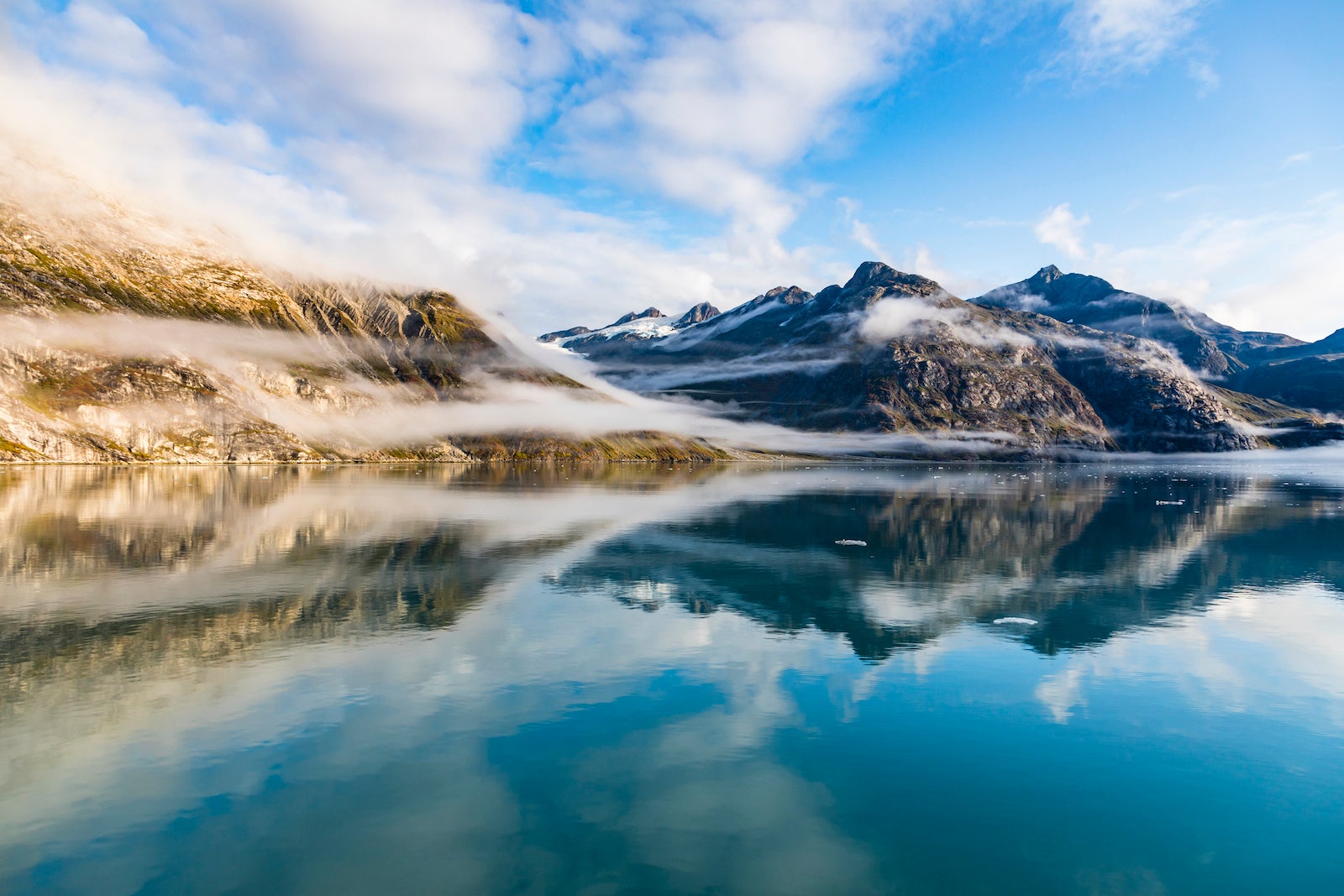
Alaska weather can be unpredictable and varies by elevation. In temperate Southeast Alaska, which is the main cruising area, summertime temperatures can be in the 30s (Fahrenheit) when you are close to glaciers, such as when cruising Glacier Bay National Park , Yakutat Bay (home to the gigantic Hubbard Glacier ) and College Fjord, but rise into the 60s or above in the fishing town of Ketchikan, the gold rush town of Skagway or Alaska's capital city of Juneau. Juneau can hit 80 degrees some days. Nights in these towns are cooler.
The key is to wear layers of clothes you can put on and peel off to help you deal with temperature fluctuations.
Warm and waterproof layers
Rain will likely be in the picture, particularly if you cruise during the popular months of July and August. (Want to avoid rain? Here's the best time to cruise Alaska .) Waterproof jackets and shoes or boots, umbrellas and hats will serve you well.
In April, you might encounter snow; anything goes in the fall. There is a reason you'll encounter many Alaskans throughout the year wearing waterproof Xtratuf boots, otherwise known as "the Alaskan sneaker." Warm parkas, gloves, hats and scarves will come in handy during early and late cruises, as well as when you're outside on deck watching glaciers calve.
Outdoor clothing
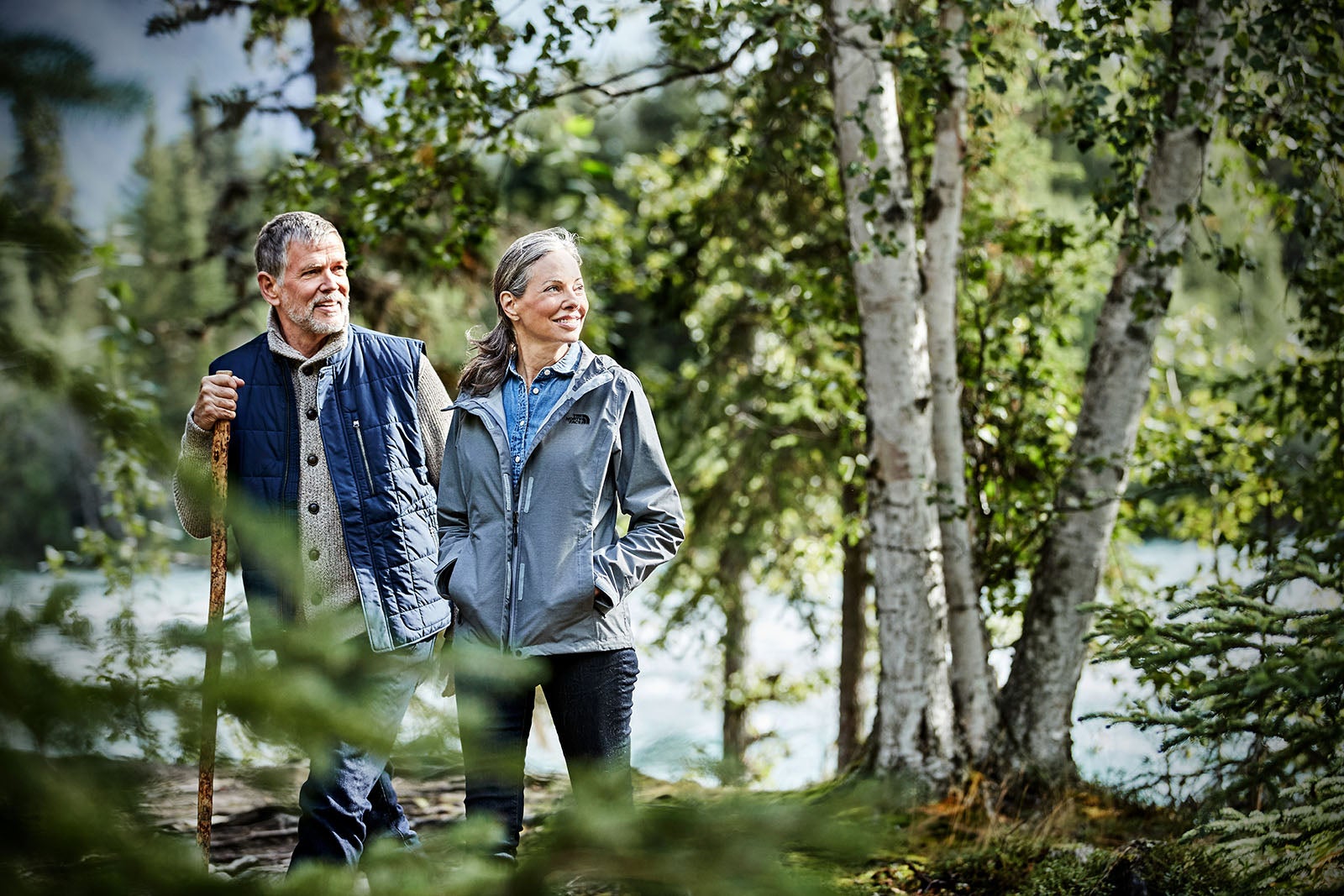
You should pack a variety of outdoor clothing options for an Alaska cruise. The good news is you probably have these things in your closet already: Think fleece jackets and vests, zip-off hiking pants and rugged footwear. If you're not planning any adventurous Alaska activities , you likely won't have to gear up in advance at a retailer such as REI, Dick's Sporting Goods or L.L.Bean or scour Amazon for the right gear.
Also, if you are doing a shore excursion in Alaska where you are likely to get cold or wet — such as a dog-sledding tour on top of a glacier (highly recommended) — the tour operator will provide specific, necessary gear, such as parkas, waterproof pants and boots. If you do a water activity such as kayaking, the operator will loan you waterproof gear.
Eveningwear
While casual is the order of the day on your ship, your cruise line might have specific suggestions for what to wear at night. Lines such as Princess Cruises and Holland America host both casual and dress-up nights.
Some lines take the always-casual approach to eveningwear in Alaska. Other cruise lines designate certain nights as informal, smart casual or "elegant chic," meaning you are expected to get slightly dressed up, such as a nice sweater or blouse for women or a sport coat for men.
Many cruisers enjoy capping dress-up at that. However, a few lines offer the opportunity for guests to gussy up even more for "formal" nights. Cunard Line , and to a lesser extent Holland America, are lines in Alaska where some passengers tend to relish dressing for dinner — even in some cases with suits and gowns. Itineraries longer than one week tend to attract more of the cocktail dress and tuxedo crowd.
If you don't want to get dressed up at all, you can dine in your ship's more casual eateries. Or, if your ship is doing a late-night stay in port, you might want to seek out the best place for king crab, wild Alaska salmon and other local delicacies on shore. Alaskans tend to dress for comfort at restaurants — even those with fancy menus.
Related: The 5 best luxury Alaska cruises you can book right now
Accessories and gear
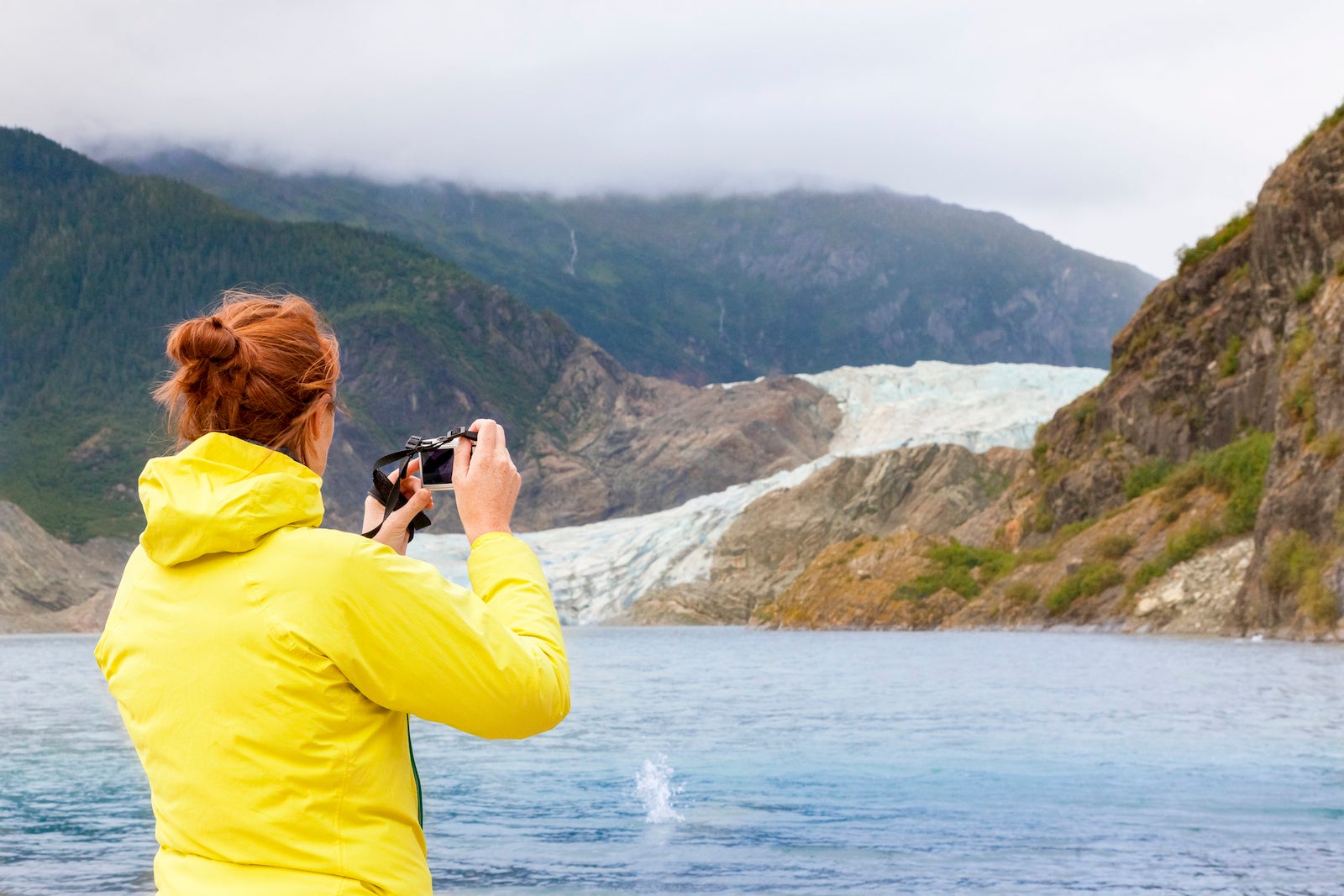
You don't have to pack for an Alaska cruise as if you are going camping, but it's important to bring the appropriate amount of adventure and travel gear .
A camera with a zoom lens or a cellphone that takes good quality photos is probably already on your list, but make sure you have chargers and enough memory for the hundreds of photos you will likely take. A portable charger is useful for full-day trips where you might burn through your cellphone battery.
Binoculars are essential. Your ship might stock some, but you'll want your own for spotting whales, bears, eagles and other wildlife and for close-up views of glacial ice and other wilderness from the ship and on shore. If you plan to do a lot of hiking, you might want to bring a retractable walking stick for uneven surfaces.
It might sound counterintuitive, but the sun shines brightly in Alaska, so don't forget sunscreen. You will also want bug spray since Alaska has a prolific mosquito population.
You'll likely encounter rain or take a water-based shore excursion on your trip up north, so bring a dry bag or dry pack to protect your equipment. For drier days, consider a day pack to stash any extra layers you're not wearing.
Pack your bag with packaged snacks brought from home. Cruise lines don't typically provide them, and they come in handy, especially if you are traveling with kids, on long train or bus tours.
Tips for taking the stress out of Alaska cruise packing
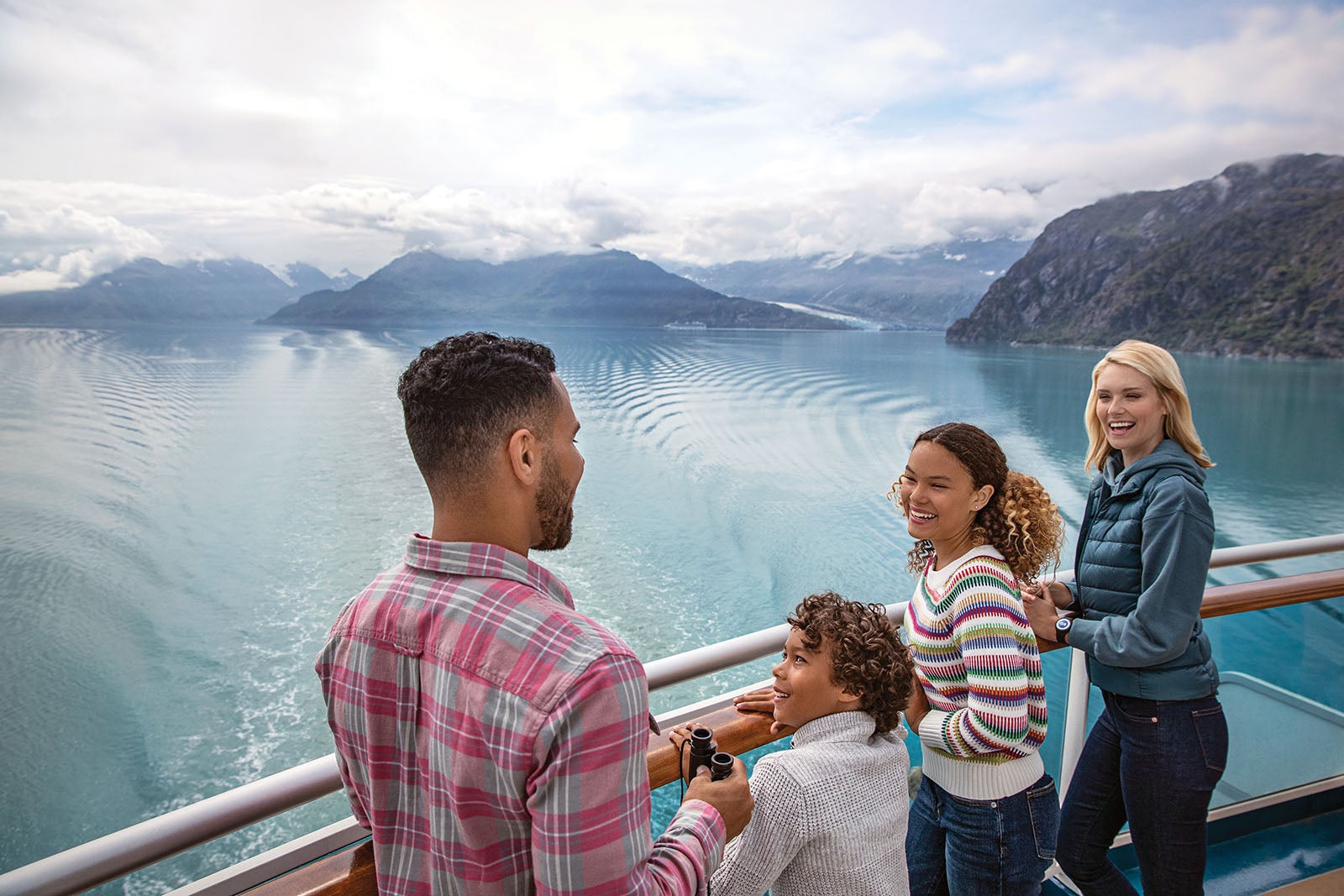
When packing, keep in mind that your ship might feature a self-serve, complimentary or coin-operated laundry room or offer send-out laundry and dry-cleaning service for a fee. This is particularly useful if you extend your cruise with a land tour (or cruisetour) in Alaska. You don't need to pack for the entire journey if you can wash your clothes during the trip.
If you forget to pack something, you can make purchases with U.S. dollars in the Alaska towns and cities you will visit. You'll find familiar brands at stores and pharmacies.
Related: Best Alaska cruise tips to help you make the most of your time aboard and ashore
Alaska cruise packing list
With all this in mind, here is a suggested packing list for your Alaska cruise vacation:
- A lightweight waterproof jacket or raincoat (not a parka or bulky winter jacket)
- Heavy sweaters, sweatshirts or fleeces (to layer under the jacket)
- A selection of T-shirts or other casual shirts (some long-sleeved)
- Two or three pairs of jeans, khakis or leggings
- A pair or two of good walking shoes that you don't mind getting wet or muddy (sneakers are OK, though if you are a big hiker, you might want to bring your waterproof hiking boots)
- A hat and gloves (for when your ship brings you close to the walls of a glacier)
- An umbrella
- Shorts (especially if you are the type of person who wears them in anything over 65 degrees)
- A swimsuit (for your ship's hot tubs, pools or waterslides; some small adventure ships might present the opportunity for a polar plunge)
- Sunglasses, sunscreen and a baseball hat or other sun hat (the long lingering midnight sun shines bright in Alaska, especially when reflected off ice)
- Bug spray (Alaska has a serious bug population that includes some 55 different kinds of mosquitos)
- An assortment of evening attire and footwear for dinner, based on your ship's suggestions (check your cruise line's website for details)
- Accessories (a belt, scarf or fun jewelry can transform a simple outfit so you can repurpose it)
- Gym clothes (if you plan to take classes or use your ship's fitness center)
- Toiletries and prescriptions (pack these in your carry-on)
- Underwear, pajamas and socks (including some thicker wool socks for hikes or treks into higher elevations)
- Your cellphone or camera, preferably with a zoom lens
- Chargers for all your electronics plus a multiplug extender so you can power up multiple devices at once
- A portable charger in case your cellphone runs low on an excursion
- A waterproof backpack or bag to protect your cellphone or camera and stash your extra layers and snacks
- An e-reader or books, games and cards, as Alaska cruises involve a few days at sea without port visits (look, too, for interesting selections at local Alaska bookstores or Alaska-themed novels, such as "The Great Alone" by Kristin Hannah, "Alaska" by James Michener or "The Snow Child" by Eowyn Ivey)
- Your own wine or Champagne (this can be a cost-saving move, but check your cruise line policy for how many bottles are allowed; corkage fees might apply)
Bottom line
Pack with a focus on versatility — and prepare for a wide range of temperatures and weather conditions — and you'll be all set for a cruise to Alaska. When in doubt, prioritize outdoor gear over formalwear. And remember: You'll be able to pick up in port most things you inadvertently forget to bring on your trip up north.
Planning an Alaska cruise? Start with these stories:
- 15 Alaska cruise mistakes you never want to make
- Everything you need to know about booking a trip to Alaska on points
- 8 of the best Alaskan lodges for getting close to glaciers, Denali and more
- The 9 best Alaska cruises for every type of traveler
- 6 best Alaska cruises for families
- One-way Alaska cruises vs. round-trip: Which is best?
- What to pack for a cruise
- 20 must-have cruise items — including a roll of duct tape
100th Port Huron-to Mackinac Island Sailboat Race draws large crowds

Every year John Lusk meets his friends near the Port Huron Yacht Club, setting up camp in the shade of the same tree to watch the parade of boats heading to the start of the Port Huron-to-Mackinac Island Sailboat Race.
It's a fun tradition among the friends, but every year it seemed there were a few less boats than in the previous race. That was, until this year when they sat down to watch the centennial race. The 100 year celebration seemed to breathe new life into the race, drawing more boats, more sailors and more onlookers.
"We were just talking about the number of boats and how it's a throwback to previous years," Lusk said.
Sailboats from across the country were gathered on the Black River Monday to participate in the 100th Port Huron-to-Mackinac Island Sailboat Race. According to the race's website, 316 teams were registered to compete in the centennial race, about 100 more than joined in 2023.
This year's race follows the original course created in 1925, which will take boats north along the shoreline before heading west, passing south of Bois Blanc Island and finishing west to east at the finish line between Round Island and Mackinac Island. This course is 204 nautical miles.
Kenneth Tanner, a Grosse Pointe resident joining the race as part of the California Girl's crew, said he was proud to join in the 100th race. He said he also sailed in the 100th Chicago-to-Mackinac Island Boat Race in 2008.
"It's a classic race, and to do this for the centennial race is an honor," Tanner said.
It's Bobby Bloomfield's first time participating in the race, though he has experience from other races. He joined the crew of the Siochail through an acquaintance who recommended him for the sailing team.
Bloomfield is working with one of the most experienced sailors in the race, Brian Geraghty. He's participated in the race every year it was run for 44 years and was the historian for the Bayview Yacht Club.
Geraghty said he accepted Bloomfield on the team because he's from Chatman, Ontario and likes the recruit Canadians to join the race.
Right next to the Siochail was the Contender. Scott Graham, who travelled from Florida to Port Huron to participate in the race said this year it is taking place on his 50th anniversary, so it's an uniquely special occasion.
"It's a hallmark race and it's special to be joining with my dad," Graham said.
The Contender won the M Class race in 2016, a feat they're hoping they can pull of a second time.
Down the river is another team looking to add a win under their belts, the crew of the Pirate. Captain Jeff Henderson, another Florida resident, has won the Class P Cruising race running the 1925 course nine times in almost 50 years of competing.
"Each year is better than the year before," Henderson said.
Each crew member wears a shirt with a pirate on the back saying "Give us the island and no one gets hurt," a cheeky reference to their destination in the race. Henderson said his boat brings a long history with it, having been built in France in 1992 (the crew is sure this is lucky because crew member Pierre Fleury is a French native) and that he bought it in the British Virgin Islands.
"The trick is to be lucky, and to have the right crew when it matters," Henderson said.
The race can be tracked online at https://bycmack.com/tracking/ .
Contact Johnathan Hogan at [email protected].
What’s the best Caribbean cruise for me?

Jul 15, 2024 • 9 min read

Whether you're a family of four or a solo adventure junkie, the Caribbean has a cruise for you. Walter Bibikow / Getty Images.
It feels like just about everyone is headed on a cruise ship, and for good reason. There’s a real appeal to embarking on a getaway where your travel plans are already sorted; you only have to unpack once and arrive each morning in an exciting port of call.
Plus, new ships are rolling out incredible bells and whistles that push the limits of fun at sea (think indoor skydiving, roller coasters, and go-karts). At the same time, the cruise industry has shifted towards sustainable efforts that have emerged as fundamental to modern cruising.
Recent statistics from CLIA (the official Cruise Line International Association) show an increase of nearly two million passengers in 2023 (totaling 31.7 million) compared to pre-pandemic numbers in 2019.
And there’s no more popular cruising region than the Caribbean , where upwards of 37 cruise lines with 154 ships rove the idyllic paradise of islands. With so many options, sorting out which ship and itinerary fits you best can be confusing.
Here’s a handy guide to help determine which cruises are best for you, along with tips and advice to ensure you’re setting yourself up for a smooth sail.

What Caribbean cruise is best for me?
Sailing for adventure.
Whether you're into ziplining through the rainforest, scuba diving one of the world’s largest coral reefs or swimming at the base of a waterfall, cruises throughout the Caribbean offer excellent opportunities for adventure.
Cruise ports known for high-octane activities include St-Martin (known for its superb scuba diving), Belize (cave-tubing and ziplining throughout rainforest treetops) and St Lucia (the Sapphire Falls Hike).
Celebrity Cruises, Princess Cruises and Holland America have cruises that frequent these ports.
Best ships for families
Look for larger ships with kid-friendly pools, expansive kids' clubs and family-friendly entertainment. Royal Caribbean’s fleet features action-packed decks great for families with water slides, laser tag and mini golf.
Disney Cruise Line’s fleet sails extensively throughout the Caribbean to ports that span from Cozumel , Mexico, to Willemstad , Curaçao. The line’s most common Caribbean offerings are shorter 3- and 4-night itineraries that are perfect for families looking for a short trip.
Cruise lines with private islands operate predominantly in the Bahamas , including Royal Caribbean, Disney Cruise Line and Norwegian Cruise Line. These stops are great family destinations as they feature enclosed, private environments with kids' activities and the ease of charging everything to your sea pass card.
Singles at sea
Cruises can be an excellent place for singles to mix and mingle. A standard cruise stateroom rate is usually calculated at a minimum two-adult rate. Singles wishing to book a standard stateroom are typically charged a single supplement fee ranging from 50% - 100% of their base fare.
As the demand for single cruise accommodations grows, new ship builds include solo staterooms, both interior and with balconies. Look to Celebrity Cruises, Virgin Voyages, and Norwegian Cruise Lines for some of the best accommodations for solo travelers.
Most relaxing getaways
The most relaxing cruises sailing through the Caribbean tend to be the smaller ships focusing on a more “resort at sea” vibe. The higher-end ships with all-inclusive rates offer the luxury of seamless vacations. Windstar, Seabourn and Viking are the best lines for a relaxing cruise.
On these ships you’ll find daily activities that swap dance parties and poolside games for fitness-oriented activities like yoga and strength training classes, lectures on upcoming ports and ample lounge chairs to soak up the sun by the pool.
From your first step onboard, all your food and drinks (except for certain vintage wines and spirits), activities and sometimes your port excursions are included in your rate.
Itineraries like the Viking Ocean Cruises’ West Indies Explorer sail a 10-day itinerary roundtrip from San Juan, Puerto Rico, with stops that include Tortola, British Virgin Islands; St. Kitts, Saint Kitts & Nevis and Roseau, Dominica. Rates for Viking Ocean Cruises include one shore excursion per port.

Best parties at sea
As the classic notion of cruising sunsets – goodbye white glove service, shuffleboard, Baked Alaska – a new era of fun is afloat.
Large ships are built to maximize fun, whether you're hopping pool parties, dancing the night away at late-night discos or cheering your team at rousing sports bars. Special interest cruises are also an excellent option for the most immersive fun at sea, whether that’s a full ship charter rock concert like the Rock Legends Cruise , a trip dedicated to Golden Girls fans , or an LGBTQ+ charter like VACAYA .
Favorite lines that feature an upbeat party vibe include Margaritaville at Sea (particularly on their new Islander), Virgin Voyages and Norwegian Cruise Line.
A quick getaway
You’ll find cruise lines are leaning into shorter itineraries that offer weekend getaways to nearby ports in the Caribbean. Most of these sailings are roundtrip from Florida’s top cruise ports: Miami , Fort Lauderdale and Orlando (Port Canaveral). These are often 3- and 4-night sailings featuring a stop in The Bahamas or Bermuda .
The vibe onboard is often more upbeat and celebratory, as guests do their best to maximize their limited time at sea.
A few favorite lines for this style of travel include Celebrity Cruises, Royal Caribbean (who is launching Utopia of the Seas this summer as its first-ever large-scale ship that will exclusively sail short getaways) and Disney Cruise Line.
An extended journey through the Caribbean
Smaller cruise lines offer longer, extensive itineraries throughout the Caribbean; smaller ships can port far off the beaten path at more remote destinations. Itineraries like Seabourn’s “25-Day Captivating Antillean Treasures” sail to some of the lesser trafficked parts of the Caribbean including Marigot, St. Martin; Carambola Beach, Saint Kitts and Nevis; and Sopers Hole (Frenchmans Cay), BVI. Lines like Silversea, Windstar Cruises and Azamara are favorites that route to these idyllic destinations.
When should I go on my cruise?
There are sailings throughout the Caribbean year-round, with high season running from November through April. This period is known for its optimal sailing conditions and weather.
You’ll find cheaper sailings during the hurricane season, typically July through September, though you risk the chance of your trip being canceled or rerouted to avoid inclement weather.
Holiday sailings (particularly during Thanksgiving, Christmas and New Year’s Eve) are also excellent times to sail as cruise lines curate impressive decor and holiday-themed activities.
How do I know if my cruise line is operating sustainably?
Conservation efforts have become a vital tenet of the future of cruising, with the industry gearing towards carbon-zero sailings by 2050 . Efforts underway include ship engines that run cleaner on alternative fuels, advanced wastewater systems that can better clean sewage water and exhaust gas cleaning systems to improve air quality at sea and in port.
Friends of the Earth’s Cruise Ship Report Card is a great resource to assess a ship’s sustainability efforts.
A few lines at the forefront of sustainable sailing include Ponant, Disney Cruise Line and Hurtigruten. Ponant recently became the first maritime cruise line to receive Green Globe certification, which recognizes the line’s commitment to reducing its environmental footprint. The line has shifted away from heavy fuel oil and installed catalytic systems to reduce atmospheric emissions.
Disney Cruise Line aims to operate with carbon emissions at net zero by 2030, in part by shifting to alternative fuels like liquefied natural gas (LNG) and hydrotreated vegetable oil.
Hurtigruten is currently developing a zero-emission propulsion ship, which is aiming to be unveiled by 2030.
There are still a large number of travelers who oppose the notion of cruise ships for not only their impact on the environment, but on local economies as well. Groups like Friends of the Earth , CLIA and Oceana are excellent organizations devoted to regulating the cruise industry.

Need to know before you go
Here are some helpful tips to keep in mind when you’re booking a Caribbean cruise.
Book in advance...
Cruise lines offer better rates further from your sailing date, often making sailings available to book more than a year out. The earlier you book, the better the selection of staterooms to choose from.
Or take advantage of last minute deals
Cruise Plum is our go-to with a comprehensive overview of discounted inventories if you're angling for a last-minute getaway.
Opt for third-party travel insurance for hurricane season protection
Travel insurance is the best way to ensure smooth sailings on your Caribbean cruise. Typical cruise insurance rates hover around 5 to 10% of your total trip cost.
Don’t just opt into the cruise line’s designated insurance option; shop around on a platform like Squaremouth for the most value.
Look for a plan specific to cruise travel, with coverage that includes compensation for delays, cancellations (particularly helpful during hurricane season), emergency medical, and the premium option of canceling for any reason (CFAR).
Be hurricane-aware
Hurricane season in the Caribbean is typically July through September. The outlook for the 2024 season from NOAA’s (National Oceanic and Atmospheric Administration) predicts an 85% chance of an above-normal season with the potential range of 8-13 hurricanes with winds of at least 74 mph.
Cruise lines work expeditiously to avoid sailing into the path of any major tropical storm or hurricane, often rerouting or shortening itineraries as threats arise. Cruises rarely encounter major storms as they’re able to chart the course of the weather and route accordingly.
In the event you encounter a major storm while at sea, head to the middle of the ship where you’ll feel the rolling of the ship less, take over-the-counter aids like Dramamine or Bonine and keep your eyes on the horizon for stability balance.
You don’t necessarily need a passport
Passports are not required for closed-loop sailings that begin and end at a US port. All you need is a boarding pass, a government photo ID (if you’re 16 years or older) and a certified birth certificate or certificate of US naturalization.
However, keep in mind that you might not be able to disembark the ship at certain ports (those ports include Barbados , Martinique and St-Barthélemy ).
Third-party excursions can be a better value play
If you want to stretch your dollar further, consider booking with local tour operators before arriving at each port. It’s important to note that third-party excursions are the best when they’re morning-only activities.
The ship won’t wait for you if you’re late returning from a third-party excursion. For full-day excursions, consider the line’s offerings, as the ship will wait for you, and there’s nothing worse than missing the boat.
Explore related stories

Walking Tour
Jul 18, 2024 • 3 min read
A vision of pastel with tropical flair, this photogenic route takes you by many of South Beach's most eye-catching Art Deco buildings.

Jul 17, 2024 • 7 min read

Jul 14, 2024 • 11 min read

Jun 29, 2024 • 8 min read

Jun 28, 2024 • 7 min read

Jun 26, 2024 • 7 min read

Jun 23, 2024 • 6 min read

Jun 21, 2024 • 5 min read

Jun 21, 2024 • 9 min read

Jun 20, 2024 • 8 min read

Electric boats
Electric boat.
- Flux Marine
- Scout Boats
Flux Marine unveils 100% electric center console boat with a hull from Scout and DC fast charging
Outboard motor and battery specialist Flux Marine has introduced a new center console boat package to its lineup to help further electrify the industry. The package combines Flux’s 100% electric propulsion system with a hull from Scout boats to deliver a vessel that can travel 30 mph and replenish on a DC fast charger.
Flux Marine is a company based in Bristol, Rhode Island that specializes in all-electric outboard motors and marine-grade batteries to power them. Additionally, Flux offers customers boat packages that implement its propulsion technology onto existing vessels.
To date, the company has unveiled an all-electric dual console boat option that includes a Scout Dorado 215 hull and a Rigid Inflatable Boat (RIB) package with the help of Highfield. Today, Flux Marine has announced a third entry in its new electric boat lineup, which once again includes a hull from Scout Boats.
Check out the Electric Scout 215 XSF.
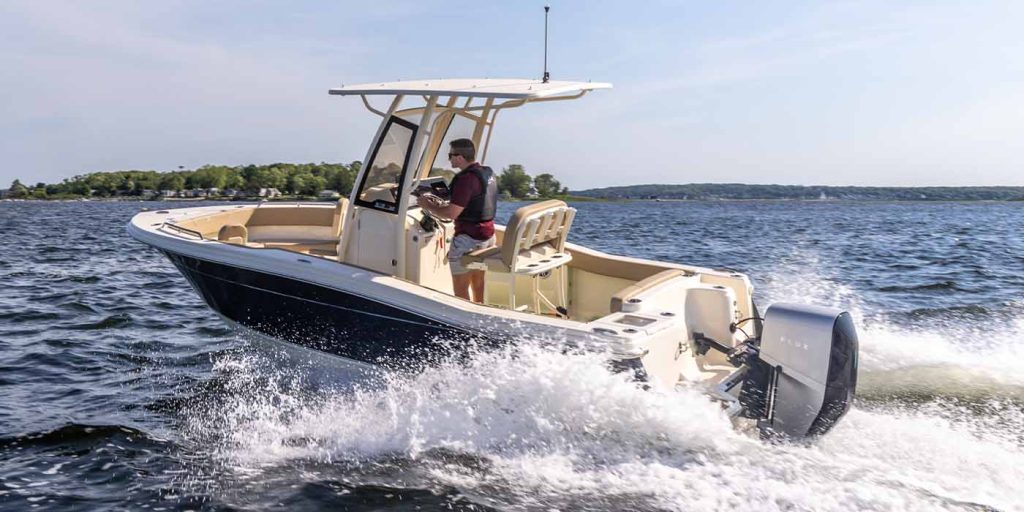
Flux to sell Scout 215 XSF electric boat later this year
Flux shared details of its new electric boat package today, which consists of a 21′ 6″ center console hull from Scout that is powered by its own electric outboard motor and a 84 kWh marine-grade lithium-ion battery pack.
The result is a 100% electric day boat with room for nine passengers designed for cruising and coastal fishing at sea. The Scout 215 XSF offers a top power output of 150 hp (112 kW) and 100 hp (72 kW) of continuous power. It can cruise at 25 mph, reach a top speed of 30 mph, and offer a top range of up to 30 miles (26 knots) at cruising speeds. Per Flux Marine CEO Ben Sorkin:
The idea behind Flux Marine is to provide a better, more efficient method of boat propulsion. Our 100 hp outboard hits the sweet spot, capable of propelling a 22 ft boat like the Scout XSF for almost any activity on the water. Our goal is to evoke excitement and innovation while ensuring users feel comfortable with what’s powering their boat.
A huge bonus in the all-electric Scout XSF center console boat is its ability to charge via AC or DC plugs when docked. Flux says the vessel can recharge from 20-80% in 7.5 hours on an AC plug (110-, 220-, or 240-volt) or as quickly as 1.5 hours using a DC fast charger.
In addition to the powertrain and battery pack, Flux has integrated the Scout boat with its own designed throttle, UI, and mobile companion app. Flux’s software will help future boat owners monitor and manage their speed and range from the helm, complete with live updates on an integrated Garmin chartplotter.
The all-electric Scout XSF center console boat starts at $120,000 and joins the Scout Dorado 215 and Highfield RIBs in the lineup. All are set to go on sale directly to consumers later this year.
FTC: We use income earning auto affiliate links. More.

Scooter Doll is a writer, designer and tech enthusiast born in Chicago and based on the West Coast. When he’s not offering the latest tech how tos or insights, he’s probably watching Chicago sports. Please send any tips or suggestions, or dog photos to him at [email protected]

Manage push notifications


IMAGES
VIDEO
COMMENTS
Either way, you'll find that they represent pure freedom; they're beguiling machines, sailing boats. Take the beauty below for instance, reaching between the islands in one of the world's favourite cruising grounds - the Windward & Leeward Islands of the Caribbean. A classic bluewater sailboat from the 1980's - 'Feather', a Hinckley Sou'wester 42.
Jeanneau's new 2022 Sun Odyssey 380 sail boat is a bluewater cruising capable vessel with a base price of $237,000 that is on a short list candidate for couples and families looking to escape onto the water for day sails or extended coastal cruising. Above: A 2022 Jeanneau Sun Odyssey 380 Sailboat. Photo by Jeanneau.
Island on the Edge: a life on Soay. Island on the Edge is a good read at a time when very many of us, even living on land, have needed to question our expectations. The author arrives on Soay by fishing boat upon which island she begins a transition to a new life from her earlier life as a graphic designer in London.
World Cruising Routes. World Cruising Routes is the go-to guidebook for long-distance navigators, cruisers, and sailors. It contains over 1,000 routes to destinations all over the globe rich with essential weather information, waypoints, and advice for safe passage making. "Some routes start as a dream and end as a nightmare.".
Waterway Guide Atlantic ICW, by Waterway Guide Media (updated annually). 2021 ICW Cruising Guide , by Bob423. Many cruisers swear by Bob423's frequently updated online guides and paperback books.
Sailboat Cruising. Whether you're looking for insights into the best cruising grounds of the East Coast, West Coast, Caribbean or Great Lakes, or the latest in tips and techniques for doing everything aboard from set the anchor to fix your engine, recover a man-overboard victim or trim your sails, our editors and contributors have the answers.
There are so many choices of cruising guides. There are numerous guides for sections of the trip, the San Juans, the Broughtons, the Secret Coast, and so on. But the guides that cover the most area with the most information are the "Exploring" books: Exploring the South Coast of B.C., Exploring the North Coast of B.C., and Exploring Southeast ...
May 19, 2024. Original: May 5, 2020. If you're a fan of quiet and unspoiled nature, you'll love exploring the Inside Passage. In a way, the Inside Passage is to the Pacific Northwest what the Intracoastal Waterway is to the East Coast—a protected waterway used by mariners to reach distant destinations. However, that's about where the ...
WORLDWIDE CRUISING GUIDES - TABLE OF CONTENTS. Free online Cruising Guides for yachts that are sailing around the world with information on world ports, ocean passages, country immigration and customs details, approaches, marinas, anchorages, and much more.
9 Best Used Sailboats They may take a little elbow grease and require a few new parts, but here's a look at nine of the best cruising sailboats that can sail ... Great choice!
Affordable Cruising Sailboats, Continued. Maine Cat 41 Used Boat Review. CS 30 Used Boat Review. ... • Cruising Guide Publications, 800/330-9542, www.cruisingguides.com • Embassy Guides, 888/839-5551, www.maptech.com • International Marine, 207/236-4837, www.internationalmarine.com
The winter of 2016-17 was one of the coldest on record in southern British Columbia. In June 2016 we had sailed across from Hawaii to Sitka in southeast Alaska aboard Distant Drummer, our Liberty 458.After enjoying a summer of leisurely cruising through the Inside Passage in Alaska and British Columbia, we reached Canoe Cove on Vancouver Island where we had decided to haul out for the winter.
Cruising World: 40 Best Sailboats Cruising World polled their readers to determine the best sailboats of all time. Check out the article to read more and learn how these were chosen.
View This Preferred Boating Destination In Our Explorer. The Waterway Guide Team has gained extensive boating knowledge over the years, and now we are sharing all of the tips, skills, and tools we've picked up along the way! Dock & Dine Your Way Through Maine. Embark on a culinary voyage along the scenic coast of Maine, where the Atlantic ...
Doyle Guides has been producing the region's most trusted and comprehensive sailing guides since 1980. Now, you can stay in the know with curated Caribbean sailing content straight to your inbox, including guide book content updates, local news, announcements, and exclusive offers. ... Cruising World Magazine, Feb 23 rd 2022, Lexi Fisher ...
FedEx, UPS, boat supplies, and many other helpful goods and services are available. Almost 400 cruising boats are often in its Elizabeth Harbour for the annual spring Cruising Regatta, a weeklong festival run by the cruising community in conjunction with the Bahamian community. Heading easterly from the Exumas you'll find more islands and variety.
Diamond Pass Publishing, Inc. 332 Woodford Street, Portland, ME, 04103, United States. [email protected]. Hours. Contact. ©Diamond Pass Publishing, Inc. 2017. A Cruising Guide to the Maine Coast: the definitive reference for exploring the Maine coast by boat.
Adventure. Our vision, here at Cruising Guide Publications, is to help sailors plan for and enjoy a safe and successful Caribbean cruise by providing the best tools and up-to-date information available on and about the various islands and anchorages of the Caribbean chain. We have been writing guides for 42 years and strive to provide the best ...
Discover the adventure of BC sailing with a detailed cruising guide with all the details and illustrations for a successful trip. Explore our BC sailing and cruising guides now for all the information you need to plan your unforgettable trip. Dreamspeaker Guides are the best selling series of cruising guides to the Pacific Northwest, the authors also organize group sailing Flotillas in British ...
Welcome to the BSC Cruising Guide. An ongoing, collaborative project by Boston Sailing Center staff and members. Over time, we expect that it will grow into the most comprehensive and up-to-date guide for sailors on the coast of Massachusetts. The quality of the Guide depends on your contributions. If you have photos, good advice, local ...
Join Julie Cappelli, of Pelagic Cruising Services, as she breaks down tips for mastering the secrets of successful cruising. Learn essential skills from sailing basics to self-sufficiency, and gain insights on boat selection and preparation. And don't miss the opportunity to hear directly from the author, transformed full-time sailor from landlubber, at the Annapolis Sailboat Show October 11 ...
A few of the watermaker parts, not including the. high pressure pump, 75' of 3 different kinds of. hoses & two 4' membranes. Tips for Cruising Mexico - Part 1. (This guide was adapted by the Baja-Haha Cruiser's Rally for their First-Timer's Guide to Mexico) This page is a guide for cruisers that contains a huge collection of tips for Mexico ...
OUR DREAM. Aboard our Frasier 41′ KIST, we (Lindsey and George) plan to dedicate the next few years to sailing and documenting our travels here in the PNW before shifting our sails south to sail the South Pacific. Our dream is to explore the places beyond our hook, beyond the beaten path, in search for adventure, local wildlife, and the ...
Legendary cruiser, Steve Dashew. "The best cruising guide I have ever used". Continuously updated since 1978. Over 1000 pages (five volumes) Over 1000 ports and anchorages. FREE online volume of general cruising information. Three ...
Choosing between a sailboat and a catamaran for your sailing adventures is a significant decision that depends on various factors, including your sailing preferences, experience level, budget, and ...
In temperate Southeast Alaska, which is the main cruising area, summertime temperatures can be in the 30s (Fahrenheit) when you are close to glaciers, such as when cruising Glacier Bay National Park, Yakutat Bay (home to the gigantic Hubbard Glacier) and College Fjord, but rise into the 60s or above in the fishing town of Ketchikan, the gold ...
Sailboats from across the country were gathered on the Black River Monday to participate in the 100th Port Huron-to-Mackinac Island Sailboat Race. ... has won the Class P Cruising race running the ...
At the same time, the cruise industry has shifted towards sustainable efforts that have emerged as fundamental to modern cruising. Recent statistics from CLIA (the official Cruise Line International Association) show an increase of nearly two million passengers in 2023 (totaling 31.7 million) compared to pre-pandemic numbers in 2019.
Overview. Come along with us and have a wonderful private experience, cruising along the beautiful coastline of Ponta da Piedade in Lagos. Visit the emblematic rock formations, fantastic beaches, little coves and sea caves of the amazing Ponta da Piedade, recognized worldwide for their unique features.
The result is a 100% electric day boat with room for nine passengers designed for cruising and coastal fishing at sea. The Scout 215 XSF offers a top power output of 150 hp (112 kW) and 100 hp (72 ...